January 29 - February 4 2023: Issue 569
Hy-Brasil, Avalon Beach: An Alexander Stewart Jolly hand-Built Home
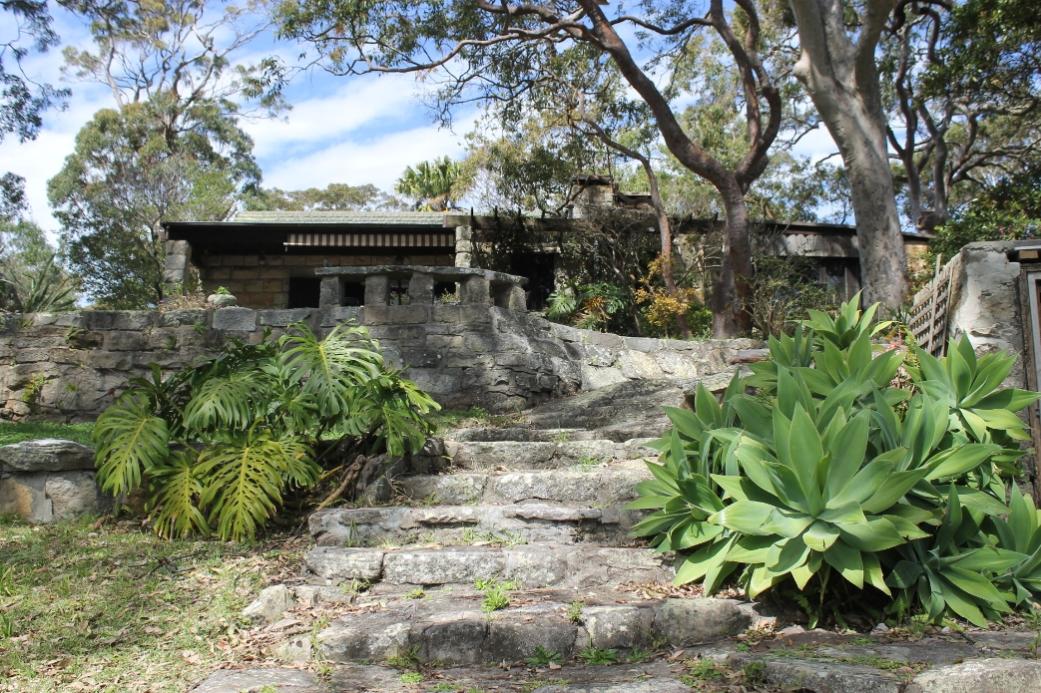
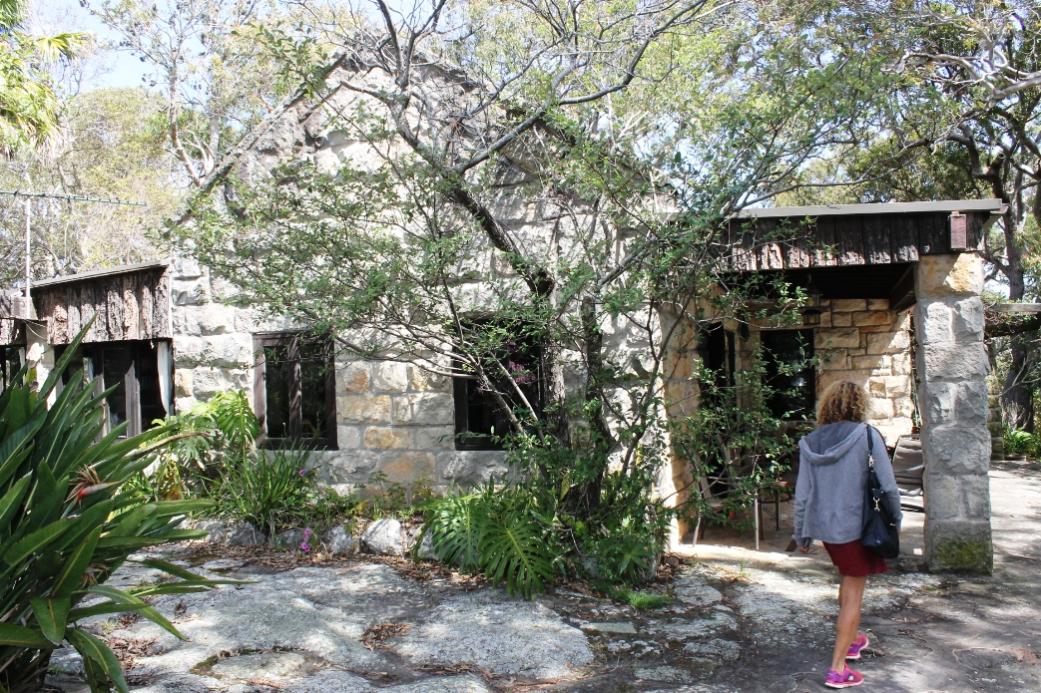
If the heat and humidity has been a bit much for you this Summer dream of being in a place that catches all those breezes and is made from local sandstone - a stone known to be cool during hot months and cosy, once heated, during cold months.
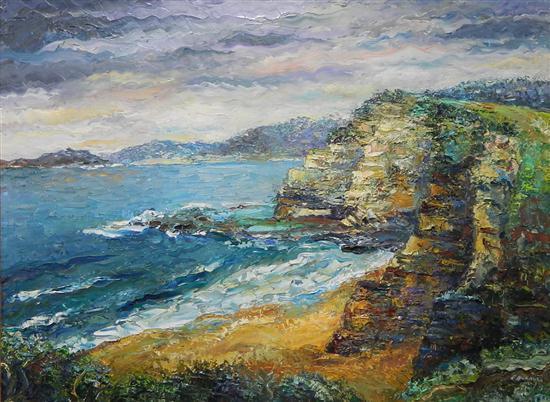
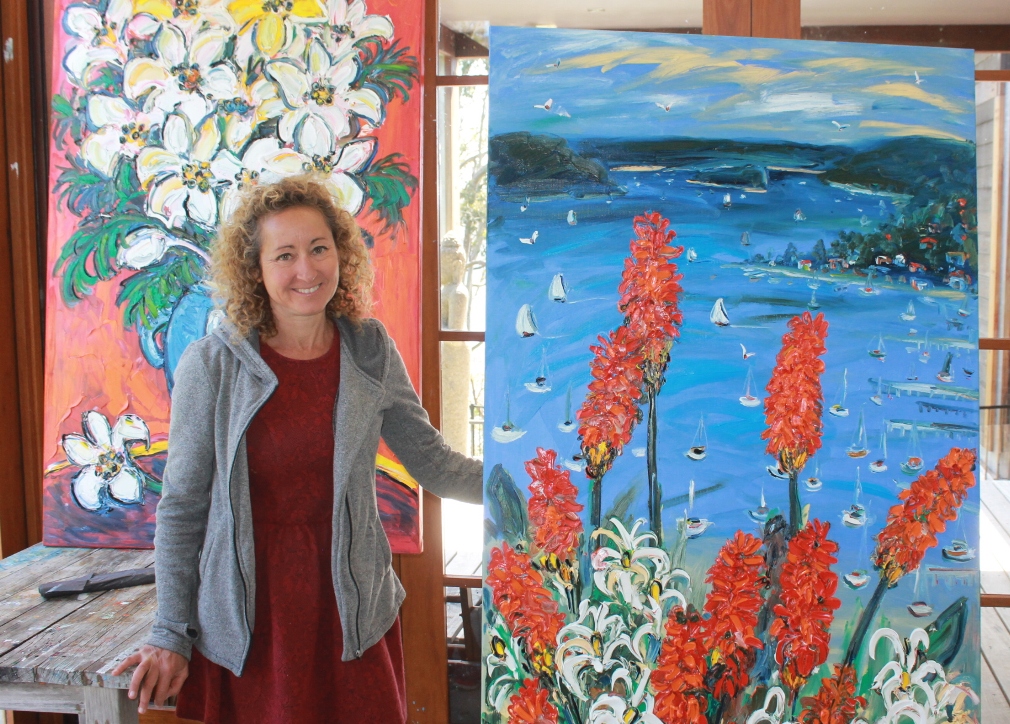
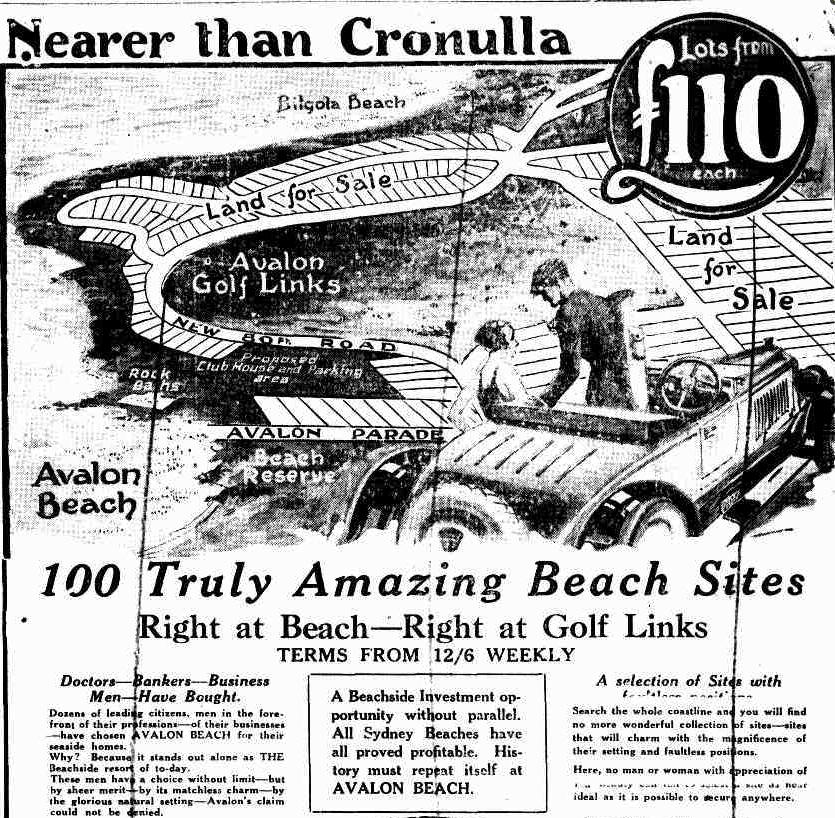
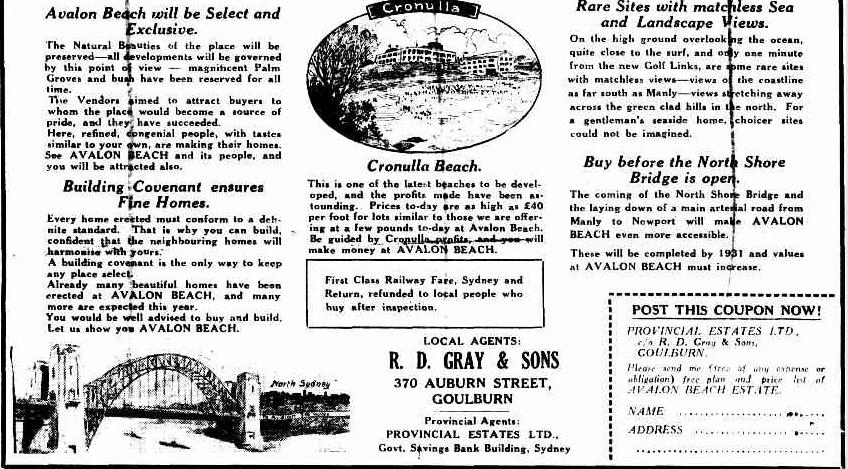
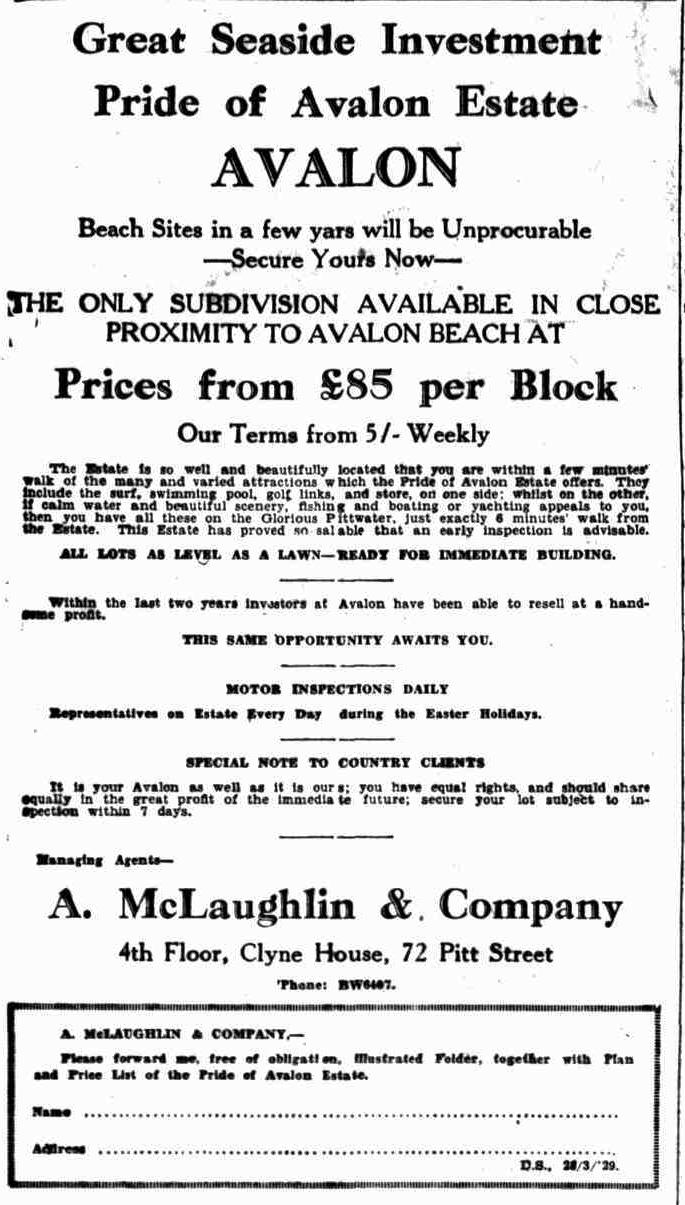
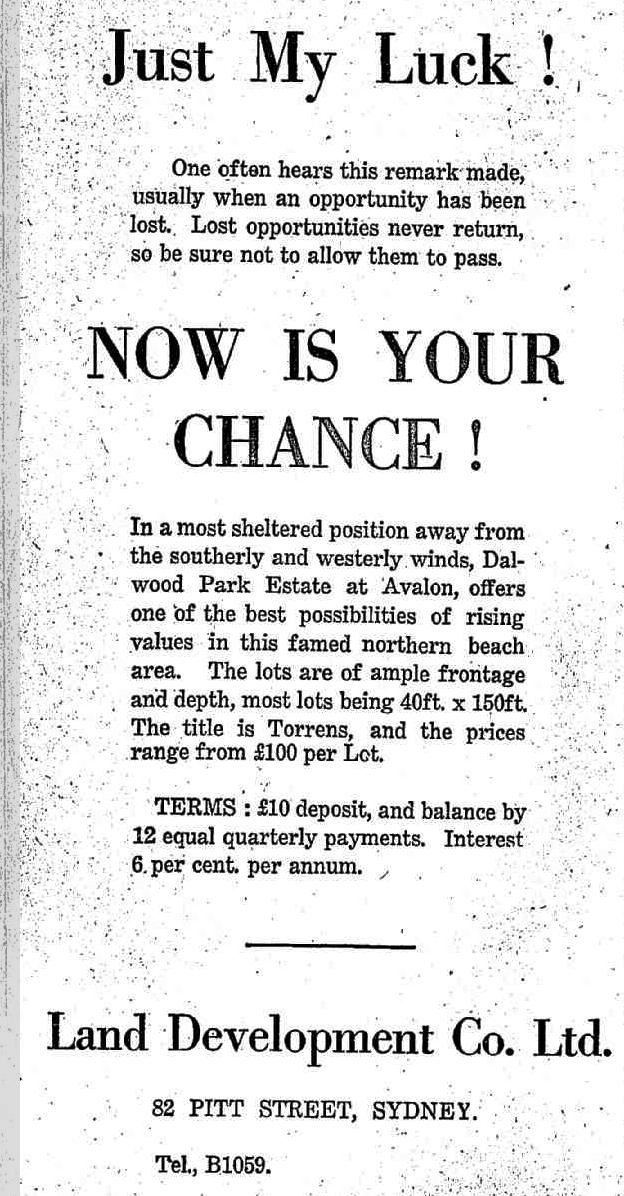
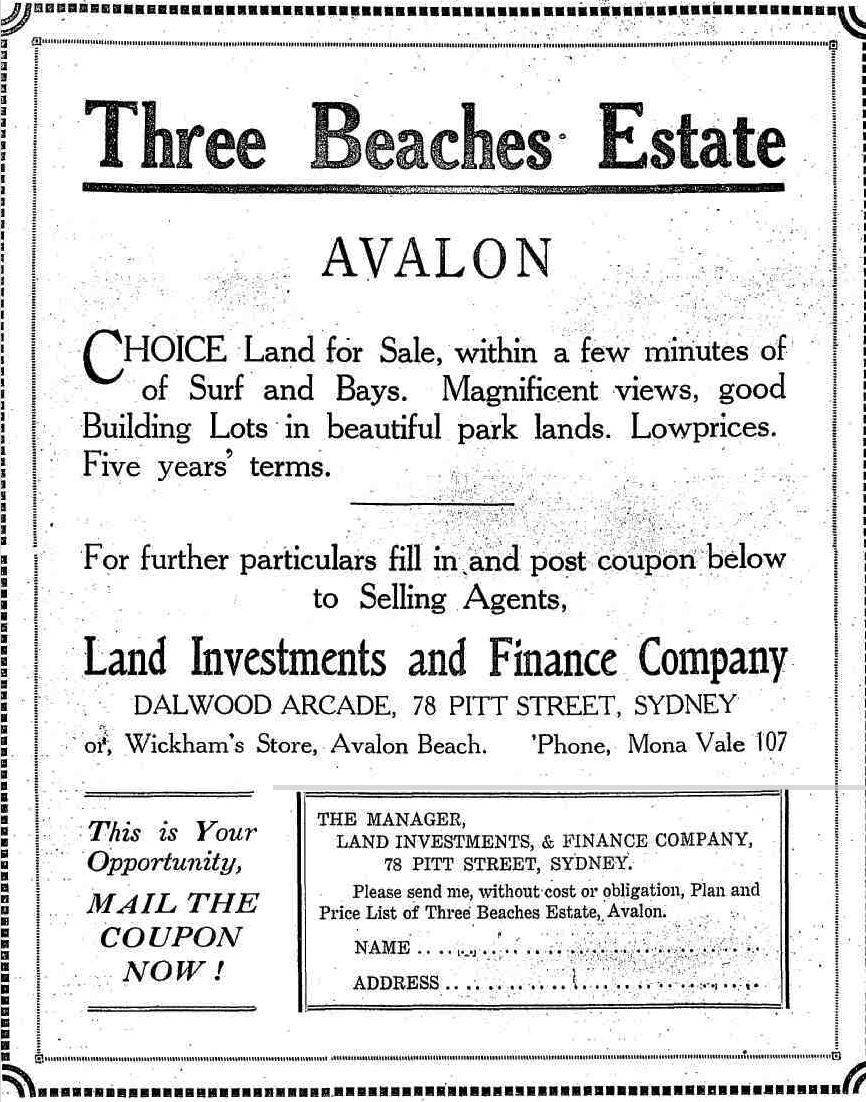
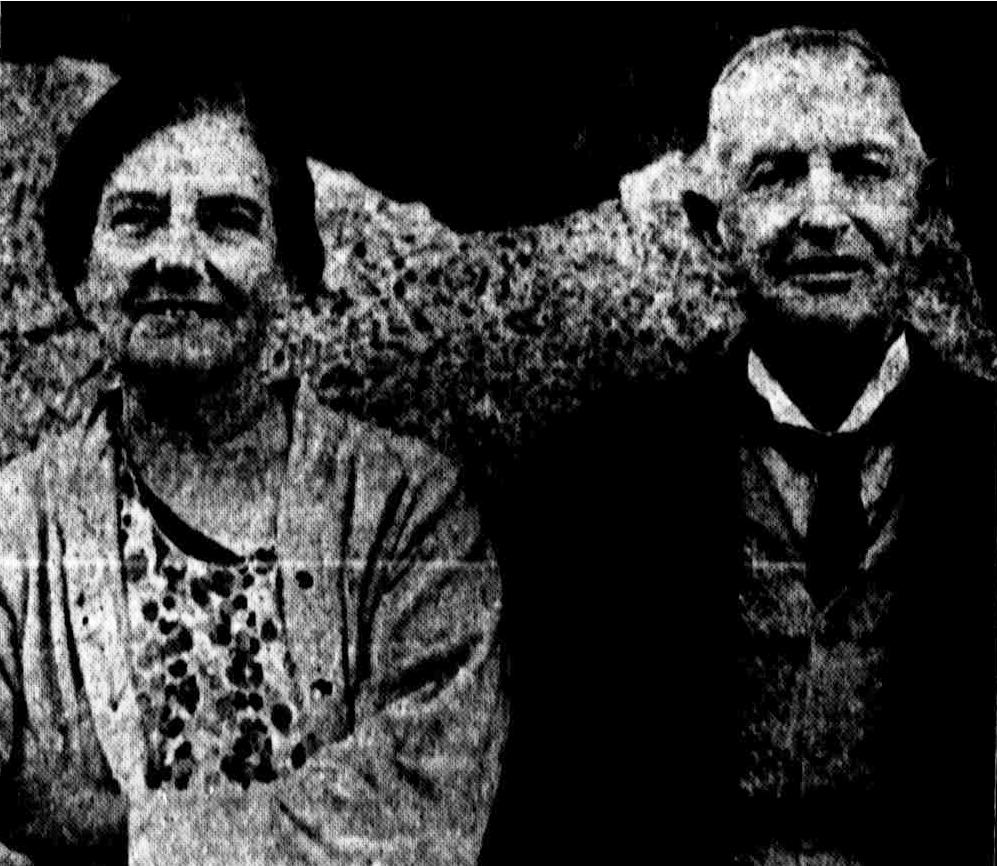
%20of%20Nada%20Hermann%20and%20Hy%20Brasil%20Artist%20and%20Summer%20Houses%20095.jpg?timestamp=1516233337096)
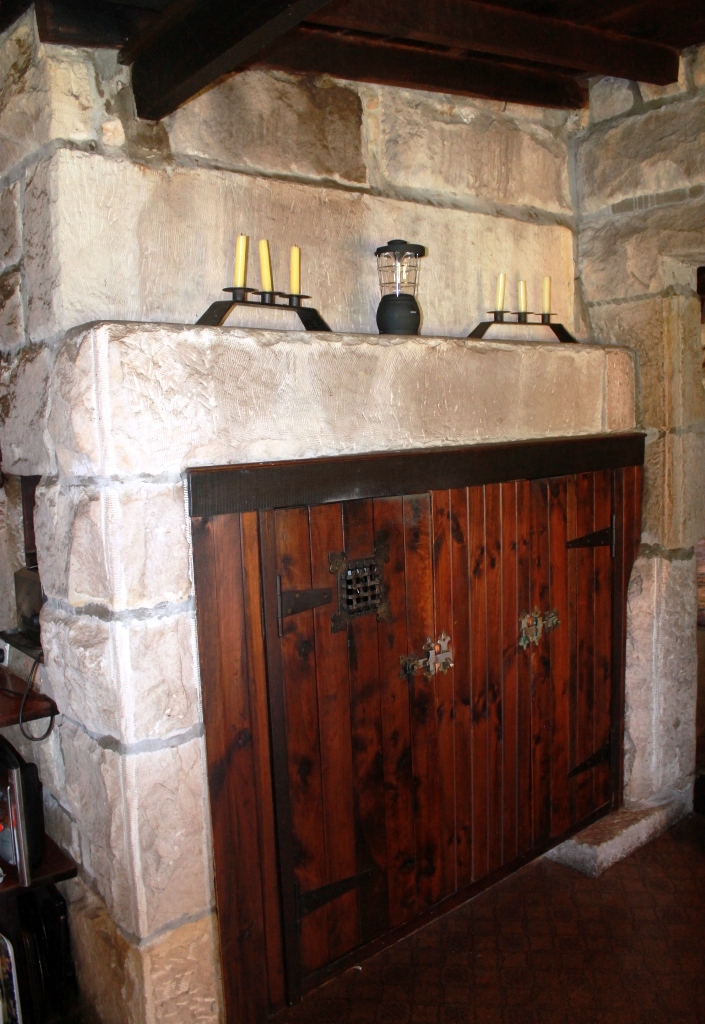
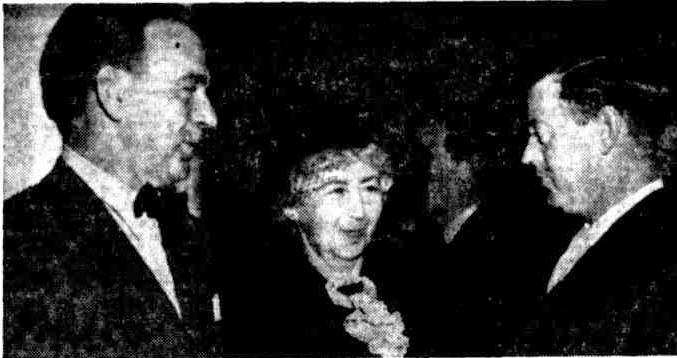
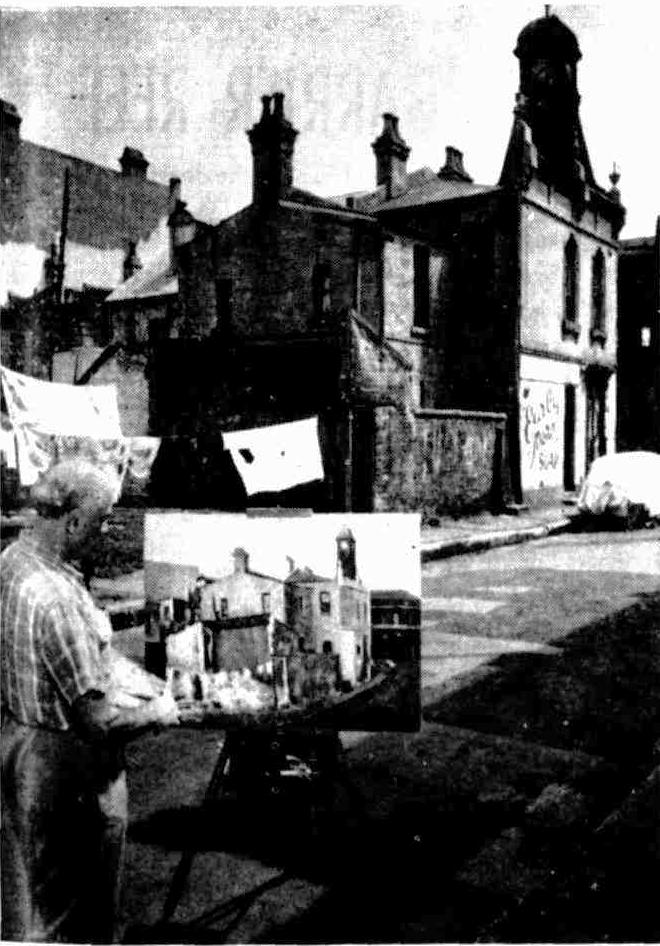
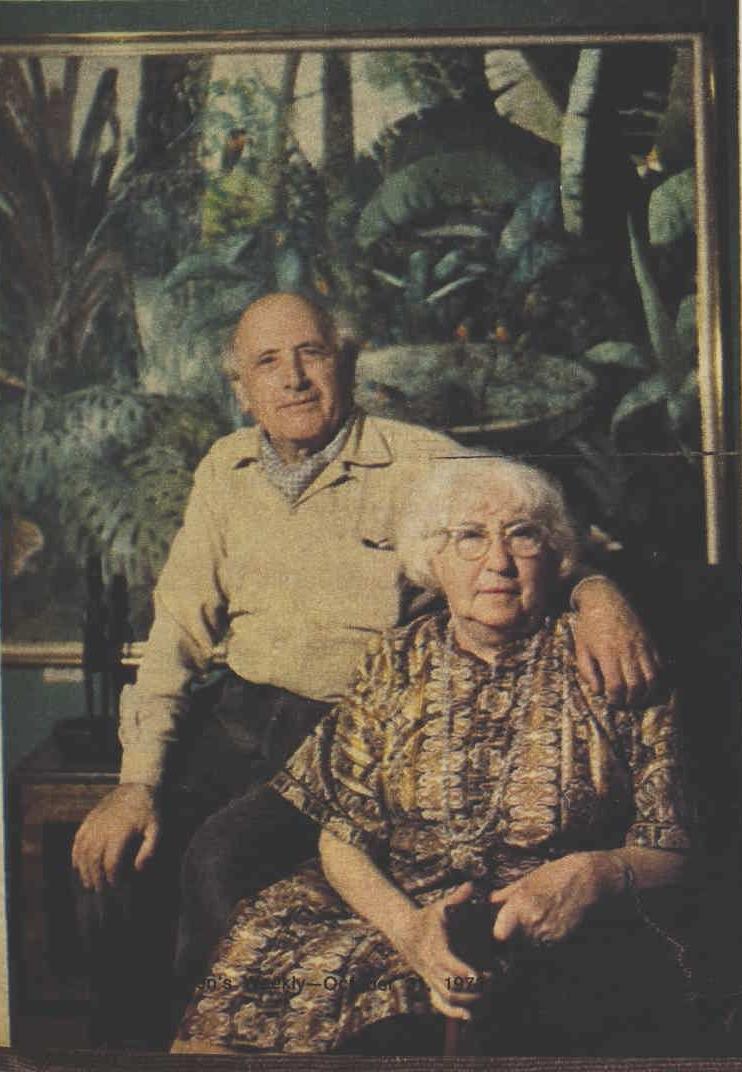
Set atop Chisholm Avenue, with a vista to live for, this wonderful stone cottage seems to hug the top of the hill and yet, when inside, the windows show they have been placed to keep the outside part of the home's overall flow - it is a place designed to meet and keep the natural world, and not just in its use of local building materials such as sandstone and wood.
The site "Hy-Brasil", is part of lands acquired by Mr. and Mrs. Ted Herman and held over many years with the intention of protecting the hill-top setting of the Alexander Jolly designed house at its centre.
Ted Herman was the son of the important 20th century Australian painter Sali Herman, and his daughter Nada is also a successful painter, whom we have run a Profile on and seen at numerous Pittwater Artists Trail Exhibitions. Nada is still creating her glorious paintings, many inspired by this location.

Edward (Ted) Herman (b.1936) Headland, Bungan Beach - Oil on board; 44 x 59 cm.

Nada with recent work - Red hot pokers Over Pittwater.
Nada explains;
”In the 1950s my father, Ted, who was also an artist, bought this three-acre property,” Nada says. ”He and my mother, Dawn, lived in a historic sandstone house called Hy-Brasil; it was built by the renowned architect Alexander Jolly.
”In 1977 my parents were granted a permanent conservation order from the Minister of Planning and Environment to have the house and grounds heritage listed. They wanted to ensure that this unique bushland property could never get subdivided.”
Consequently, when building a new residence close by to Hy-Brasil for herself and her daughters, it was mandatory that no footprint be left on the land should the building ever be removed.
The land on which Hy-Brasil is located was originally part of 1200 acres of land granted to John Joseph Therry on August 31st 1833. It was subdivided as part of the Pittwater Estate, a subdivision for villa sites. The first owners of the land (Lot 8A of the Pittwater estate subdivision - main part of the site where Hy-Brasil now stands ) were Joseph Dalton and Daniel Claney who transferred the land to George Holland in December 1882. Holland held the possession of the land until July 1927 when he sold it to Redway Thomas Pawley and Arthur George Potter.
The ownership of the land passed on to Albert Travers Black after just two months. Mr. Black was a Mining Engineer who would apply for a patent, served in WWI in mine-sweeping, and would be applying for mining lease at Uralla soon after purchasing the bush blocks atop Avalon Beach, and later to dredge at Kincumber, for shells. He also worked in real estate. A few notes about him under Extras.
A year later Kathleen Wilhelmina Jolly wife of the Alexander Stewart Jolly purchased it from Albert Travers Black, becoming the registered proprietor of the land;
Primary Application - Kathleen Wilhelmina Jolly 18 acres 1 rood 33 perches at Pittwater in Parish Narrabeen County Cumberland Shire Warringah Volume 4472 Folio 138 Date range: 17/10/1929 to 10/03/1931 - NSW State Records
This is the Hy-Brasil site:
Primary Application - Kathleen Wilhelmina Jolly 6 acres 2 roods 35 1/2 perches on Hilltop Road at Pittwater in Parish Narrabeen County Cumberland Shire Warringah Volume 4624 Folio 141 Date Range: 30/6/1933 to 14/5/1934 NSW State Records
This wasn't the only Avalon Beach land sale going on at that time:


Advertising (1929, January 11). Goulburn Evening Penny Post (NSW : 1881 - 1940), p. 7 (DAILY and EVENING). Retrieved from http://nla.gov.au/nla.news-article99328110

Advertising (1929, March 28). The Sun (Sydney, NSW : 1910 - 1954), p. 2. Retrieved from http://nla.gov.au/nla.news-article222699724
Mrs Jolly transferred the land, which was still undeveloped together with its surrounding neighbouring allotments, to the Australian Land Development Company limited on April 15th of the same year. This was a business enterprise of Albert Edwin Dalwood, whom many would remember as being the gentleman who helped establish Dalwood House, further south - more on him below.
Mr Dalwood soon had the land up for sale as the 'Dalwood Park Estate' and then the 'Three Beaches Estate':

Advertising (1929, June 16). Sunday Times (Sydney, NSW : 1895 - 1930), p. 16. Retrieved from http://nla.gov.au/nla.news-article131629775

Advertising (1929, October 27). Sunday Times (Sydney, NSW : 1895 - 1930), p. 13. Retrieved from http://nla.gov.au/nla.news-article131630305
A S Jolly was apparently selling land here then, for and associated with Mr. Dalwood, although there were problems, as this newspaper report, running at the same time, written by an opposition newspaper, illustrates:
A. E. DALWOOD'S WOES
'Sunday Times' Head Asked to Account for Land at National Park
'WHY HANG ON?' ASKS JUDGE
A CASE of unusual interest was before the Judge in Bankruptcy, Mr. Justice Long-Innes, last week, when an application was made, under Section 134 of the old State Bankruptcy Act, on behalf of Mr. W. H. Palmer, as Official Assignee of Alexander Stewart Jolly, for an order that Albert Edwin Dalwood, a well-known operator in real estate, and proprietor of the Sunday Times, should account to the Official Assignee for all the estate, title and interest for certain allotments of land in the National Park Estate, near Loftus, which had been transferred to him by Jolly.
DALWOOD, besides his worries as head of the 'Sunday Times,' is engaged in legal warfare with H. D. Macintosh, ex-owner of the paper. And recently he was irked by a fight with co-directors of the Southern Union Insurance Co. Reputedly he is a very wealthy man.
It was asked that Dalwood should convey to the Official Assignee two allotments of land, transferred to him by Kathleen Wilhelmina Jolly, or, in the alternative, that he should account to the official assignee for any moneys realised by him by the use of the said lots or disposal of them, since they had been transferred to him by Mrs. Jolly.
Mr. Norman Pilcer (instructed by Messrs. Howard Phillips and Co. of Yass by their Sydney agent, Mr. Basil Smith) ^…instructed by Mr. W. H. Drew) for Dalwood, who opposed the application.
The grounds of the application were that the transfers were preferences in favor of Dalwood, that they were voluntary settlements, that they were acts of bankruptcy to the knowledge of Dalwood that the transfers were obtained by Dalwood by material misrepresentations, whereby the bankrupt and his wife were Induced to convey the lands to him, that the transfers were, to the 'Mr. Dellow.' I think that was on November 11, 1926. 'Mr. McCoy handed me a document, a couple of typewritten sheets of foolscap, saying, 'Mr. Dalwood has purchased the interest of Jolly and Hood In the contract: He said, 'I am going to tender you the money due to you under the contract, and ask you to sign this agreement and hand over the certificate of title.' ' 'I told McCoy that the contract had expired and that I had cancelled it. Dellow then counted out £238, which he said represented the balance of purchase money, £200, and £38, interest. 'I said, 'I am not going to accept the money. I am not going to sign the transfer, and I am not going to hand you the deeds! They went away.
'Later I railed at Dalwood's office to see him, in response to a letter from him. Dalwood said, 'I have been a big loser over Jolly and Hood, and I cannot make you a better offer than £238.' I refused to accept it and came away.
'About June, 1927, I received another letter from Dalwood and Mrs. Lane, and I went to his office. He told me that he had purchased the interest of the others in the contract, and, though he didn't want any law, he would have to take action against me. I said, 'I don't want any law either,' and Dalwood said, 'If there is any law I'll beat you.' He said, I’ll give you £250 in settlement.' I refused to take it. 'Next week I went back to him again, and told him I would take £300. He said, 'I'll give you £275; tome on — shake hands over it.' I shook hands with him, and he paid me the £275.'
Mr. Weston: Did Jolly ever call on you after you cancelled the contract?— Yes. Jolly and Hood both called. When was that?— It is a long time ago. I think In June, 1924.
After you had notified them that the contract had been cancelled? — Yes. What happened? — Hood offered me a cheque for the balance. I refused to take it. He said they could sell the land for £1750, and that they would give me 10 per cent, of the profits. Well? — I told them that they had better see my solicitor as I had cancelled the contract.
Mr. Weston said that Dalwood had never been asked for, and had never refused to give certificates of title for any (if the lots that had been paid for.
Mr. Justice Long Innes: I think people should not wait in such matters. I cannot understand why Mr. Dalwood should hang on to this land.
Mr. Weeton: Mr. Dalwood has never received one penny from this land. I understand that some of the purchasers have paid but have not asked for their certificates.
Mr. Justice Long Innes: He should not need to be asked. Mr. Weston: As a matter of fact, In January of this year' Mr. Dalwood asked the Official Assignee to make available any certificates of title, but the Official Assignee wanted him to pay all expenses. The further hearing will be continued on Monday.
A. E. DALWOOD'S WOES (1929, September 8). Truth (Sydney, NSW : 1894 - 1954), p. 14. Retrieved from http://nla.gov.au/nla.news-article169323323
The land was purchased by Richard William Henry Wilson on June 24th, 1935 and shortly after he commissioned Alexander S. Jolly to design the property he called 'The Gem'. Mr. and Mrs. R. Wilson have appeared in these history pages on a previous occasion for saving lives:

MR. and MRS. R. WILSON, of Avalon Beach, who went to the rescue of the three persons who had a narrow escape with their lives when their launch was wrecked off Avalon Beach, near Palm Beach, on Friday afternoon. No Title (1935, July 1). Newcastle Morning Herald and Miners' Advocate (NSW : 1876 - 1954), p. 8. Retrieved from http://nla.gov.au/nla.news-article138134037
The year 1935 wasn't a good one for the Wilson family. This tragic and horrible event may lend an insight into where the family were to be able to see people that needed saving:
SPLINTER ENTERS BODY OF MAN
- SYDNEY, Tuesday. - While William Wilson (47) was either climbing or sitting on a paling fence near his home at Avalon Beach a splinter nearly, an inch thick broke off, and about four inches entered his body. He was unable to free himself for several moments, and when the splinter broke from the paling he fell fainting to the ground. He was removed to the Manly Hospital, where an operation, was performed. He suffered severely from bleeding on the way to hospital. SPLINTER ENTERS BODY OF MAN (1935, August 13). Barrier Miner (Broken Hill, NSW : 1888 - 1954), p. 4. Retrieved from http://nla.gov.au/nla.news-article46701919
PIERCED BY BIG SPLINTER: MAN DIES
WILLIAM WILSON, 47. of Marine Parade, Avalon, who was shockingly Injured near his home last Sunday when a large splinter of wood entered the lower portion of his body, injuring him internally, died yesterday in Manly Hospital. Wilson was sitting on the fence when the splinter broke away, four inches of it penetrating his body. PIERCED BY BIG SPLINTER: MAN DIES (1935, August 16). The Labor Daily (Sydney, NSW : 1924 - 1938), p. 7. Retrieved from http://nla.gov.au/nla.news-article237495703
MAN'S DEATH FOLLOWS ACCIDENT
Following an inquiry, the City Coroner. Mr. Oram, yesterday found that William Francis Edgar Wilson, 47, a tiler, of Marine Parade, North Avalon, died on August 14 from the effects of Injuries accidentally received through part of a broken rail penetrating his body while he was climbing over a fence at Avalon on August 11. His father, Richard Henry Wilson, said that deceased on returning from a walk complained that he had lhad an accident while climbing over a fence, and that a piece of wood had penetrated the lower portion of his back, injuring him Internally. He was admitted to Manly Hospital, where he died on August 14. MAN'S DEATH FOLLOWS ACCIDENT (1935, August 21). The Labor Daily (Sydney, NSW : 1924 - 1938), p. 8. Retrieved from http://nla.gov.au/nla.news-article237488130
WILSON.-August 14. 1935, William Francis Edgar, beloved son of Richard Wilson, of Avalon Beach. Family Notices (1935, August 15). The Sydney Morning Herald (NSW : 1842 - 1954), p. 8. Retrieved from http://nla.gov.au/nla.news-article29537445
Birth: WILSON WILLIAM F E 13209/1888 RICHARD W H (father) HONORAH (mother) ST LEONARDS - NSW Births, Death and Marriage Records.
Richard and Honorah had five children; William (born 1888), Mary (born 1890), Richard Joseph Norman (born 1892) Leslie Edward (born 1895) and Thomas R(born 1897) - all the births were registered at St Leonards. Their parents lived in North Sydney during WWI, in which the boys served. The couple were married in 1885, the marriage registered at West Maitland.
Honorah, born 1864 at Maitland, passed away in 1918 - her death recorded at St Leonards. She was the daughter of Elijah and Mary O'Brien.
Mr. Wilson remarried.
'The Gem', the stone and timber cabin now known as Hy-Brasil was completed by 1936 and scorched by bushfires the same year:
FIGHT WITH FIRE NEAR AVALON.
MEN ALMOST TRAPPED.
REFUGE IN WELL.
For five hours yesterday bushfires threatened about 100 homes and week-end dwellings on the hills at the back of Avalon. Fanned by a south-easterly wind, the fires swept down from the plateau and burnt through light timber and grass near Pittwater.
One of the volunteer fighters, A. Butler, of Narrabeen, and a fireman, were surrounded by flames and almost suffocated by thick smoke. They crawled 18ft down a well in the yard at one of the houses. After 10 minutes, the smoke forced them to climb to the surface, but the fire had then burnt itself
out.
Constable Simpson, of Mona Vale, who reached Avalon first, telephoned for aid. A fire tender with five men under Station-officer Bissett was sent from headquarters, and eight members of the Narrabeen volunteer brigade hurried to the Are. Sergeant Huckins and three constables, from Narrabeen, and Con-stable Gold, from Manly, also Joined the fighters.
BREAKS AROUND HOUSES.
While some of the men fought the advancing flames others burnt breaks around homes from Clairville to Taylor's Point. At Hill-top-road the fire was beaten back from eight houses.
On the sea side of the hills the homes of Colonel Johnson, Colonel Reynolds, and Mr. A. R. Harris were threatened, and at Mr. R Row's Cabbage Trees Estate, 400 yards away, the flames scorched the garage near the house. Mr. R. Wilson's stone house was blackened by flames.
At many places hoses were used to fight the fire. Water was connected to Avalon only a fortnight ago.
Russell Brown, a Boy Scout from Goulburn, joined the fire fighters. Constable Brown said: "He carried hoses, turned on taps, and worked harder than any of us. His assistance was most valuable." FIGHT WITH FIRE NEAR AVALON. (1936, November 13). The Sydney Morning Herald (NSW : 1842 - 1954), p. 10. Retrieved from http://nla.gov.au/nla.news-article17287935
Mr. Wilson passed away in 1942:
WILSON RICHARD ARTHUR 10696/1942 JOHN ROBERT (father) ELSIE DOREEN (mother) MANLY (place death registered) - NSW Births, Deaths, Marriage Records.
Another change in ownership occurred in February 1949 and Rachel Jane Donaldson (Jenny) became the registered proprietor of the property.
GRATITUDE OF RED CROSS
The contest was the "Sunday Herald's" last "Name A Foal" competition. The chairman of the Red Cross Appeals Committee, Judge A Curlewis, expressed his thanks to all entrants in the competition who, he said, "have done so much to to alleviate the great and pressing needs of the Red Cross Society."
He said: "Ten weeks ago the Red Cross Appeals Committee sought the help of 'The Sydney Morning Herald' to launch the 'Name a Foal' Competition in order to augment the funds of the society.
"Not only was the request granted, but within a few days space was allotted to us, prize money guaranteed, conditions for the competition finalised, and the project published.
"That such a magnificent result could be achieved in the following weeks was beyond the expectations of all my members.
"For all this may I offer sincere thanks to the directors of the 'Sydney Morning Herald' and to its staff!"
Other Prizes:
The 20 consolation prizes of £5 each were awarded for the following foal names:
....
Scarlet Archer, Dress Ring.
Mr. C. H. Milnes, Hy-Brasil, Avalon. GRATITUDE OF RED CROSS. (1949, October 16). The Sunday Herald (Sydney, NSW : 1949 - 1953), p. 7. Retrieved from http://nla.gov.au/nla.news-article18471613
Passing away on May 17th, 1951, at 84 years of age, at Beecroft, her family held the ownership of the house until it was bought by Ted Herman in 1958. The name Hy Brasil, which denotes the “Island containing the Garden of Eden” was given at this stage. (CityPlan Heritage January 2006)
Native trees have been retained around the house and supplemented by plantings of ornamental exotics, notably sweet gum (Liquidambar styraciflua), pampas grass (Cortaderia sp.), fruit salad plant (Monstera deliciosa), tree ferns (Cyathea sp.), giant bird-of-paradise flower (Strelitzia nicolai) and azaleas (Rhododendron indicum cv.s).
The ridge-top siting of Hy Brasil is prominent from the surrounding area and takes advantage of glorious panoramic views of the Pacific Ocean and Pittwater.
The overall impression of Hy-Brasil's setting is one of blending of the house into natural bushland. Outside, extensive use has been made of the local sandstone which has been cut to provide steps, garden seats, retaining walls, pools and a barbeque. The area to the west of the house contains terraced lawns leading down to a sandstone cliff which forms a well-defined boundary to the property. Below the cliff, natural bushland extends down to the properties below.
Constructed of local rock faced sandstone, the layout of Hy-Brasil itself originally comprised a main living space with verandahs to the west and east and bedroom and kitchen to the south. The house has been planned around a large central stone fireplace and the use of natural materials of stone and timber represents a distinct 'organic' design philosophy. A distinctive feature of the fireplace structure is the mantel which consists of a three metre long stone slab.
%20of%20Nada%20Hermann%20and%20Hy%20Brasil%20Artist%20and%20Summer%20Houses%20095.jpg?timestamp=1516233337096)
The house has a contemporary style in its design influenced by Californian Bungalow and Organic architectural movements with the use of large picture windows, exposed internal stained timber rafters and beams coupled with a low pitched horizontal roof.
An Article from 1964, soon after the Hermans bought the stone cottage, gives an insight into how it was then and what modifications may have been made, as well as being misnamed, or misheard when the name they gave their home was spoken:
STONE HOME; built like a hunting lodge
By SUSAN JAMES
Based on the design of a European hunting lodge, this house is a quiet secluded oasis standing in three acres of natural bushland near Sydney.
ALTHOUGH European in design, Mr. and Mrs. Edward Herman's house "Hi-Brazil," Avalon, N.S.W., echoes the natural colors of Australia with its unrendered sandstone walls and dark timbered beams.
Reputed to be one of the oldest houses in Avalon, it stands on a hill overlooking Pittwater and far beyond. It was bought by Mr. and Mrs. Herman about five years ago, and although the house was radically renovated by them when they moved in, the basic conception of the building was left untouched.
To reach "Hi-Brazil," you must either climb a long flight of steep stone steps, which eventually lead you past the goldfish pond to the main entrance, or take the newly constructed driveway that skirts the house itself, so visitors enter the living-room through the patio.
This is a house which contrasts sharply with its (for the most part) ultra-modern neighbors, and the roughness of stone and timber is a perfect foil for the bushland, in which, it stands.
Full use has been made of the natural textures of stone and wood; wherever possible the sandstone has been left in its original state, both inside the house and out, to the beams merely stained a dark rich oak. The color in the rooms is provided by the mixture of modern and antique furnishings, by the paintings, and from trophies Mr. Herman has brought back from other countries.
Edward Herman is the son of Sali Herman, the well known Sydney artist. Edward, or Ted as he likes to be called, also paints but in a vividly contrasting style. The contrast could not be more marked between Sali Herman's delicate watercolors of terraced houses with Victorian trellised balconies and brightly colored and the almost stark absence of exterior color or embankment in his son's house.
Enter the living-room from the patio and it is almost like going into a church. There is a meet feeling of space of this room with its high-vaulted roof and sombre beams. Long low windows run along two sides of the room.
At one end there is a large stone fire place hewn from local stone, of almost baronial proportions, which doubles as an indoor barbecue when the Hermans entertain.
One of many unusual touches in this room is the leather camel seat standing in front of the fireplace, which Mr. Herman brought back from Iraq and made into a stool.
Masks and trophies decorate the walls. Aboriginal didgeridoos frame the windows, and father's and son’s paintings contrast sharply in style and technique.
A doorway at one side of the huge fireplace leads into a bright, modern kitchen. The cupboards, also in unpolished wood, are Mr. Herman's handiwork.
While modern in concept, this kitchen, too, has unusual features-wooden casks from Singapore are used by Mrs. Herman as storage containers, an old coal lamp hangs from the ceiling, and a voluminous ancient brick oven, once used for making bread, now serves as storage cupboards.

Mr. and Mrs. Herman have turned one corner of the kitchen into an informal dining alcove. The benches and solid table of Australian hardwood are faintly reminiscent of an English pub. Wooden shelves above the table their collection of Japanese pottery.
A quaint L-shaped bedroom flanks the other side of the fireplace, and a small study completes the rooms. The study, incidentally, bulges with Mr. Herman's treasures and trophies which, as yet, have no niche.
"Our one idea was to find a house which gives us peace and seclusion," they said, and indeed this they have for coming back down the hill it was certainly like going from one era into another.
DINING ALCOVE (left) used for informed entertaining.
KITCHEN (above) reflects the old and the new - concealed pelmet lighting gives added brightness.
LODGE (above) completely hidden from the roadway merges into its surroundings.
GOLD-FISH POND (right) was built by the owners.
VIEW FROM THE TERRACE is of the surrounding bushland and beyond to Pittwater. To the right is a barbecue area in constant use during the summer.
LIVING-ROOM seen through the kitchen door. High, vaulted roof and sandstone walls contrast with the comfortable, provencal atmosphere. On the far wall is one of Sali Herman's paintings done in 1957. French windows (left) lead on to patio.
Pictures by Keith Barlow.
STONE HOME.. built like a hunting lodge (1964, April 29). The Australian Women's Weekly (1933 - 1982), p. 44. Retrieved from http://nla.gov.au/nla.news-article51775651
NB: photos in colour by A J Guesdon
Sali Herman, father of Ted and grandfather of Nada, moved to Palmgrove road, Avalon Beach in 1959 from Potts Point. Nada tells us he did create paintings while living in Palmgrove road, infleunced by his surrounds. These paintings included the garden he and his wife had and the lorikeets that would visit them:
Potts Point: Wylde Street at the end of the Point was subject to the constant roar of dynamite blasting and the staccato racket of pneumatic drills as the enormous Captain Cook Graving Dock was constructed. When Japan entered the war early in December 1941, and was pushed down the Malay Peninsula, many inhabitants moved to safer areas. Across the hall from us lived the Vincents, below us the Herlingers and in the ground floor were the ‘girls’ who entertained visiting GI’s and attended tot heir needs. Shortly after we arrived I heard that the flat below us was empty. I told Sali Herman, who was unhappy with his accommodation lower down the street. He settled in with Paulette shortly after and lived there until they moved up to Avalon many years later. A Pavane for Another Time By Bernard Smith, 2002.
Artists, MR. WILLIAM DOBELL and MR. JUSTIN O'BRIEN with MRS. SALI HERMAN were among more than 200 guests who attended a reception yesterday to celebrate Bastille Day the French National Day - at Prince's.

French Celebration (1953, July 15). The Sydney Morning Herald (NSW : 1842 - 1954), p. 9. Retrieved from http://nla.gov.au/nla.news-article18388347
STREET SCENE

Sali Herman, 56, Swiss-born artist, is a naturalized Australian. He has won seven important prizes for landscapes since he came to Australia. He is painting a scene in one of the old parts of Sydney which is going to be pulled down for extensions to the naval dockyard.
STREET SCENE (1955, March 1). Good Neighbour (ACT : 1950 - 1969), p. 3. Retrieved from http://nla.gov.au/nla.news-article176527521
One art exhibition I’m not going to miss will be held at the Pacific Club, Palm Beach, on Sunday, October 25, in aid of the Surf Club. Pictures by Robert Johnson, Sali Herman,James R. Jackson, Adrian Feint, H. A. Hanke, Lloyd Rees, Sid Long, and many others will be on view. SOCIAL JOTTINGS (1959, October 21).The Australian Women's Weekly (1933 - 1982), p. 15. Retrieved from http://nla.gov.au/nla.news-article44799132
Mr. Sali Herman, of Avalon, won the £200 Wynne landscape for the second time. His landscape was "the Devil's Bridge." He last won the Wynne prize in 1942, and has won 14 other art prizes in Australia. 1962 ARCHIBALD WINNER (1963, January 19). The Canberra Times (ACT : 1926 - 1995), p. 3. Retrieved from http://nla.gov.au/nla.news-article104256508
The trustees awarded the Wynne Prize to Mr Sali Herman, of Avalon Beach, for his painting, The Red House. Mr Herman, 67, won the Wynne Prize in 1944 and 1962, and the Sulman Prize in 1946 and 1948. Victorian wins Archibald prize (1966, January 22). The Canberra Times (ACT : 1926 - 1995), p. 3. Retrieved from http://nla.gov.au/nla.news-article105883398
The $400 Wynne Prize was won by another Sydney artist, Sali Herman, 69, of Avalon Beach. WOMAN'S SECOND ARCHIBALD (1968, January 20). The Canberra Times (ACT : 1926 - 1995), p. 1. Retrieved from http://nla.gov.au/nla.news-article106987528
Sali Herman, OBE, Avalon Beach, NSW, for service to art. NEW YEAR HONOURS FEDERAL LIST CIVIL (1981, December 31). The Canberra Times (ACT : 1926 - 1995), p. 8. Retrieved from http://nla.gov.au/nla.news-article126868718
SALI AND PAULETTE HERMAN (at left) in front of one of Sali's paintings in their Avalon home, N.S. W.

WARM-HEARTED Swiss-born artist Sali Herman, of New South Wales, and his lively, fiery Breton-born wife, Paulette, asked for time to think about the question. Then they came back with these answers:
Sali: "I thought very hard about the whole thing and I would say my wife's best virtue is putting up with me. Only a remarkable woman could do that.
"Her greatest fault? Ha, whenever I give her money to buy something she always keeps the change."
Paulette: "Sali's best virtue? He is too generous, everybody makes use of him. And he just will not listen to me.
"His fault? It is the same as his virtue. He's too much of an optimist, and being that way makes him too generous; so that is all wrong in another way."
HOW EASY ARE YOU TO LIVE WITH? (1973, October 31). The Australian Women's Weekly (1933 - 1982), p. 17. Retrieved from http://nla.gov.au/nla.news-article47229707
This picture is particularity poignant when you know Paulette (Paule) passed away at Mona vale hospital in 1973. In the painting you can see some of a garden and the lorikeets he painted, as recalled by their granddaughter Nada. Pittwater Online News will run a future page on this the male artists in the Avalon Beach Herman family at a later date - this is 'tip of the iceberg' stuff run as part of their Hy-Brasil-Jolly designed home.
Hy Brasil was nominated for a Permanent Conservation Order in 1980 by the Herman family. The Order was placed on 31 July 1981 and was transferred to the State Heritage Register on 2 April 1999.
The item has also been on the Royal Australian Institute of Architects 20th Century Register of Significant Buildings since 1979.
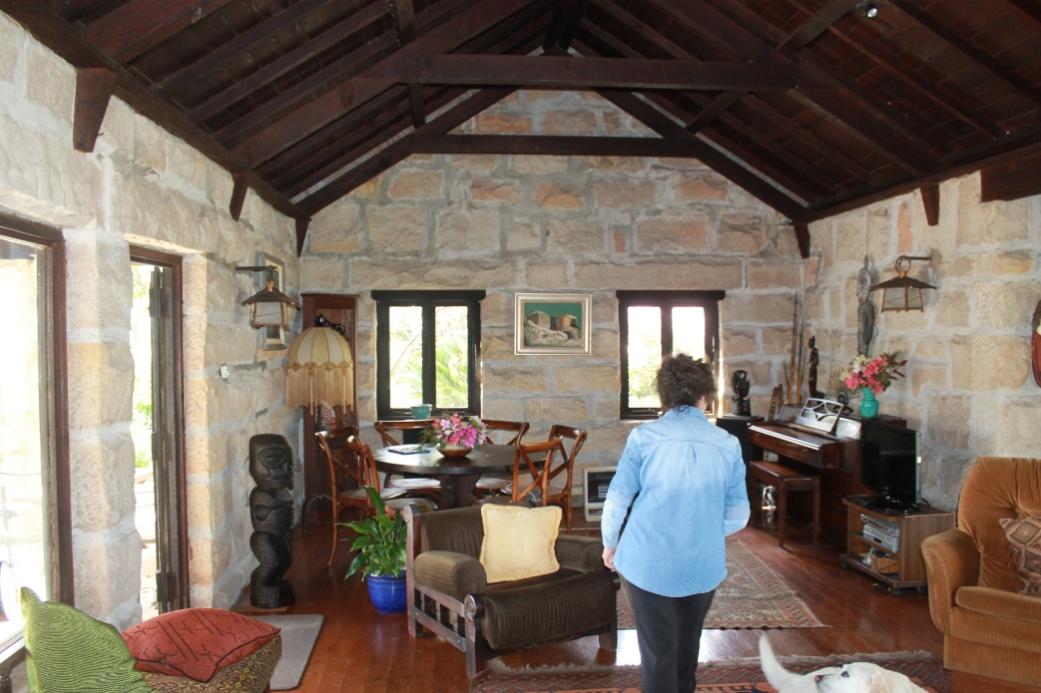
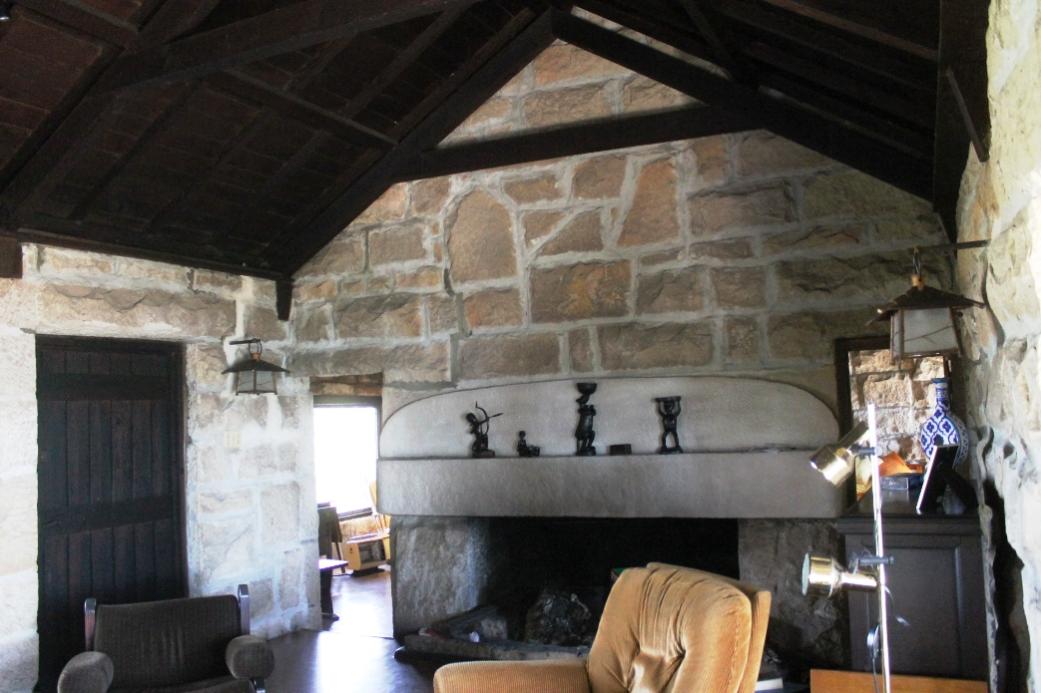
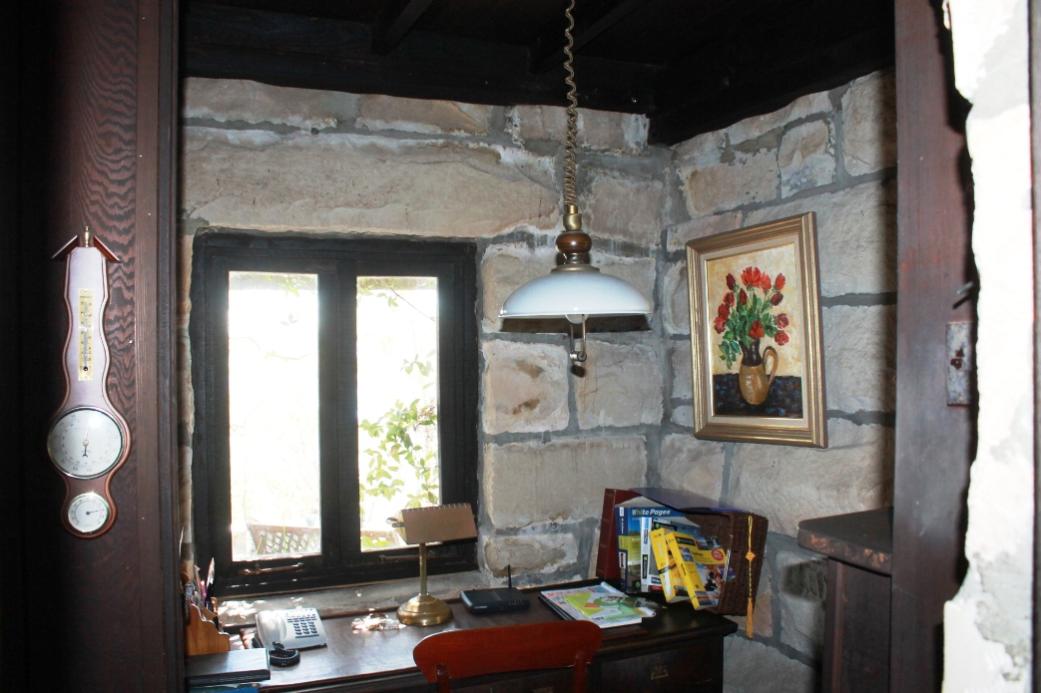
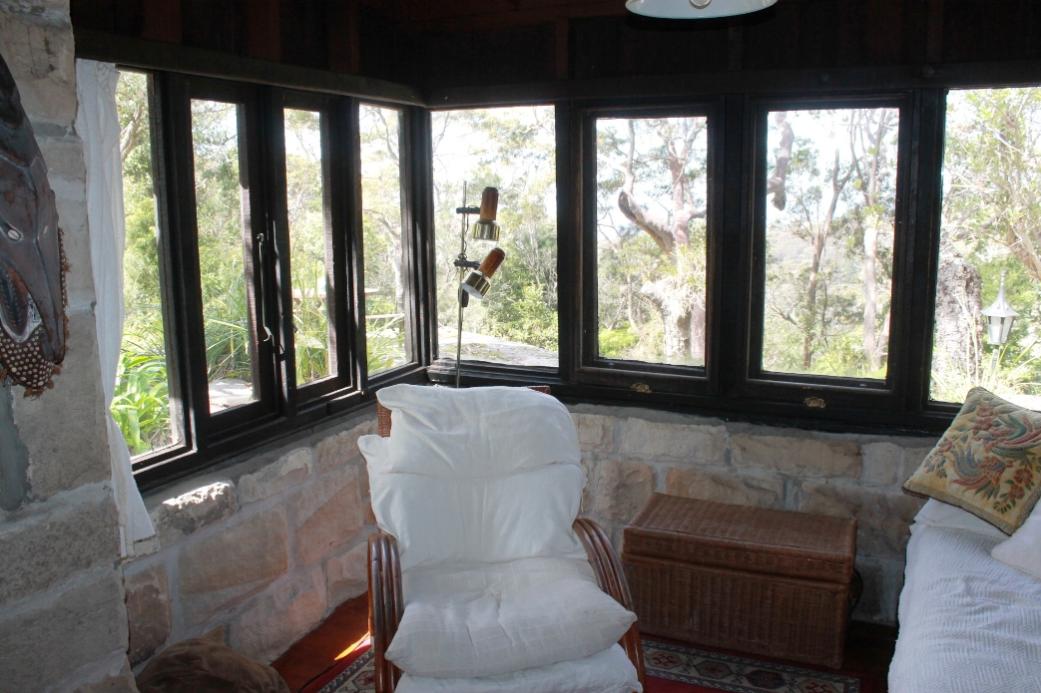
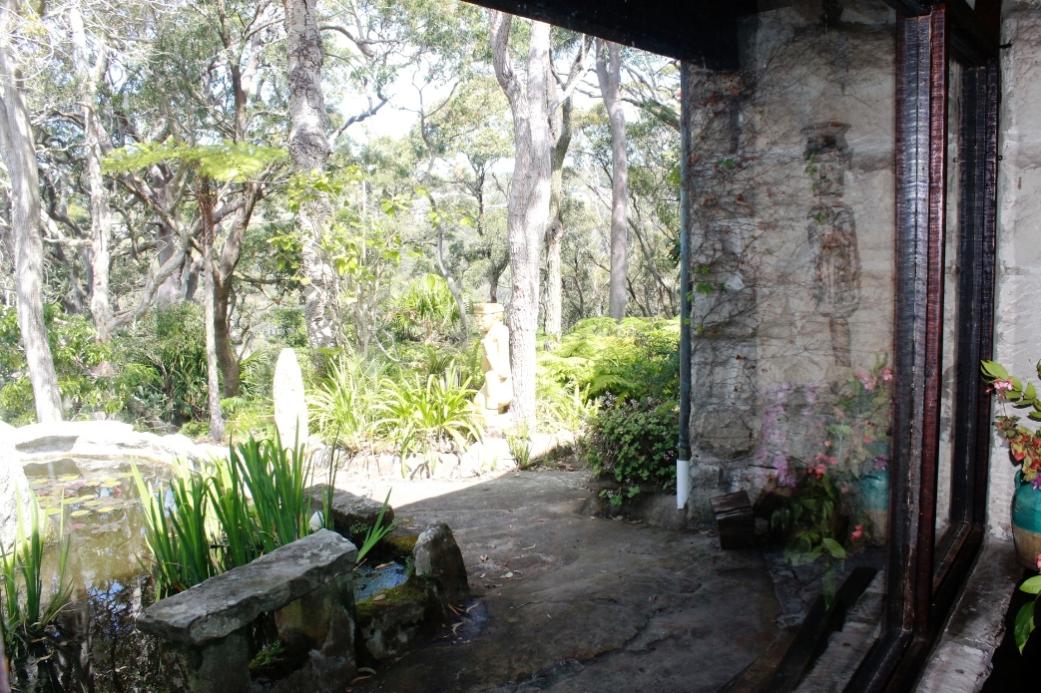
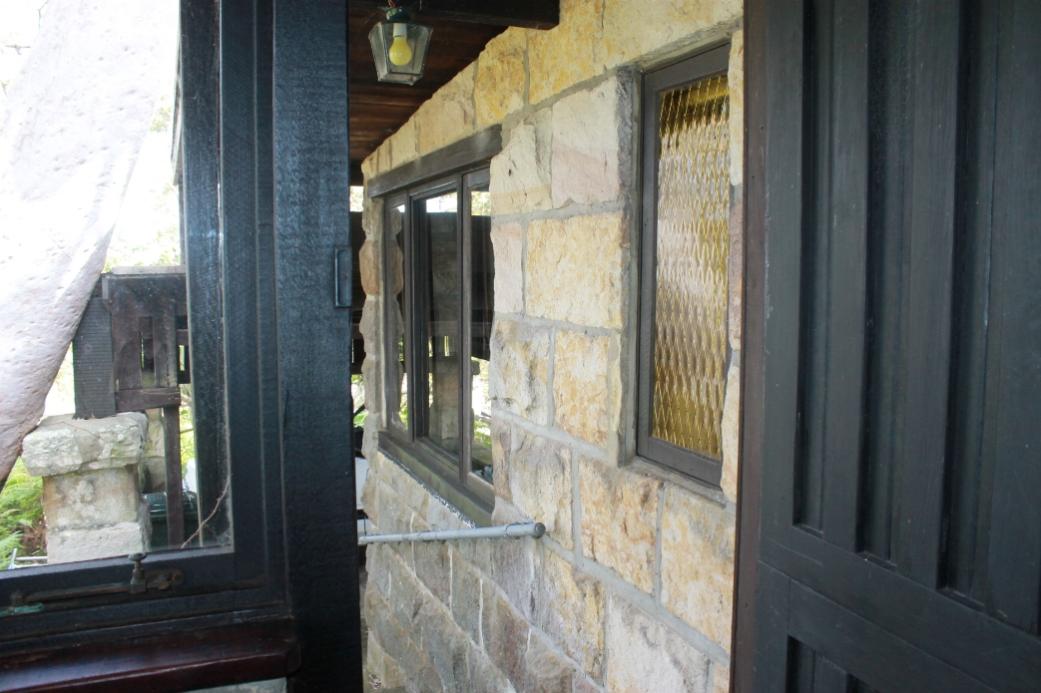
Alexander Stewart Jolly
A S Jolly was the fourth born child of Scottish emigrants James Jolly and Jessie Stewart. He was born on the 18th of July 1881 at Wardell, near Lismore, the son of:
JOLLY— STEWART.- August 26,by the Rev. Henry Macready, Salaph House, Rosehill-street, Redfern, James Jolly, youngest son of Daniel Jolly, Nuthill, to Jessie Stewart, second daughter of John Stewart, Penicuick, both of Scotland. Family Notices (1881, September 24). The Sydney Mail and New South Wales Advertiser (NSW : 1871 - 1912), p. 524. Retrieved from http://nla.gov.au/nla.news-article161920150
NSW Births, Deaths and marriage Records:
JOLLY DANIEL 27351/1882 JAMES JESSIE LISMORE
JOLLY JOHN S 31245/1884 JAMES JESSIE LISMORE
JOLLY JESSIE S 33151/1886 JAMES JESSIE LISMORE
JOLLY Alexander 34093/1887 James Jessie Richmond
JOLLY ANNIE R 33658/1889 JAMES JESSIE LISMORE
JOLLY HORACE A 4523/1895 JAMES JESSIE LISMORE
JOLLY ISLAY 13449/1897 JAMES JESSIE S LISMORE
OVERLAND PASSENGER TRAFFIC.
[BY TELEGRAPH.]
""ALBURY, "WEDNESDAY.
The following have passed through .
For Sydney (by express on Tuesday) : Mrs. Jolly and 3 children, J. Jolly, E Jolly OVERLAND PASSENGER TRAFFIC. (1887, February 3). The Sydney Morning Herald (NSW : 1842 - 1954), p. 10. Retrieved from http://nla.gov.au/nla.news-article13626252
NEW STORE.—we notice that Messrs. Brown and Jolly have completed the erection of a General Store, at Rous, for Mr. W. C. Renwick The Store is situated next to the Rous Hotel, corner of Wyrallah and Wardell Roads, and is built of hardwood, with iron roof, and 14 feet ceiling. The length is 35 feet, besides additions of 20 feet and 16 feet at back. In front there is a 10 feet verandah. Provision has been made in building to accommodate a post and telegraph office should occasion arise. It is intended to wait upon the people of Wyrallah, Wardell, and Alstonville weekly, when produce will be bought. The business will be conducted on the same cash principles as at the Glasgow Arcade, Lismore. Mr. Renwick has gone to Sydney for a first-class general stock. Mr. Robinson, architect; is preparing a plan for a new building to be erected in
Molesworth-street, on the site of Glasgow Arcade. It will have 25 feet frontage, 90 feet depth, built of brick, with highly finished plate glass windows. Will be probably completed in November for Mr. Renwick.
Early-day Shipping. — At Coraki last Monday two veteran 'shellbacks,' in the persons of Captain B. Alley, of the S. S. Brunduh, and Captain T. Paddon, of Evans River, spent a few pleasant hours together. Early ahipping history was discussed, and from what we can gather the Skippers named were in the Richmond trade together in the schooner Rob Roy in the 00's — Captain Alley in command with Captain Paddon chief officer. Upon the former's promotion to Messrs Nicoll's vessel Wallace and Bruce, Captain Paddon succeeded him as skipper of the Rob Roy, and a like promotion followed the advent of the steamer Bonnie Dundee into the Richmond trades some years later, Captain Alley taking that vessel and Captain Paddon the Wallace and Bruce.
Timber was the great industry of the district in those days, and Wardell the centre of commercial activity of the Richmond, with two sawmills working full capacity, and as many as 40 vessels moored there at the same time. Amongst the many of the latter there were no more regular traders than the Rob Roy and Wallace and Bruce, and their masters were looked upon as very, competent men. In those days the coast was devoid of the many signals which now aid navigators, whilst no tug boats or buoyed channels existed in our rivers, and masters had to rely solely on their own judgment. Prior to coming to the Richmond Captains Alley and Paddon were together on the goldfields in the western districts of N.S.W., and subsequently were in the same vessel trading to New Caledonia. Both have seen the Richmond merge from wild dense bush to its present prosperous position. Life-long friends, their meeting here on Monday was naturally brimful of interest, many notable reminiscences being re-called, which few in the flesh to-day have any personal knowledge of. SHIPPING ITEMS. (1908, October 30). The Richmond River Herald and Northern Districts Advertiser (NSW : 1886 - 1942), p. 4. Retrieved from http://nla.gov.au/nla.news-article127867290
Members of the Paddon family also came to and settled in Pittwater: Early Pittwater Paddlers, Oarsmen, Rowers And Scullers: The Paddon Family Of Clareville (Or Clairville)
A little about his parents:
OBITUARY
MR. JAMES JOLLY
One of the district's best known business men of earlier years, Mr. James Jolly (84), of Victoria-street, Lismore, died in the Lismore Base Hospital yesterday morning. Mr. Jolly was born at Muthill, Perthshire, Scotland, being the youngest son of the late Mr. and Mrs. Daniel Jolly. He served his apprenticeship as a joiner at Muthill and later worked in Glasgow and Edinborough. In 1877 he sailed from Glasgow on the barque, "Eskbank," under the command of Captain James Barr, as a ship's carpenter. The barque, carrying a cargo of sugar and machinery for Honolulu, was wrecked off Diamond Head and became a total loss. The deceased then secured employment on the Sandwich Island and worked for a Mr. Staines, who afterwards erected the Rous sugar mill.
While working in the Honolulu iron works, Mr. Jolly became acquainted with a young Scotchman, David Buick, an engineer, who built the first Buick automobile and who later transferred his works to America.
Mr. Jolly proceeded to New Zealand and later to Sydney. In 1881 he came to the Richmond River and worked as foreman for a Mr. Carter at Wardell, and still later as foreman on the construction of the Rous sugar mill. Shortly after-wards Mr. Jolly entered into business partnership with Mr. Thomas Fyfe, who, in 1885, owing to ill-health, disposed of his interests to Mr. James Brown, and the firm then became known as Brown and Jolly. In 1907 Mr. Brown was accidently drowned and Mr. Jolly continued to manage the business until his retirement in 1915, when he went to reside in Sydney. For some years past he had lived in Lismore.
The firm of Brown and Jolly became one of the best known among builders, sawmillers and joiners in the State. The deceased was a foundation member of the Lismore Bowling Club and Chamber of Commerce, and was associated with the late W. Lockett in the early days of the Lismore Rifle Club. He was also a foundation member of the first Caledonian Band established in Lismore, and the Lismore Pipe Band will be in attendance at his funeral this afternoon.
Two sons, Mr. Daniel Jolly, of Lismore, and Mr. Alexander Jolly, of Chatswood, and three daughters, Mrs. Shaw Thompson (Jessie), of Dalby, Miss Annie Jolly, of Pymble, and Mrs. Ken Guest (Islay), of Pymble, survive. His wife predeceased him some years ago, and a son, Horace, was killed at the war. The funeral will leave St. Paul's Presbyterian Church, Lismore, to-day at 2 p.m. for the Lismore cemetery. A service will be held at 1.45 p.m. OBITUARY (1940, February 1). Northern Star (Lismore, NSW : 1876 - 1954), p. 10. Retrieved from http://nla.gov.au/nla.news-article101497438
MRS. J. S. JOLLY
Mrs. Jessie Spence Jolly, who died on May 5 at the residence of her daughter, Mrs. J. Shaw Thompson, Dalby, Queensland, was born in Penicuik, a suburb of Edinburgh, on the Esk River, on June 24, 1844. She journeyed to Australia in 1881 on the Lusitania (one of the first Orient steamers to come to Australia) and was married to Mr. James Jolly in Sydney on arrival there.
The young couple came to Wardell, where they lived for some time, and then they moved to Meerschaum Vale for a few years. Mr. and Mrs. Jolly came in 1888 to Lismore, where Mr. Jolly commenced business, and they were resident here until they removed to Sydney in 1916, excepting for a brief period of two years in the nineties, when Mrs. Jolly and four of her children paid a visit to Scotland. The last two years of her life were mostly spent in Dalby with her daughters, Mrs. Thompson and Miss Jolly.
The late Mrs. Jolly will be remembered, with affection by a very wide circle of friends throughout the Richmond River district, for there were few, if any, who gave so much of their time to others, and especially to anyone an distress or trouble. She was for years at the call of anyone who desired help or advice, and her kindly presence and tender care brought soothing relief to many a sick bed particularly in the earlier days when medical or nursing assistance was not readily procurable.
She was a prominent and earnest worker in St Paul's Presbyterian Church, and was one of the first members of the choir conducted by the late Mr. Collins. She had a particularly fine natural voice, and many of the older school can still recall with pleasure her singing of the old Scotch favourites. Her outstanding characteristics were her wonderful unselfishness, her genial temperament, and her unbounded hospitality, and even if she had already passed the allotted span of life, there are many who will mourn the death of a true and faithful friend.
She is survived by her husband, two sons, Mr. D. J. Jolly (Lismore) and Mr. A. S. Jolly (Sydney), three daughters, Mrs. J. Shaw Thompson (Dalby), Miss Jolly and Mrs. K. H. Guest (Sydney), and 11 grandchildren. She was predeceased by two sons and a daughter, the youngest son losing his life on active service in France. OBITUARY (1932, May 18). Northern Star(Lismore, NSW : 1876 - 1954), p. 4. Retrieved from http://nla.gov.au/nla.news-article94284134
He may have been named after his father's brother:
LATE MR. A JOLLY
An old identity of Lismore and the Lower Richmond River, in the person of Mr. Alexander Jolly, died in the Murwillumbah Hospital recently.
Mr. Jolly was a brother of Mr. James Jolly, of Brown and Jolly, Ltd. A native of Mutehill, Scotland, where he was born on December 14, 1849, he came to the colony with his wife and a young family 36 years ago. With his brother, and brother-in-law, the late Mr. James Brown, they settled at Wardell, finding employment in the late Mr. Ernest Carter's joinery works there. Later on he took building contracts, and in the latter eighties erected several large business premises in Lismore, including those now occupied by the National Bank of Australia.
Some years later he purchased a farm on Tuckean, and lived there for many years, eventually removing to Lismore and building the house in Leycester-street now occupied by Mr. T. Taylor. A few years ago he returned to Scotland for a time, and then coming back to the land of his adoption he made his home at Tweed Heads, where he followed his trade as a bricklayer, stonemason and even carried out small carpentering jobs. There, as indeed wherever he lived, he was held in the highest esteem.
Mr. Jolly, who was twice married, leaves a widow and family of six children, one of whom is Mrs. W. J. Julius, of Cudgen. Messrs. Dan and James Jolly, of Tyalgum, near Murwillumbah, are sons. One son was killed whilst scrub- felling there a few years ago, whilst the youngest son, Phillip, was killed in the great war. Mrs. Williams, of Meerschaum Vale, is a sister of the late Mr. Jolly. LATE MR. A. JOLLY (1925, March 3).Northern Star (Lismore, NSW : 1876 - 1954), p. 3. Retrieved from http://nla.gov.au/nla.news-article93478159
On a trip to Perthshire, Scotland in his late teens, Jolly encountered craggy stone inglenooks that would later be a strong feature in his buildings.
After finishing school, he returned to work at his family’s firm for several years, a joinery firm, where skills learned could later be applied to construction of homes. In 1908 he moved to Sydney and began work for the firm Wardell and Denning, where he completed a two-year architectural apprenticeship.
OPENING OF THE NEW CONVENT. THE CARDINAL ON HOSPITAL WORK.
The opening of the new convent attached to the Lewisham Hospital, on Sunday last, by his Eminence Cardinal Moran, completed a cluster of charitable buildings of which, any city might be justly proud. For many years the Nursing Sisters of the Little Company of Mary .had suffered considerable inconvenience in their old home; consequently the formal opening or the new convent was a source of pleasure to the many admirers of the grand hospital controlled by the Nursing Sisters.
THE BUILDING.
The new convent forms the central group between the large general hospital and the private hospital, all overlooking Petersham' Park. It is two storeys high, with basement in the front, and attics. The building contains reception-rooms, six large dormitories, several single bedrooms, and the necessary bathrooms, lavatories, etc. On either side are large verandahs and balconies. The building 'generally is of brick, with stonefaced foundation and. dressings, and roofed with tiles. Light and ventilation are features throughout. The work was carried out by Messrs. Wheelwright and Alderson, under the supervision of Messrs. Wardell and Denning, at a cost of £6195. At the conclusion of the ceremonies en Sunday the sum of £275 was handed' in. His Eminence Cardinal Moran, accompanied by Moinsignoa- O'Haran, was received by a guard of honour composed of the Hibernian Society, and was welcomed by the Rev. Mother and the Right Rev. Monsignor O'Brien (Rector of St. John's College). The ceremony was held in a large marquee erected in the hospital grounds, at which his Eminence presided. Amongst those on the platform were the hon. treasurer, Mr. T. J. Dalton, K.O.S.G. ; the Right Rev. Monsignor O'Brien, the Very Rev. Dean Slattery, P.P. ; the Rev. Fathers T. Phelam, P.P., J. Moynagh, P.P., J. Dalton, J. O'Reilly, E. Gell, Father Frederick, C.P., Dr. Flynn, Dr. Bolger, Dr. M'Donagh, and the Rev. Ma-. T.i Tranmar (Ohurch of England); .Messrs. A.! Massey., W. N. Bull, R. Banriy, Valentine Heaton, W. O'Brien, J. Kavanagh, and J. Cloran. The hon Treasurer, Mr. T. J. Dalton, K.C.S.G., read, an apology for non-attendance from the Lord Mayor of Sydney (Aid. . Thomas Hughes). In presenting his1 financial statement, he said that the cost of the building, including architect's fees, was £6195. The amount which they had to credit was about £3557, leaving a debt on the new convent of £2638 3s.
...
Lewisham Hospital. (1908, January 9). Freeman's Journal (Sydney, NSW : 1850 - 1932), p. 13. Retrieved from http://nla.gov.au/nla.news-article109863365
Murwillumbah -Erection of bank buildings at Murwillumbah for the Bank of Australasia Tenders close June 15 Messrs. Wardell and Denning, architects, 50 Hunter street city.
Lismore - Erection of bank buildings for the Bank of Australasia Messrs. Wardell and Denning, architects 50 Hunter street Tenders close June 15. TENDERS. (1908, June 2). The Sydney Morning Herald (NSW : 1842 - 1954), p. 4. Retrieved from http://nla.gov.au/nla.news-article14934189
This item, where his father wins a contract, may signal the initial shift from being a Joiner to an architect:
Tenders Closed and Accepted.
Lismore. — Erection Works in connection with Bank of Australasia. Wardell & Denning, Architects; Brown & Jolly, Lismore, Builders.
Advertising (1908, September 15). Weekly Supplement to Building (Sydney, NSW : 1908 - 1909), p. 5. Retrieved from http://nla.gov.au/nla.news-article235343359
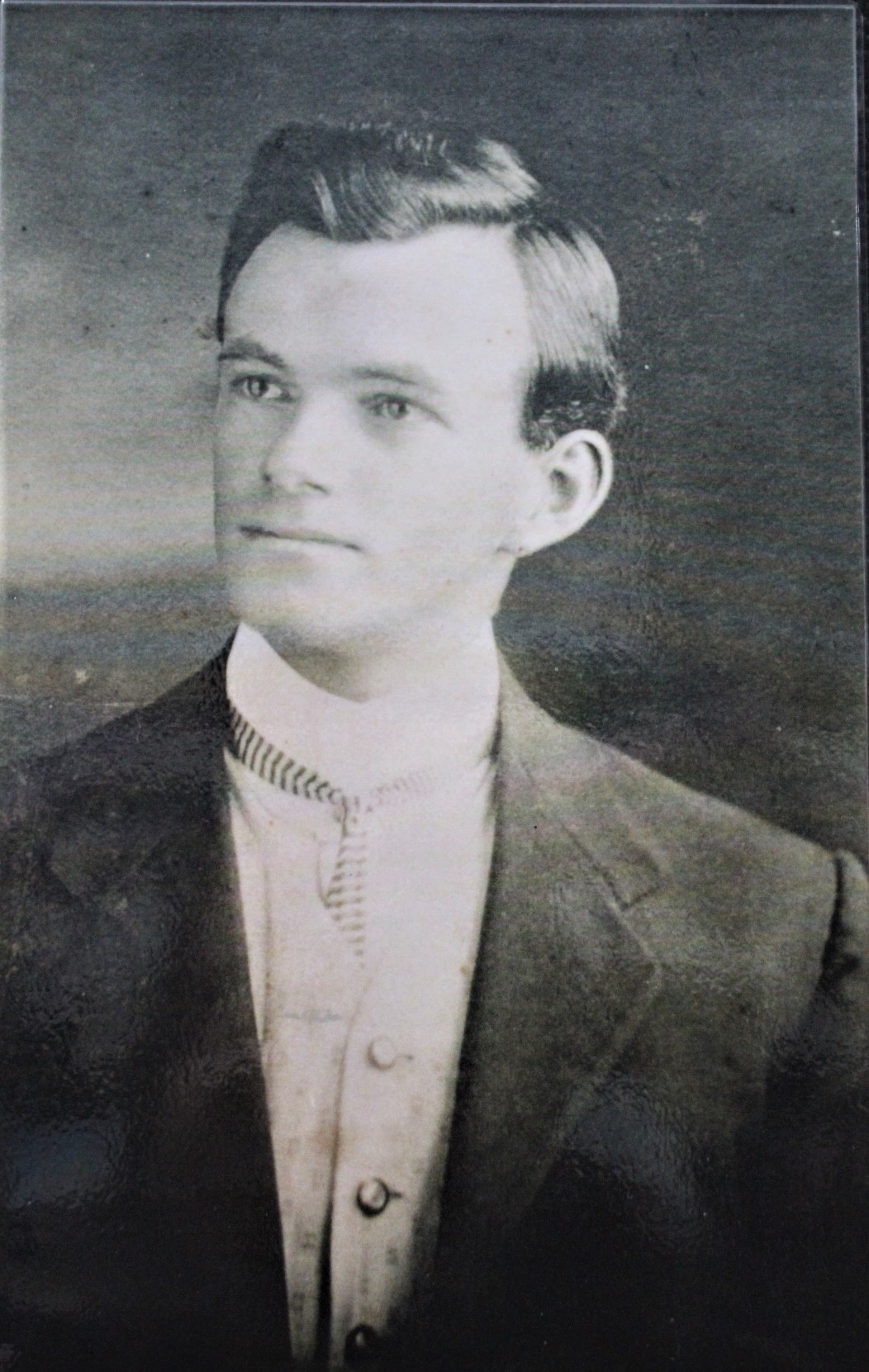
Alexander Jolly as a young man. Photo: ABHS
By 1910 he had his qualifications and is listed as being at Lismore:
The — Architects of N.S.W.
Jolly, A. S., Keen-street, Lismore.
The Architects of N.S.W. (1910, September 19). Construction : Weekly Supplement to Building (Sydney, NSW : 1909 - 1914), p. 9. Retrieved from http://nla.gov.au/nla.news-article234762816
After marrying the daughter of a then famous minister he moved north with his bride, started a business with a fellow Architect, F. J. Board and undertook one pro bono project - commission which went on longer than most building projects and must have contributed to his first bankruptcy. A S Jolly's life would be marked by his essentially generous nature - he also had a good dose of that Scottish fire in his spirit:
WEDDING AT SCOTS CHURCH.
JOLLY—DILL MACKY.
On Thursday evening, June 27, Scots Church, Church Hill, was the scene of a very pretty wedding, when Miss Kathleen Wilhelmina Dill Macky, third daughter of Dr. and Mrs. Dill Macky, was married to Mr. Alexander Stewart Jolly, second son of Mr. James Jolly, of Strathallan, Lismore. The ceremony was performed by the Rev. W. M. Dill Macky, D.D., assisted by the Rev. Richard Dill Macky (father and uncle respectively of the bride).
The bride, who was given away by her father, wore a beautiful gown of white crepe de chine, trimmed with Honiton lace and sprays of ninon roses, with wreath and veil, and carried a shower bouquet, which, with a ruby and diamond ring, were the gifts of the bridegroom.
The bridesmaids — Miss Grace Dill Macky, Misses Jessie and Annie Jolly (sisters of the bridegroom), and Miss Ruby Bathgate — were attired in dainty white Swiss muslin dresses, prettily trimmed with Valencienes lace, and wore Juliet caps. All carried bouquets of pink flowers, which, with gold bracelets and pendants, were the gifts of the bridegroom. The best man and groomsmen were Messrs. - R. Dill Macky, W. M. Dill Macky, Norman G. P. Cook, and Peter Watt.
Mr. S. F. Sherwood officiated at the organ, and Miss Estelle Bowen sang the solo, "Beloved, it is Morn." The church was beautifully decorated for the occasion by friends of the bride. A reception was afterwards held at Sargent's, Market-street, where Dr. and Mrs. Dill Macky received about a hundred guests.
Mr. and Mrs. Jolly left by train for the Jenolan Caves. The bride's travelling costume was a grey coat, and skirt, with white facings, white felt hat trimmed with ruby velvet and white plumes and a set of white fox furs. WEDDING AT SCOTS CHURCH. (1912, July 11). Watchman (Sydney, NSW : 1902 - 1926), p. 8. Retrieved from http://nla.gov.au/nla.news-article112374921
William Marcus Dill Macky (1849-1913), Presbyterian minister, was born on 8 June 1849 at Lisfannan, County Donegal, Ireland, one of five children of William Macky, farmer, and his wife Susannah, née Dill, both descendants of seventeenth-century colonists and clerics. In the early 1850s his father disappeared on the Victorian goldfields. Dill Macky was educated in the classics at S. McQuilkin's school, Londonderry, and studied arts and theology at Magee Presbyterian College, Londonderry, in 1866-67 and 1868-73. Licensed by the Derry Presbytery in May 1876, he was ordained by the Presbytery of Magherafelt in November, after being called to Draperstown church. On 24 May 1881 he married Ellen Elizabeth Morwood, daughter of a medical practitioner.
Richard Broome, 'Dill Macky, William Marcus (1849–1913)', Australian Dictionary of Biography, National Centre of Biography, Australian National University, Retrieved from http://adb.anu.edu.au/biography/dill-macky-william-marcus-5980
More below, including a photo of the gentleman with his family which includes Kathleen.
Their first child is born and the Jollys returned :
JOLLY (nee Dill-Macky).—April 16, at Dongreyald private hospital, Lismore, the wife of A. S. Jolly—a daughter. Family Notices (1913, June 10). The Sydney Morning Herald (NSW : 1842 - 1954), p. 8. Retrieved from http://nla.gov.au/nla.news-article28126114
Bishop Druitt laid the foundation stone of the. new Anglican Church (St. Bartholomew's) at Alstonville on Wednesday, and stated that, so far, £1000 had been raised towards the cost. The subsequent collection totalled £152. Advertising (1913, August 22). The Grafton Argus and Clarence River General Advertiser (NSW : 1874 - 1875; 1879 - 1882; 1888; 1892; 1899 - 1922), p. 8. Retrieved from http://nla.gov.au/nla.news-article235422368
ALSTONVILLE, Saturday.
On Wednesday Bishop .Druitt, Coadjutor Bishop of Grafton and Armidale, laid the foundation stone of the new St. Bartholomew's Church of England, Alstonville. About 500 people witnessed the ceremony. The church is to be built of stone, at a cost of about £1800. The offerings on the foundation stone totalled £155. CHURCHES. (1913, August 25). The Sydney Morning Herald (NSW : 1842 - 1954), p. 7. Retrieved from http://nla.gov.au/nla.news-article15445255
BOARD AND JOLLY'S NEW OFFICES.
The recent partnership effected by Mr. F. Board and Mr. A. S. Jolly has resulted in the firm removing to more commodious offices situated in Woodlark-street, on the first floor of the new premises recently completed by the Savings Bank of New South Wales. The new offices consist of one large general office with a well-lighted drawing desk, a comfortable and well appointed drawing and private office for Mr. Board, and nicely arranged room for the use of Mr. Jolly, whom it is reported will do most of the overseeing while contracts are under execution. The whole suite is well arranged for business comfort. The electric light is laid on, and should it be found necessary to draw at night time, the lighting is such that no strain on the eye-sight should result. BOARD AND JOLLY'S NEW OFFICES. (1913, November 22). Northern Star (Lismore, NSW : 1876 - 1954), p. 6. Retrieved from http://nla.gov.au/nla.news-article72344707
NEW CHURCH OF ENGLAND.
LAYING THE FOUNDATION STONE.
BISHOP DRUITT. D.D., AT ALSTONVILLE.
About 300 people assembled, at the site of the new Church of England at Alstonville on Wednesday afternoon to witness the ceremony of laying the foundation stone by the Right Rev. C. H. Druitt, D.D. Coadjutor Bishop, assisted by the Vicar, the Rev. E. Herbert Shaw. A representative was present from the local Presbyterian Church in the person of the Rev. G. Logan, and the Rev. W. F. Walker represented the Methodist Church, Alstonville. The united choirs of tho Church of England, Methodist and Presbyterian Churches of Alstonville were conducted by Mr. Rayd. Priddle, who displayed marked ability as an amateur with the baton.
The following clergy were also present :-The Very Rev. Canon Whyte. M.A., Lismore; the Revs. W. H. Harris-Walker (Ballina). F. Berry (Woodburn), H.A. Peek (Clunes), G.P. Ware (Casino). R. Woodger (Byron Bay) and F. R. Newton (retired). The Parochial Council was represented by the following members :-Messrs. R. Anstey, F. H. Bartlett, G. Ball. H. Brown, R. H. R. Campbell, Dixon Cooke, Jas. Gibson, J.J. King, H. McDonagh. E. F. Pratt, Herb. Pratt, A. Saul, C. E. Smythe, R. Sneath, Dr. W. H. Tomllns, F. Worley and C. Woolley.
PRELIMINARY SERVICE.
A procession was formed by the clergy and the Parochial Council from the new site to the present church building at 1.30 p.m. Litany and prayers were conducted by the Rev. F. Berry (Vicar of Woodburn), after which the procession reformed and marched to the site of the new church, on arrival at which the large congregation united in singing hymn 215 ("The Church's One Foundation") Prayers were then offered up by Rev. Canon Whyte, M.A.. Vicar of Lismore and Rural Dean. The lesson was taken from Chronicles I., chapter XXIX (vs 7-17) and was read by Rev. G.P.M. Ware (vicar of Casino). The choir sang hymn hymn No. 394, "O Lord of Hosts Who Glory fills the Bounds of the Eternal Hills."
THE SCROLL IN THE STONE.
Rev. E. Herbert Shaw read the documents to be placed in the stone. On this scroll was written the following facts:-
this church is being built to replace the present building which bears the name of St. Bartholomew. The Right Rev. H. E. Cooper, D.D., is the present Bishop of the diocese, the Right Rev. C. H. Druitt is Coadjutor Bishop.
The parish embraces Alstonville, Tuckombil, Wollongbar, Rous, Rous Mill, and Dalwood. It was established as an independent charge in June, 1909, by Rev. H. H. Mirrington, Th.L,. who was the first Vicar of the Parish. Rev. E. Herbert Shaw succeeded him in March, 1911. The foundation stone was laid by the Right Rev. C. H. Druitt. D.D., Coadjutor Bishop. The architect is Mr. Alex. Stewart Jolly, and the contractors Messrs Brown and Jolly (Lismore), the sub-contractor is Mr. Walter Tiplady. The first donation was received from Mrs. Lowe (Alstovllle) in February, 1913. The parochial councillors are Messrs. R. Anstey, F. H. Bartlett, C. Ball, R. Brown, R. H. R. Campbell, E. C. Chave, Dixon Cooke, Robt. Oraham, Jas. Gibson, R. J. Hargrave, J.J. King, H. McDonagh, E. F. Pratt, Herb. Pratt, A. Saul, C E. Smvthe, R Sneath, W. H. Tomlins, F. W. Warley and C. Woolley. Coins of the realm were likewise deposited in the stone, to-gether with a plan of the church and a copy of the "Alstonville and Rous Record."
THE CEREMONY.
The Vicar of Alstonville (the Rev. E. Herbert Shaw) then called upon the Rev. F. R. Newton to present the trowels to the Right Rev. C.H. Druitt and Mrs. Harmon Brown respectively. The Rev. F. R. New-ton said, by the request of the Parochial Council and the congregation, he had much
pleasure in presenting the trowels for the purpose of laying the foundation stone of the first stone church in this district. The worshippers must realise it was God's house and the gate of heaven for them. It was a "lighthouse," as it were, to send rays of the gospel to the farthest bounds of the heathen lands to make its inhabitants members of the Church of Christ.
THE BISHOP'S ADDRESS.
Bishop Druitt, in reply, said that day firstly should be a day of thanksgiving with many memories for the oldest residents of this neighbourhood. He was indeed grateful to Rev. F. R. Newton for presenting him with the trowel, wherewith he would solemnly proceed to lay the foundation stone of the new church, and he was glad to have received it from his hands, as he was a pioneer in church work on the Northern Rivers. He was likewise thankful for Mr. Newton's presence, as he inaugurated this work, which had been consummated to-day. In the year 1890 Mr. Newton hold a council here to select a site for a place of worship of God in this district, and after 23 years of labor, never sparing himself, he was present to witness this grand step forward. There were three other brethren present at that council meeting and two were in their midst that day. He referred to Mr. Wm. Cooke, senr., who was not present at the assemblage through physical infirmities, and Messrs. Chas. Wilson and S. Philpott.
The last two were present to witness the work which God put in their hearts to commence. To-day is a day of thanksgiving for all to God on high. Moreover, it is a day of resolutions. Some who have had misgivings as to the advisability of entering upon this project are gazing upon the stone, but now the work is undertaken this ceremony is a pledge of unity and good fellowship in furtherance of the work. To be sure, it is a grand day for Alstonville, and for church members there is still a brighter day in front, and better day still beyond that again, when this work shall be completed and paid for. The efforts of the Vicar are to be praised, and the building committee also, for the sup-port already given and for their stout resolution to carry out the project, and he hoped that when the church is dedicated for worship of God that £1,000 will be in hand to liquidate the debt on the building. Already £500 has been paid into the hands of the committee, and the committee have determined to have £1000 on hand before the dedication service. It was a day of great rejoicing , and the church was opened he hoped all would have a consciousness that they had done their best.
The offerings and self-sacrifices would still be required to go on, and it should be the aim of all who worship in this House of God to liquidate the debt. It was up to the people of Alstonville to do so. In their township, there was a spirit of enthusiasm and united practical common sense, so as the building was rising before them, it would inspire more enthusiasm into their work. More import- ant still, this was not only a day of thanksgiving and holy memories and resolutions to see the work accomplished, but a day of spiritual inspiration. He referred to the name of St. Bartholomew after whom the church was named, and quoted the words of Christ to this disciple for all worshippers in the future church to meditate upon. "It is practically agreed," he said, by students of the New Testament that St. Bartholomew has received another name in the pages of St. John's Gospel, and the grand figure of St. Nathaniel is identical with that of St. Bartholomew in the Gospels of St. Matthew, Mark and Luke. The last few verses of St. John's Gospel, chapter 1, and the conversation with Nathaniel in these words:- "Verily, verily, I say unto you, you shall behold the angels of God ascending and descending upon the Son of man." This saint always realised with a positive consciousness that the eye of the unseen God was always upon him. and this day will be marked as one of spiritual aspiration."
His Lordship then proceeded to lay the foundation stone, which, was inscribed as follows :-"To the glory of God this stone was laid by Bishop Druitt, August 20, 1913." Bishop Druitt then announced that in the faith of Jesus Christ Our Lord, he placed this stone in position in the name of the Father, Son, and Holy Ghost, Amen, and declared the stone duly and properly laid.
A collection was taken up by the parochial councillors and the sum of £152 10s was placed in cash upon the foundation stone.
Prayer was again offered up by his Lord-ship and the choir rendered the "Te Deum."
SUPPLEMENTARY STONE LAID.
Mrs. Harmon Brown, as President, was deputed to lay a supplementary stone on behalf of the Ladies' Guild, who have undertaken to subscribe £150 towards the building.
This completed the ceremony of laying the foundation stones, and the service was concluded by the congregation uniting in singing hymn 379. "Now thank we all our God." His Lordship Bishop Druitt then pronounced the Benediction.
An adjournment was then made to the Agricultural Hall, where afternoon tea was set and was provided by the members of the congregation. Misses Lindsay, Lowe and Tomlins contributed musical items during the afternoon. NEW CHURCH OF ENGLAND. (1913, August 22). Northern Star (Lismore, NSW : 1876 - 1954), p. 8. Retrieved from http://nla.gov.au/nla.news-article72333179
RETURN THANKS.
The Coffee Camp Hall Committee desire to publicly thank Mr. A. S. Jolly, Architect, Lismore, for his gratuitous and fine architecture, also those business men and others who subscribed so handsomely to their Hall Fund.
ROY J. B. KEATS, Hon. Sec.
Family Notices (1913, July 24). Northern Star (Lismore, NSW : 1876 - 1954), p. 1. Retrieved from http://nla.gov.au/nla.news-article72329250
THE ALSTON VILLE ANGLICAN CHURCH.
ALSTONVILLE, Wednesday.— St. Bartholomew's Anglican Church was dedicated yesterday evening. The Venerable Archdeacon of Grafton officiated, and was assisted by the Rev. William Dalton, vicar of Lower Richmond, and the Rev. F. Bale, of Woodburn. Owing to the wet weather, there was only a moderate attendance. Archdeacon Flower expressed himself greatly pleased with the building, and its furniture and site. The latter was donated by Mr. John Perry, M.P. THE ALSTONVILLE ANGLICAN CHURCH. (1896, February 20). The Daily Telegraph (Sydney, NSW : 1883 - 1923), p. 5. Retrieved from http://nla.gov.au/nla.news-article238693362
TENDERS are Invited for the ERECTION and COMPLETION of PRESBYTERIAN CHURCH (brick) at Ballina, also I pulpit, pews, etc. Plans and specifications may be had from the undersigned and at Ballina. Tenders to be forwarded to the Architects on or before noon Wednesday, 25th Inst. BOARD and JOLLY, Architects, Lismore. Advertising (1914, March 21). Northern Star (Lismore, NSW : 1876 - 1954), p. 5. Retrieved from http://nla.gov.au/nla.news-article72293858
Alstoneville Anglican Church. — The dedication of St. Bartholomew's C. of E., Alstonville, by his Lordship, the Right Rev. Dr. Druitt, takes place on Thursday next at 10.45 a.m. In connection with the ceremony there will be a public luncheon at 1 p.m., afternoon tea 'at the vicarage, and a missionary evensong at 7.30 o'clock. Hospital Tea Pavilion. (1915, March 9).The Richmond River Herald and Northern Districts Advertiser (NSW : 1886 - 1942), p. 2. Retrieved from http://nla.gov.au/nla.news-article125927584
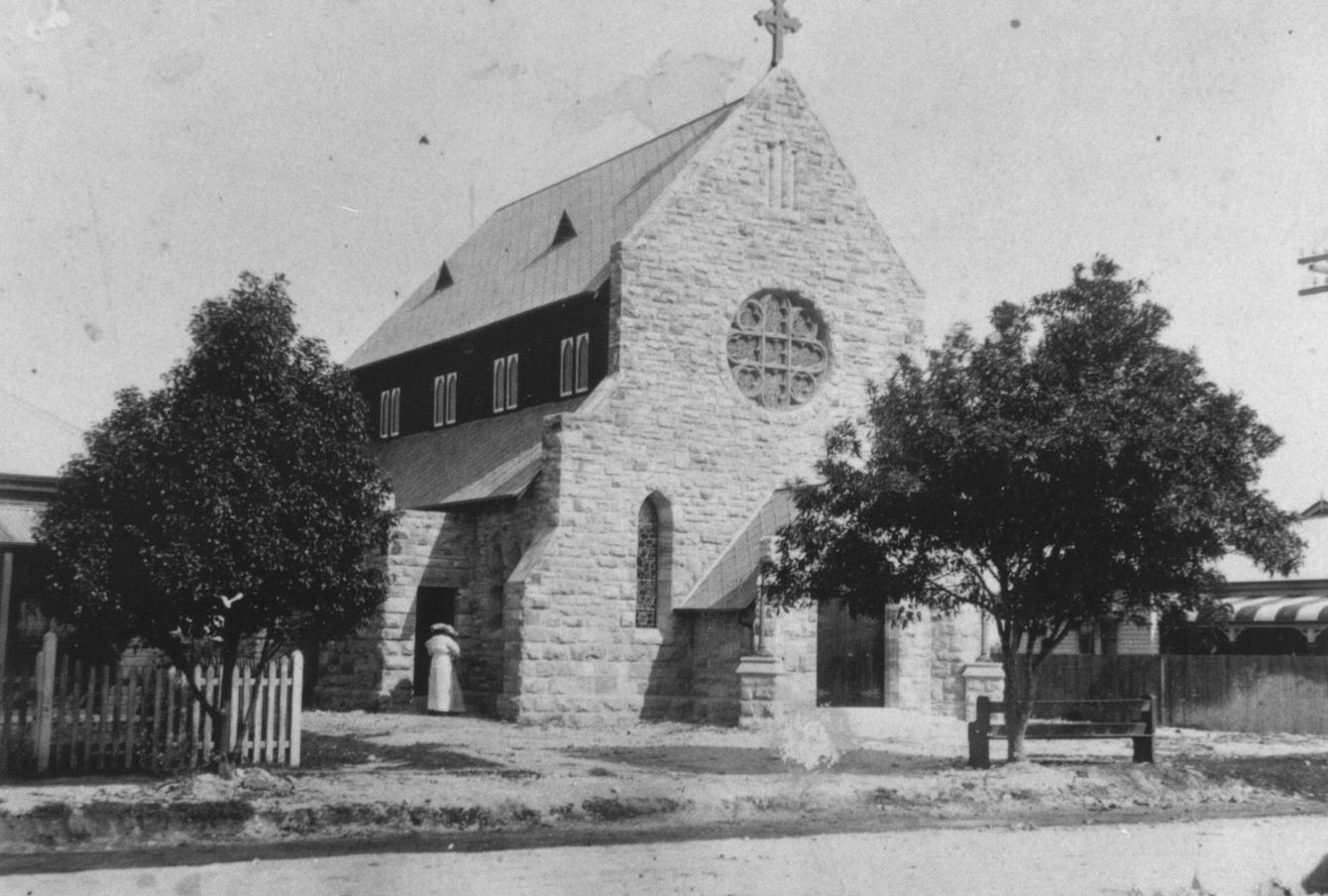
Alstonville St Barts c1913, courtesy Alstonville Plateau Historical Society
Meanwhile, his father's business was expanding:
CABINET: AND JOINERY BUSINESS.
NEW 'MACHINERY ADDED.
Yesterday afternoon at the invitation of Brown and Jolly, Ltd., there was a gathering of representative men belonging to the professional, commercial and industrial life of Lismore. at the firms factory in the centre of the' block to witness the official opening of new machinery plant recently installed by the firm in order to enable them to cope with the rapidly expanding character of their business. Hitherto all the driving power required by the firm was provided by steam, but if any business which depends upon power hopes to succeed in modern days of competition, the base of production-power-must be produced at the least possible cost. The limit of cheapness, so far as modern science has progressed, has been reached with steam. Other and cheaper forms, of producing power have reached an advanced stage of utility, and even if they have minor drawbacks which sometimes cu,\mc trouble, still the comparative cheapness ns against steam leaves a very large margin of profit by, their adoption. Brown and Jolly, Ltd.," have not only keen local competition, but have to compete with Sydney and Brisbane as well its with imported goods, hence they have found it necessary to replace their steam power with the much less expensive power produced by suction gna.
Yesterday afternoon the guests were met at the firm's factory, by Mr. James Jolly, senior, and afforded an opportunity of Inspecting the joinery works in full swing. To those who had not seen the works the extent of the operations afforded a surprise. On entering the factory the visitor is confronted with a network of bolting, shafts and counter shafts, while with the rattling of machines, as each si age is developed in the production of the finished article, one can hardly hear himself, speak. Every machine in the factory is driven by the one engine. ' The planing machine planes the frame pieces for doors and sashes, four sides at a time, and these pass through the machine with wonderful rapidity. " Straight from here they go to the morticing machine, then to the tcnoner and next to the beading and grooving machine. The rest is easy. . Just glue up the tenons, place the frame in the cramping -machine and the door is practically finished. All this is done Just while you wait, or In very little more time than it takes to describe the process. This was what the visitors saw yesterday, and this 'was what surprised so many.
.................
The other toasts were "The Press," proposed by Mr. Parker, and acknowledged by the representatives present, and "The Chairman," proposed by Mr. 'Jolly, and acknowledged by the Mayor. BROWN AND JOLLY, LTD. (1913, October 24). Northern Star (Lismore, NSW : 1876 - 1954), p. 4. Retrieved from http://nla.gov.au/nla.news-article72341111
Some of the Projects A Stewart Jolly undertook during these years shows his early style - including a few different versions for one P. G. Best:
RESIDENCE FOR P. G. BEST, LISMORE, N.S.W.
A. Stewart Jolly, Architect. . E. C. Saville, Builder.
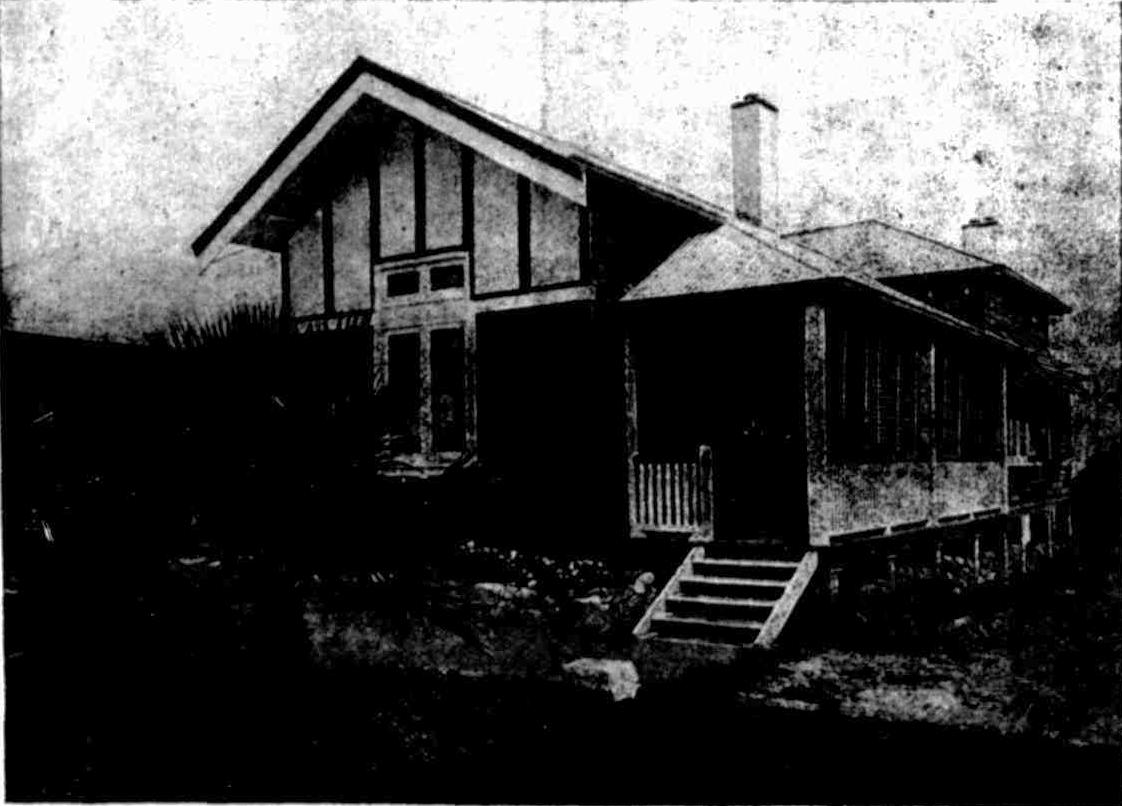
No title (1914, April 27). Construction and Local Government Journal (Sydney, NSW : 1913 - 1930), p. 6. Retrieved from http://nla.gov.au/nla.news-article118678308
£7,000 is the estimated cost of a 40-roomed brick hotel at Coff's Harbour (N.S.W.). Board and Jolly, of Lismore, are the architects. OPPORTUNITIES (1915, January 18).Construction and Local Government Journal (Sydney, NSW : 1913 - 1930), p. 10. Retrieved from http://nla.gov.au/nla.news-article109634422
RESIDENCE FOR P. G. BEST, LISMORE, N.S.W.
A. Stewart Jolly, Architect. E. C. Saville, Builder.
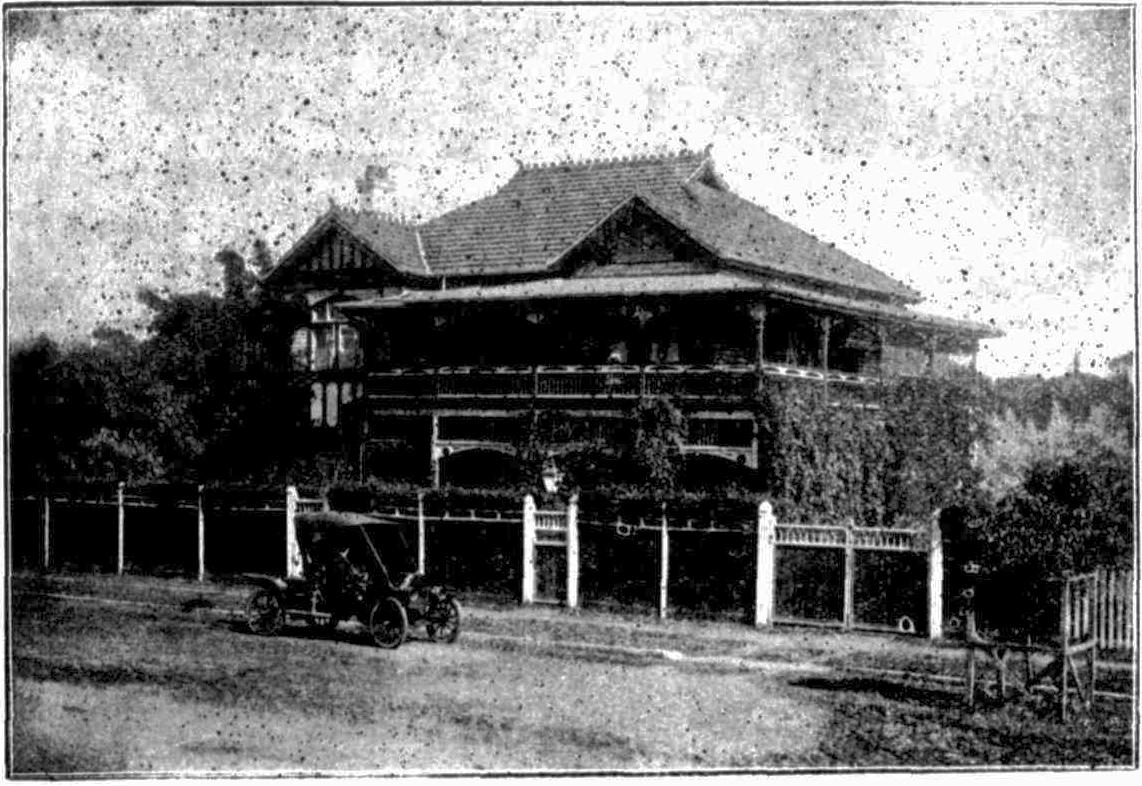
Australian Homes. (1915, December 17).Construction and Local Government Journal (Sydney, NSW : 1913 - 1930), p. 13. Retrieved from http://nla.gov.au/nla.news-article109633203
RESIDENCE OF MR. CHAS. ANSTEY, TREGEAGLE, RICHMOND RIVER
A. S. Jolly, Architect, Lismore A Ford, Builder
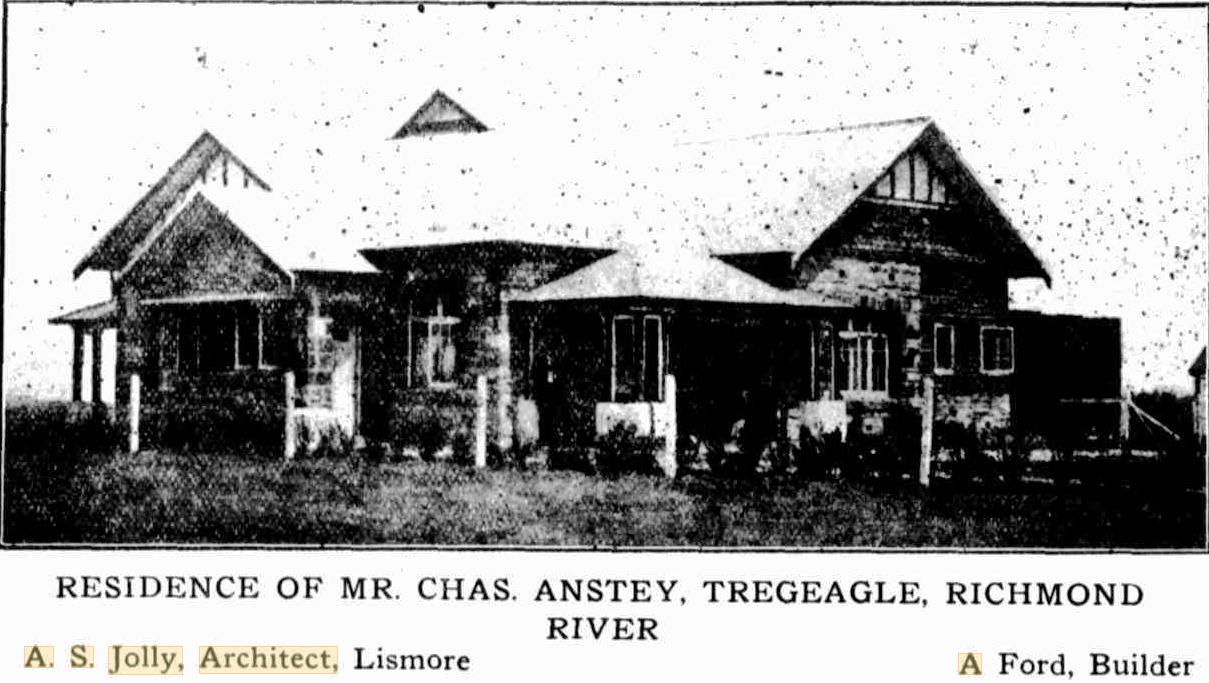
Australian Homes (1916, January 21).Construction and Local Government Journal (Sydney, NSW : 1913 - 1930), p. 13. Retrieved from http://nla.gov.au/nla.news-article109636529
TENDERS.
TENDERS are invited for the ERECTION and COMPLETION of large BRICK BUSINESS PREMISES, Bowraville. Plans and specifications may be had from the undersigned, to whom endorsed tenders should be sent on or before noon' on WEDNESDAY, MAY 31st.
Lowest or any tender not necessarily accepted.
A. STEWART JOLLY, Architect, Woodlark-street, Lismore.
TE N D E R S.
TENDERS are invited for the ERECTION and COMPLETION of HOTEL PREMISES, Tweed Heads. lans and specifications may be had from the undersigned, to whom endorsed tenders should be sent on or before noon of SATURDAY, MAY 27th.
The lowest or any tender, not necessarily accepted. ..
A. STEWART JOLLY, Architect, .Lismore.
NOTICE OF DISSOLUTION OF PARTNERSHIP.
NOTICE is hereby given that the partnership business hereby given that the partnership business herefore carried on between Frederick Johnson Board and Alexander Stewart Jolly as architects at Lismore, has this day been dissolved by mutual consent. All debts of the said partnership will be discharged by the said Alexander Stewart Jolly. All accounts due to the said partnership are payable to the said Alexander Stewart Jolly, whose receipts will be a sufficient discharge therefor.
Witness of hands this eighth day of May, 1916.
FRED. J. BOARD.
Signed in my presence by Frederick Johnson Board,—
Thomas A. Ferguson, 41st Batt., Captain.
ALEXANDER JOLLY. Signed in my presence by Alexander Stewart Jolly,—
F. Trench, Solr., Lismore.
NOTICE OF DISSOLUTION OF PARTNERSHIP. (1916, May 26).Government Gazette of the State of New South Wales (Sydney, NSW : 1901 - 2001), p. 2982. Retrieved from http://nla.gov.au/nla.news-article225962016
[Notice under Section 11 of the Bankruptcy Act, 1898.]
In the Supreme Court of New South Wales. (20,972)
IN BANKRUPTCY.
Re Alexander Jolly, of Woodlark-street, Lismore, N.S.W.
NOTICE is hereby given that a Sequestration Order has this day been made against the abovenamed bankrupt, on the petition of John Allibone, and Mr. W. H. Palmer appointed to be the Official Assignee.—Dated at Sydney, this 30th day of October, 1916.
F. H. SALUSBURY,
Registrar in Bankruptcy.
IN BANKRUPTCY. (1916, November 3).Government Gazette of the State of New South Wales (Sydney, NSW : 1901 - 2001), p. 6566. Retrieved from http://nla.gov.au/nla.news-article225963721
RESIDENCE FOR P. J. BEST, OF LISMORE
A. Stewart Jolly, Architect E. C- Saville, Master Builder
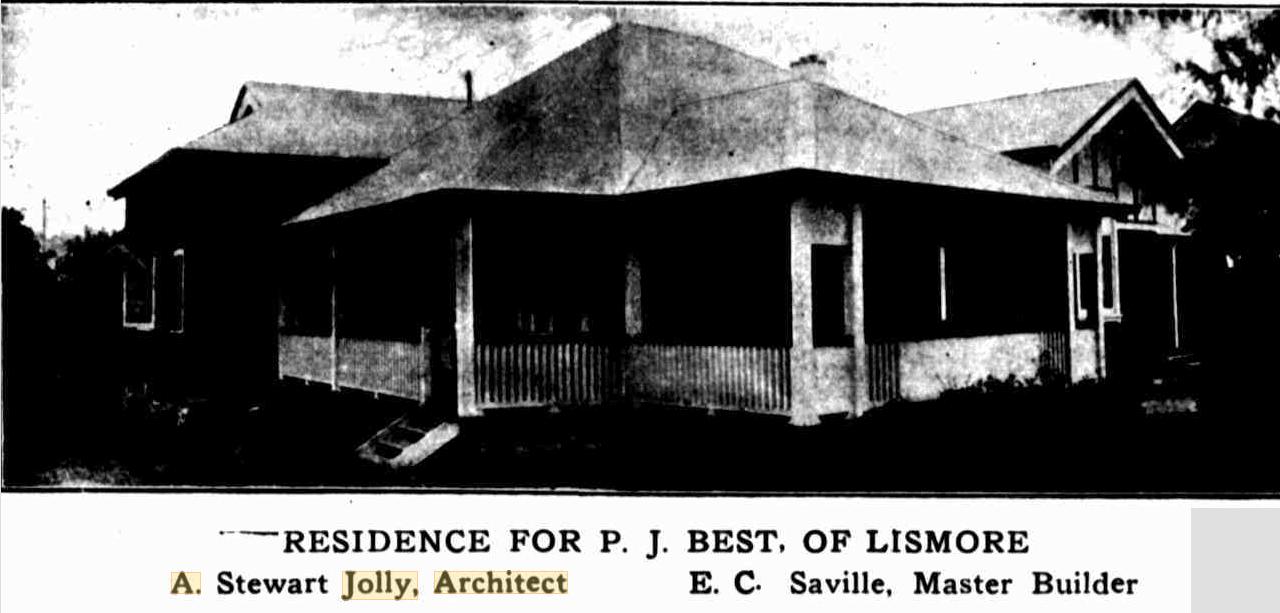
OPPORTUNITIES (1917, April 23).Construction and Local Government Journal (Sydney, NSW : 1913 - 1930), p. 13. Retrieved from http://nla.gov.au/nla.news-article109674009
The hammer falls:
IN BANKRUPTCY.
ESTATE OF ALEXANDER JOLLY.
The District Registrar, Mr. A. J. Peisley, held an examination at the Courthouse, Lismore, on Tuesday, in the bankrupt estate of Alexander Jolly. There were no proved creditors present. The statement of claims made on the estate read as follows: — John Alliboue. £517 Is 7d (admitted at £514 5s 4d); .A. E. Kearns, £12 (admitted); Max Wurcker, £3 12s 6d (admitted) ; W. E. L. Bcraiul, £2 7s (admitted) ; Puddicombe Bros., £4 11s (referred to official assignee); T. McDermott, £12 12s 9.1 (referred to official assignee); W. A. Taylor, £7 14s '(admitted); Turner and Henderson, £10 15s 6d (held over) ; Maloney and Wilson, £22 12s 9d (held over); S. Hacking and !Co., £5 10s 6d (held over); Gerard and Co., £2 9s 1d (held over); Frederick Wicks, £47 13s-6d (held over); W. M. Timberlake, £33 10 10d (held over); A. Lasker, £7 9s (held over). Total claims, £699 7s.
Bankrupt stated that his name was Alexander Jolly. He had contracted debts in the name of A. Stewart Jolly. He had filed a statement of his affairs and sent a copy to the official assignee. His occupation was that of architect. He had kept books on account of Board and Jolly. He had never been insolvent before, nor had he made any assignment for the benefit of creditors. He had not made any private arrangement. The partnership was dissolved about May, 1916. The cause of his bankruptcy was the influence of the war on his profession. There had been a slump in work in the office. He carried on business at Lismore and also had an office at Grafton. His operations also included the area between Murwillumbah and Kempsey. He generally resided at Lismore.
He commenced business in 1911 and had no capital. He had no money in hand at the date of his petition. Mr. Board, with whom he had been in partnership, left and thought it advisable for him (Jolly) to carry on himself until the war was over. The bankrupt took over the assets and liabilities of the firm, and had since discharged some of the liabilities. In respect of the partnership there was now a liability of about £50 which he had to pay. The books were in Board and Jolly’s office at the present time. He was taking them to Sydney on the 13th. He had paid £7 to an accountant in respect of his bankruptcy. He had negotiable securities in the shape of a half interest, in five £10 shares in the Electric Lighting Company of Lismore. His life was insured for £1000 in the A.M.P. Society, the policy having been taken out in 1914. It was a life policy, and was in his possession. No rent was due in respect of the premises occupied by him. There was a judgment for £514 against him. He had mortgaged a third of his interest in Rogers' subdivision at Coff's Harbor for £350. He had made no settlements before or after his marriage. He had mortgaged a property of his at Byron Bay to the Commercial Bank for £500, and he had bought some land at Cronulla on terms and had mortgaged it for £14. He had given no notice to any of his creditors that he was unable to meet his liabilities, and he had never called a meeting of his creditors. He had not contracted any debts since he was aware of his insolvency. For the last three years his salary was about £700 per year, and his expenses, including investments, had taken up all his income. He could not make any offer to pay his creditors by instalments. He had banked with the E.S. and A. Commonwealth and Government Savings Banks, Lismore. He was a married man and his wife had accounts in the Commonwealth and Government Savings Banks, Lismore. There was an overdraft at the E.S. and A. Bank. His wife had separate property. He had three children under age, who had small amounts, totalling not more than £5, in the Savings Bank His wife had put the money there for them. He had sold part of his Coff's Harbor property to John Jolly, sen., for £350. The examination was declared closed.
IN BANKRUPTCY. (1917, January 11).Daily Examiner (Grafton, NSW : 1915 - 1954), p. 2. Retrieved from http://nla.gov.au/nla.news-article195773686
As seen above, Mr. Jolly came back to Sydney in early 1917 and commenced working here. Some of these projects included:
UNDATED CONTRACTS
Palm Beach.— Erection of week-end cottage, Ross and Rowe, 350 George-Street.
Balmoral. — Erection of cottage; A. S. Jolly, 1 Bond-street. BUILDING, INDUSTRY & MACHINERY (1917, November 5). The Sun (Sydney, NSW : 1910 - 1954), p. 7. Retrieved from http://nla.gov.au/nla.news-article221393205
Balmoral. — Erection and completion of residence, Lavoni Street, Balmoral. A. Stewart Jolly, architect. BUILDING AND TENDERS. (1917, November 20). The Daily Telegraph (Sydney, NSW : 1883 - 1923), p. 3. Retrieved from http://nla.gov.au/nla.news-article239243848
Epping -Erection of two cottages, Mr A Stewart Jolly architect 1 Bond street. TENDERS. (1918, May 29). The Sydney Morning Herald (NSW : 1842 - 1954), p. 6. Retrieved from http://nla.gov.au/nla.news-article15769749
The residence listed as being at Lavoni Street, Balmoral is one where we see his fusion of local stone and wood. In Noonee in Balmoral, New South Wales, built in 1918-1919, Mr. Jolly explored the American hunting lodge, which was a requirement of the client. This hunting lodge used masonry and rustic timberwork, a type of materiality first seen in this house.
A. S. Jolly also designed items for the interiors of his buildings. He began with built-in furniture, and also developed labour saving devices. In Noonee he designed a dining table that slid on rails into the living space from the kitchen. In Belvedere (1919 - 7 Cranbrook Avenue, Cremorne) he designed a rotating servery cupboard between the kitchen and dining room, while In Hy-Brasil/The Gem, it was a bread oven, later converted by Mr. Herman to storage space.
Noonee-1.jpg?timestamp=1517185061895)
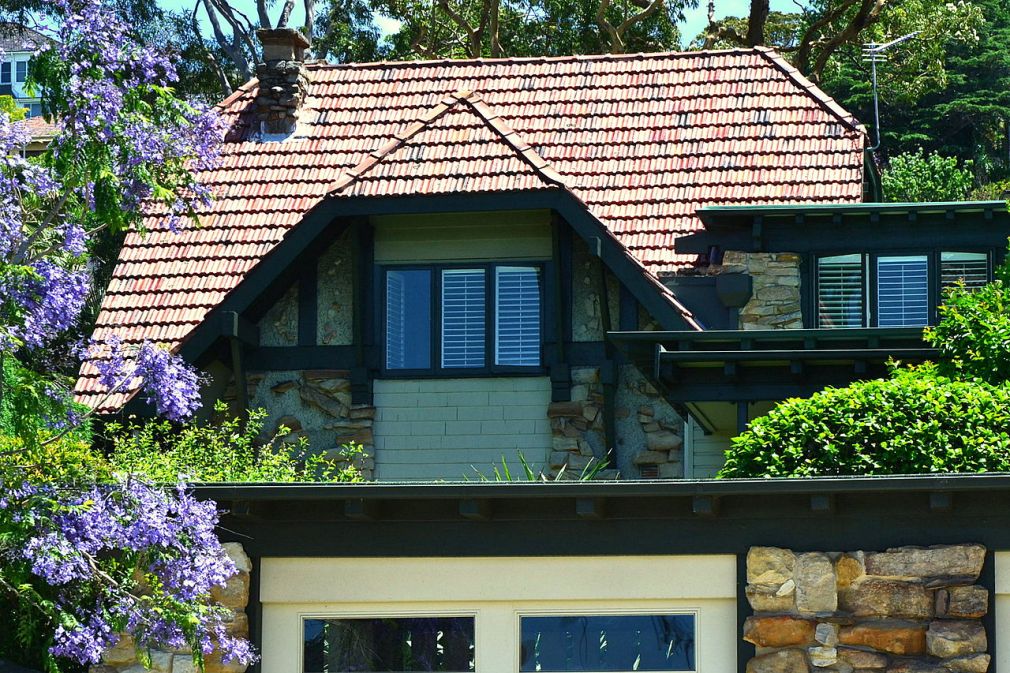
Noonee, Balmoral, Sydney, designed by Alexander Stewart Jolly - photo s by and courtesy Sardaka 2012.
‘Belvedere’ was built for Christian Stockman, one of many wealthy pastoralists and graziers who built ‘city’ homes in the Mosman, Cremorne, Neutral Bay, Palm Beach and Kirribilli areas. Cranbrook Avenue was in the newly subdivided Cremorne Heights Estate.
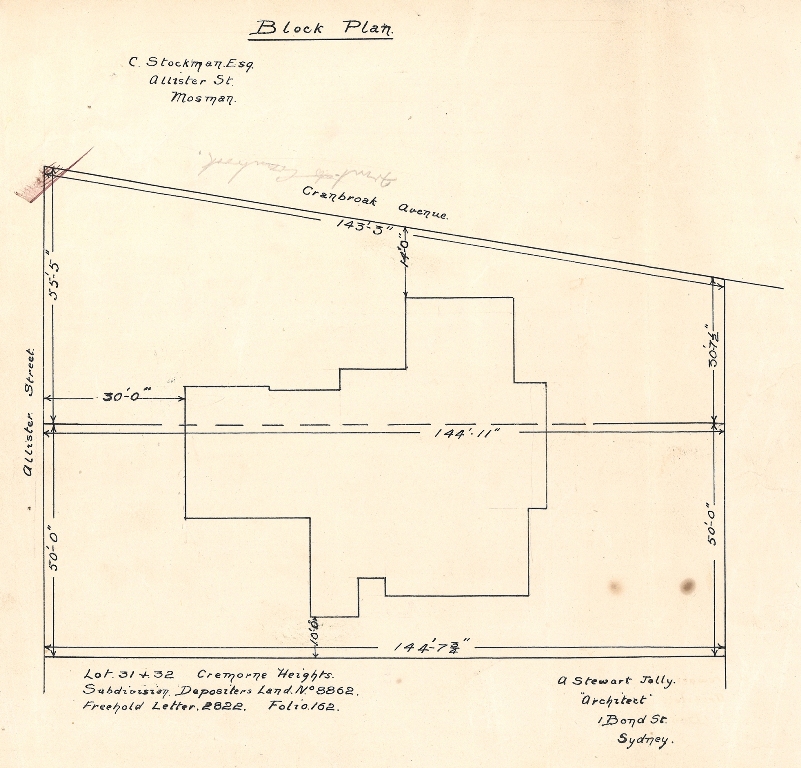
‘Belvedere’ took up two blocks - Lots 31 and 32. At the base of this drawing you can see Mr. Jolly still has his offices at 1 Bond Street, Sydney.
‘Belvedere’s dramatic horizontal roof planes owe as much to Frank Lloyd Wright’s ‘Prairie’ houses as the work of Greene and Greene, the major innovators in the Californian Bungalow style, which were clearly an innovation in homes Mr. Jolly was following during these years.
The rough cast masonry recalled earlier Arts and Crafts houses but ‘Belvedere’s’ walls were coloured white, providing a simple contrast with the dramatic roof planes and dark timber. In 1925 it was described as a type of Californian Bungalow, ‘a style very suitable for Sydney and Melbourne... artistic and pleasing’. In later years it was appreciated as a forerunner of Modernism.
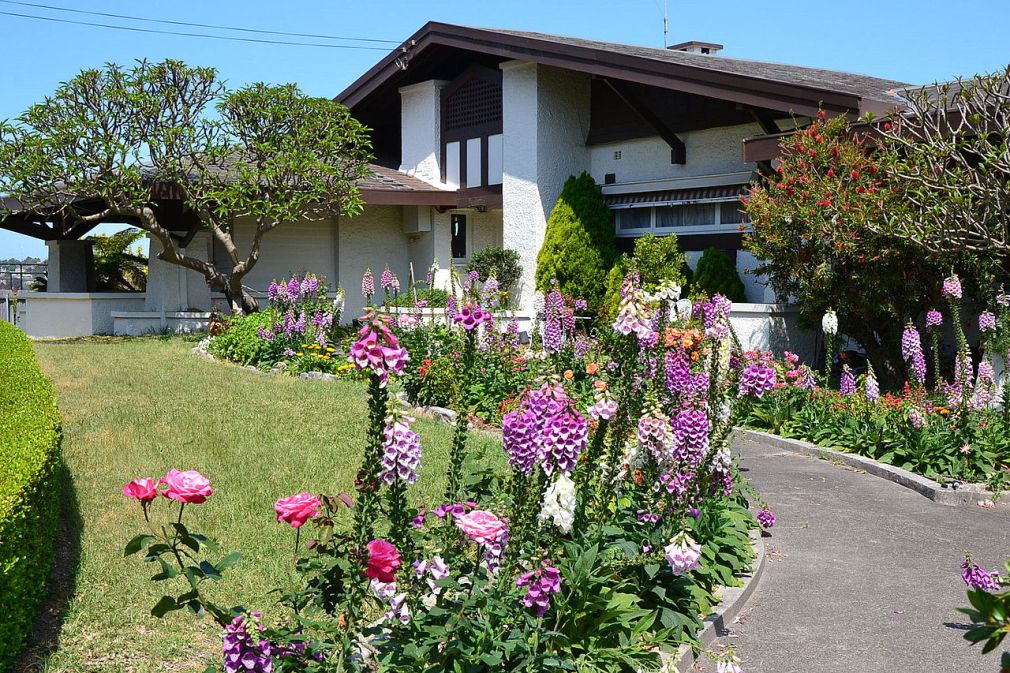
Belvedere, Cremorne - photo by and courtesy Sardaka.
Jolly retired from his city practice in the mid-1920s and went into selling land in 1926, as stated in the above articles. The homes built in stone and timber at Avalon stem from 1929 and into the early 1930, as part of a venture into land speculation, and while still associated with Mr. Dalwood. In Spirit of the Bush you may read about references of 'returning to the cave' where the family were living - this may also refer to any of the homes he was then building, particularly when a reference to the 'Palmgrove', near the Clareville and Chisholm homes of Hy-Brasil, Careel House and Loggon Rock or Stonehaven, Taylor's Point are viewed or taken into account. These were indeed stone-havens for the man and his family, who is reported to have lived on-site during construction of these premises.
A. Stewart Jolly had a great and continued interest in organic architecture. He was influenced heavily by Frank Lloyd Wright’s work in America, especially the way Wright used the outside environment to play a role in the building. Mr. Jolly’s work contrasted with the stark concrete-steel-glass modernism of the time. His work and buildings focussed on the appreciation of organic forms and materials. He studied the landscape and the shapes inspired by nature, such as timber, stone, wrought iron and brick. Another influence would have stemmed from a trip to Perthshire, Scotland in his late teens, where he encountered the craggy stone inglenooks that would later be a strong feature in his Avalon buildings, particularly the 'bread oven' at Hy-Brasil.
An inglenook (Modern Scots ingleneuk), or chimney corner, is a recess that adjoins a fireplace. The word comes from ingle, meaning "fireplace" in Old English (from Old Scots or Irish aingeal, "angel" or euphemistically "fire"), and nook.
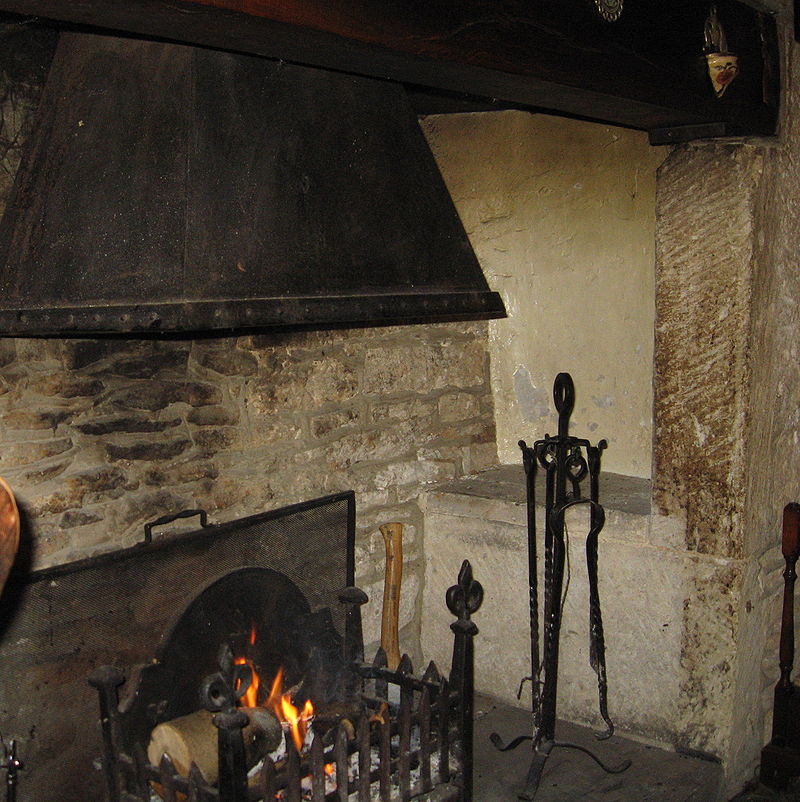
17th century English inglenook fireplace. Photo by and courtesy Jongleur100.
Still around too is Nebraska, the much-renovated 1921 Alexander Stewart Jolly-designed bungalow at Gordon. Some say its low-pitched gable roof with dark-stained vertical timber boarding and superb interior timber joinery closely resembles the American West Coast stick style of Greene & Greene's Gamble House.
Ill-health, or too much of the good-life and a problem with alcohol caused A Stewart Jolly to suffer from ill health. By 1926 he had turned to selling land.
QUARTER SESSION.
Alexander Stewart Jolly, by wanton driving cause bodily harm; Leo Sammit, receiving. QUARTER SESSION. (1925, November 7).The Sydney Morning Herald (NSW : 1842 - 1954), p. 12. Retrieved from http://nla.gov.au/nla.news-article16253272
MOTORIST ACQUITTED
Alexander Stewart Jolly, architect, pleaded not guilty in the Quarter Sessions yesterday to a charge of having caused grievous bodily harm to Agnes Paullson by the wanton driving of a motor car. The jury returned a verdict of not guilty, and the accused was acquitted. MOTORIST ACQUITTED (1925, November 10). The Labor Daily (Sydney, NSW : 1924 - 1938), p. 1. Retrieved from http://nla.gov.au/nla.news-article238113334
As can be seen by the above car accident report, the drinking did not cease. Problems, too, with money led to his second bankruptcy:
Local Bankruptcy; Case
On Monday, 10th instant, Mr. N. C. Loekhart, Registrar in Bankruptcy, made an order sequestrating the estate of Alexander Stewart Jolly, of Chatswood, at the petition of John McGrath, of Boorowa.
Mr. McGrath had bankruptcy proceedings instituted after obtaining a final judgment against Jolly in the Supreme Court in July last Mr. R. S. Phillips, of Howard, Phillips and Co., solicitors, Yass, appeared for Mr, McGrath.
Local Bankruptcy Case (1927, October 21). The Burrowa News (NSW : 1874 - 1951), p. 4. Retrieved from http://nla.gov.au/nla.news-article102490229
In the Supreme Court of New South Wales. (26.725)
IN BANKRUPTCY.
Be Alexander Stewart Jolly, of Dilworth, Silvia-street, Chatswood.
NOTICE is hereby given that the First Meeting of creditors in the above matter will be held at the Courthouse, Booroowa, before the District Registrar in Bankruptcy, on the 22nd day of December, 1927, at 9.30 a.m.. or as soon after as the course of business will permit, to entitle a creditor to, vote thereat, his proof must be lodged with the Registrar in Bankruptcy, Elizabeth street, Sydney, not later than the 15th day of December, 1927,
N. C. LOCKHART,
Registrar in Bankruptcy^ Official Assignee—William Harrington Palmer. IN BANKRUPTCY. (1927, December 2).Government Gazette of the State of New South Wales (Sydney, NSW : 1901 - 2001), p. 5588. Retrieved from http://nla.gov.au/nla.news-article222998100
It is around the time the below article runs that the Jolly Family moved to Avalon Beach - details of this episode in his life are related by him, in some ways, in his book he wrote for his Children - The Spirit of the Bush, copy below. Adrift at Sea was published the same year - 1932. The Spirit of the Bush, speaks of Avalon and Careel Bay and the times Mr. Jolly was working on and building, whilst living on site, Loggan Rock Cabin and Careel House.
Geoff Searl OAM, President of the Avalon Beach Historical Society, also holds records which show in 1934 the Wickham’s had built their own store on the diagonally opposite corner, where the wine store now stands. In fact the Wickham's owned the whole shopfront's from Old Barrenjoey Road up to where Wickham Lane is now.
What also comes through in these works is a genuine love of the bush and natural materials, proving you can take the boy out of the country but you can't take the country out of the boy - Avalon must have been a refuge for him, a place alike where he grew up; with loads of trees, water, and fresh good food available during the times of want many experienced during the early years of the Australian Depression of the 1930's.
This was Alexander Jolly's only commercial commission was store for the Wickhams on the corner of Avalon Parade and Old Barrenjoey road. Geoff states - 'Architecturally unexceptional but for the expression of structural timbers supporting the tiled awning and the rough-cast walling called 'pebble-dash'. It was also the first building constructed above flood levels, saving it from the inundation experienced by nearby buildings.'
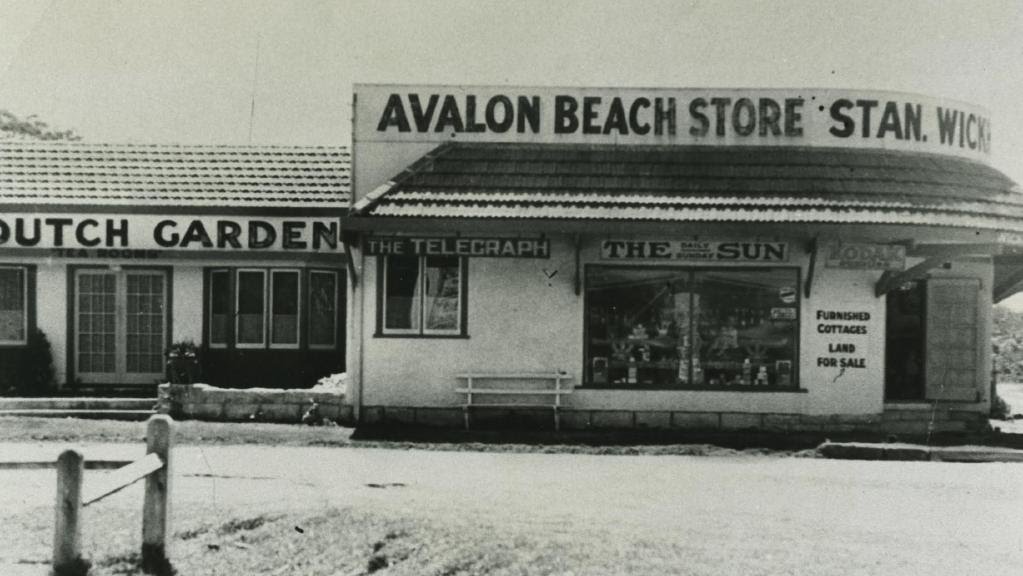
Wickham store - Circa 1934. Photo: ABHS
The association with Mr. Dalwood goes back further than the Avalon Beach land sales:
JOLLY WELL BROKE
Chopped Off Top of Finger to Remind Himself He'd Taken the Pledge
ALEXANDER STEWART JOLLY, Sydney estate agent, in need of a drink at often as the dry Sahara, wanted to become a teetotaller — so he cut off the top of the little finger of his left hand as a reminder to dodge the pink and vermillion demons that lurk in bottles.
If Jolly, who is a bankrupt, and appeared in the Bankruptcy Court the other day, had been single, he would have kept that finger joint, and stuck to the old methods of chasing an obstinate thirst. But the fact that he was married made all the difference.
He promised his wife once that he would be a good boy — and broke the premise. Doubtless she reminded him about it, and then to the axe he went, perhaps following no directions given in the book titled, 'Every man his own doctor.' Anyhow, he didn't make a bad job of it.
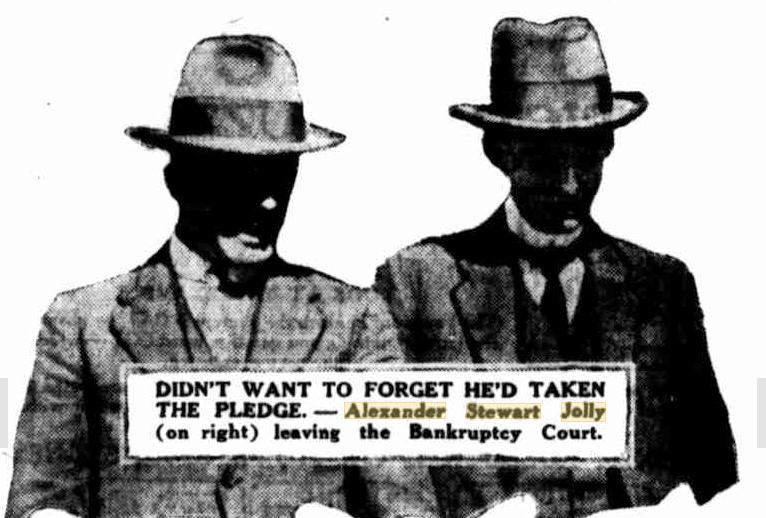
DIDN'T WANT TO FORGET HE'D TAKEN THE PLEDGE. — Alexander Stewart Jolly (on right) leaving the Bankruptcy Court.
Jolly, before his home performed surgical operation, must have been one of those jolly old soul's who reckon that one good drink always deserves another —something like old King Cole, and the rest of the thirsty tribe whose favorite anthem at the dose of a convivial gathering is, 'Show me the way to go home.'
Jolly, In fact, admitted as much during the course of his examination in court on the whys and the wherefores of his state of being broke. He liked Jolly company, was never averse to spending a bob, and an hour or two, with the boys warming the cockles of his heart in the nearest hostelry, and basking in the warming smile of the fair Hebe behind the bar counter.
Drink brought Jolly a lot of trouble, but it didn't play any part at all in sending him insolvent. His own trade -selling land— did that his dealing with would-be owners of real estate brought some caustic cross-examination from Mr. Symonds, who appeared for some of his creditors, and Official Assignee Palmer.
These people, who live at Burrowa, bought blocks of land at Loftus, near National Park, from him, but didn't get their title deeds. They wanted their cash back, or their land. Jolly made certain stipulations which were rejected, and so one of them sent him bankrupt.
Mr. Palmer questioned the jolly old Jolly on his proclivities for looking on the wine when it was red. 'I was very fond of convivial company,' said Jolly.
'And that was your trouble?' 'It caused me a good deal of trouble,' Jolly replied quietly. 'I would have become a permanent drinker,' he confessed, 'if I had not pulled up as I did. I used to take Quinol with my drink.' What Quinol was nobody could find out Mr. Palmer had never heard of it, and in his line he hears a lot of strange things. 'Where does it come from?' he asked. 'America?' 'Mrs, Jolly thought I would never give it up. I tried, and broke out again. When I broke my resolution I cut my little finger off. I knew that would be ever present, and would remind me not to drink.'
He had been bankrupt before, but had obtained a certificate. His first land deal after that was at Cronulla with an estate that roped him in £2000, he told Mr. Symonds. It was a good start on the road to affluence, but Jolly soon lost his way, and arrived at a dead-end Instead. For a start he bought a Buick car, and then paid a deposit on an estate at Loftus, taking the property over from one Dodds. The deposit was £100, and he had twelve months in which to pay it off. The rest of the £1000 he used in sending a flock of go-getters into the country to paint pretty pictures of the landscape around National Park, and to conjure up visions of what Sydney will be like in another twenty years. Mr. Symonds questioned him a lot on this little bit of business, and learnt that Jolly sold the contract of the Loftus land to Dalwood, and paid Dodds right out for the estate. Mr. Symonds literally bombarded him with questions, and it transpired that he sold 46 blocks to 40 persons, and out of these, eight didn't get their deeds. Jolly was further examined at length on Thursday morning, and the cast was then adjourned for the week. JOLLY WELL BROKE (1928, February 26).Truth (Sydney, NSW : 1894 - 1954), p. 22. Retrieved from http://nla.gov.au/nla.news-article168695901
The above image does not really give us a good photo of Mr. Jolly - elsewhere he has been described, at this age, as "Lean, slightly stooped, 5 ft 11 ins (180.3 cm) tall, with grey eyes.."
NOVEL PLEDGE.
BANKRUPT'S ACTION.
CUT OFF' A FINGER.
"I have been fighting the drink for a considerable time," remarked Alexander Stewart Jolly, under examination before the Registrar In Bankruptcy, “and on June 3 I made up my mind that I would not have another drink I marked the resolution on myself by cutting my little finger off. It was more to prove to Mrs. Jolly that I was serious I was not quite sure when I had taken the resolution I would be able to keep it, and If I had a mark In front of me to remind me it would strengthen my resolution.
Jolly further stated that he was an architect by profession, but for the last seven years had been a real estate agent He also dealt in real estate on his own account by way of speculation He thought ho was always sober when in the car In a case at North Sydney he was charged with driving a car when under the Influence of drink He was at one time very fond of anything of a convivial nature, and would have become a permanent drinker if he had not pulled up when he did on June 3 last. He was previously bankrupt In October, 1916, when his liabilities were J32350 He heard the official assignee say there was a dividend of 1/13 in the £1 He received his certificate in 1910. His first Independent land transaction since he obtained his certificate was at Cronulla, out of which he received shares to the extent of £7000. He put no money in, but distributed the estate. He made £2000 out of another estate, and put It out In placing moe In the country, selling land.
The examination was adjourned to March 15, bankrupt being ordered to file accounts in the meantime. NOVEL PLEDGE. (1928, February 24).The Sydney Morning Herald (NSW : 1842 - 1954), p. 12. Retrieved from http://nla.gov.au/nla.news-article16444350
SUPREME COURT
IN BANKRUPTCY
Before Mr. Justice Long Innes in the Supreme Court, Sydney, motion under Section 134, Alexander Stewart Jolly, ex parte W. H. Palmer, official assignee; Albert E. Dalwood, respondent.
This was an application under section 134 of the old State Bankruptcy Act on behalf of Mr. W. H. Palmer, official assignee of Alexander Stewart Jolly, for an order that the respondent should account to the official assignee all the estate, title, and interest in certain allotments of land in the National Park Estate, near Loftus, transferred to him by the bankrupt; or in the alternative that the respondent should account to the official assignee for any moneys realised by him' by the use or disposal of the allotments since they were transferred to him. and that the respondent should convey to the official assignee the two allotments of land transferred to him by Kathleen Wilhelmina Jolly on behalf of the bankrupt; or in the alternative that he should account to the official assignee for any moneys realised by him by the use or disposal of the spiii allotments, since they had been transferred to him by Mrs. Jolly.
Material Misrepresentation.
The application was based on the grounds that the transfers were preferences in favour of the respondent; that they were voluntary settlement's; that they were acts of bankruptcy t-the knowledge of the respondent; that the transfers were obtained by the respondent by material misrepresentations, whereby the bankrupt and his wife were induced to convey the lands to him; that the transfers were, to the knowledge of the respondent, a fraud upon the rights of numerous' persons who were partially-paid purchasers of the lands from the bankrupt; and that the transactions between the respondent …inequitable and unconscionable, and should be rescinded.
Mr. Norman Pilcher (instructed by Messrs. Howard, Phillips and Co; of Yass, by their Sydney agent, Mr. Basil Smith) appeared for the .official assignee; and Mr. Weston and Mr. Henry (instructed by Mr. W. H. Drew) for the respondent, who opposed the application. The case is part heard.
Lengthy Proceeding. [Note. — The motion reported above is the last stage in the lengthy proceedings which have been conducted by Messrs. Howard, Phillips and Co,, on behalf of Mr. H. Best, of Tangmangaroo, Miss Dwyer, of Burrowa, and Messrs. Rolfe and McGrath, ol Burrowa, in connection with certain allotments of land The Loftus.
In 1926 Alexander Stewart Jolly, a real estate agent, of Sydney, visited the Yass, Burrowa and Young districts, and sold a number of the above allotments of land to local residents: Before the purchasers were able to get their deeds, Jolly transferred the land known Sydney property owner. Supreme Court writs were issued on behalf of Messrs. Best, Rolfe and McGrath, and subsequently, Jolly was made bankrupt and examined under Section 30 of THE 'Bankruptcy Act, 1898, at the instance of these gentlemen. On the advice of the barrister briefed in the case, the Official Assignee of the bankrupt estate of A. S. Jolly, instructed Messrs. Howard, Phillips and Co. to bring the above motion before the court with a view to forcing Mr. Dalwood to retransfer the land in question to Mr. Jolly's bankrupt estate and thereby enable Messrs. Best, Rolfe and McGrath and Miss Dwyer to get their purchase money back.] SUPREME COURT (1929, September 20).The Burrowa News (NSW : 1874 - 1951), p. 7. Retrieved from http://nla.gov.au/nla.news-article102365980
£27,000 INDEMNITY
DALWOOD'S APPEAL FAILS
In a reserved Judgment delivered to-day, the Full Court unanimously dismissed with costs the appeal of Albert Edwin Dalwood against a decision of the Chief Judge in Equity (Mr. Justice Harvey), that an indemnity of £27,000 he made by Dalwood to Hugh Donald Mcintosh, M.L.C., against payments of that amount due by him to the Teasdale Smith estate. The Bench consisted of the Chief Justice (Sir Philip Street), Mr. Justice Owen and Mr. Justice Long-Innes. Mr. L. S. Abrahams and Mr. T. T. Honery (Instructed, by Mr. W. H. Drewl … £27,000 INDEMNITY (1930, June 4). The Sun (Sydney, NSW : 1910 - 1954), p. 7 (LAST RACE EDITION). Retrieved from http://nla.gov.au/nla.news-article224273394
A. E. DALWOOD'S ESTATE
SYDNEY, Tuesday.
Albert Edwin Dalwood, a well-known Sydney investor, who in June last assigned his estate for the benefit of his creditors, was examined to-day under section 80 of the Bankruptcy Act before the registrar Mr. Norman Lockhart.
Dalwood, who some years ago was reputed to be one of the richest men in the State, disclosed contingent liabilities at £294,000, unsecured creditors £89,000, secured assets, £50,000 and ordinary assets £137,000.
The Registrar adjourned the examination to allow the parties to confer. A. E. DALWOOD'S ESTATE (1932, February 10). Northern Star (Lismore, NSW : 1876 - 1954), p. 12. Retrieved from http://nla.gov.au/nla.news-article94270513
In 1933 he was among those involved in the construction of the Avalon Beach surf club, even presenting plans (unfound) and a proposal that the clubhouse should be built mid-beach - not at the southern end, where it is today - from Warringah Shire Minutes of Meetings:
27/3/1933: At this stage the ordinary procedure was suspended to allow Mr. Jolley, representing the Avalon Beach Progress Association, to submit plan of proposed Clubhouse and dressing accommodation at Avalon Beach, estimated to cost: £750 - That the matter be referred to "A”-Riding Councillors to-report on to next meeting. (Crs. Sterland, Austin) In reply to Cr. Hughes, Mr. Jolley stated that the Avalon Beach people would have no objection to Mr.B. W. Ford.'s plan (also submitted to this meeting) provided the Council approved of it, and that it should be erected for £750. He also stated that whichever plan was adopted; the Avalon people did not propose to contribute anything towards the work- 57. Avalon Beach SLS Club,. 20/3/33:requesting that Mr. D. Bartlett, a paid-life saver on Avalon Beach, be appointed a Beach Inspector. Resolved; -That Mr. Bartlett be appointed a Beach Inspector under Seal of the Council. (Crs. Austin Ritchie) 65. Bertram W. Ford -Architect 20/3/33, submitted amended plan for dressing shed-and-Clubhouse on Avalon Beach at estimated cost of £750 and recommending that a charge be made for admission to the sheds to make buildings revenue producing. Mr. Ford was in attendance, stated that A. J. Small requested him to represent him in the matter, that If the plans submitted by him were Adopted, Mr. Small would-grant the use of his pumping plant, and would find £200 towards the cost of the building, if required, that he (Mr. Ford) was- Prepared to interview Mr. Hawkins, Assistant Minister for Labour & Industry, in support of the Council's application for A building loan for Avalon Beach, and also for North Curl-Curl: In reply to Cr. Hughes, he stated that he could erect the building in accordance with the plan Submitted for £750. -Resolved, - That the Council apply for a loan of £750 for the surf building at Avalon Beach in Accordance with Mr. Ford's plan,- and also a loan of £600 for a Surf Clubhouse at North Curl Curl Beach. (Crs, Hughes Austin)
3rd of July 1933
1., Proposed surf buildings at Avalon Beach Reserve: Ford, Architect, submitted in person two Plans) the proposal being a cutting down of the first, proposal to bri\2g Building :He had obtained the estimated cost. within the limit, of tenders for the two proposals alternatively:-for the reduced proposal the lowest' tender was that of: H. Cardow's L8749.10.0, and for the major proposal the lowest was 941.5.0. He explained the difference between the two proposals. Resolved,- That H. Cardow's tender be accepted with the addition. of £10 for the water-proof flooring, subject to the contract being suitable to the Council. (crs. Austin, Barber) Messrs. Stevenson, Jolly and Wickham, representatives of the Avalon Progress Association, and a Mr. McNeil were admitted and informed of. The Council's decision. Mr.. McNeil addressed the Council, stated he represented the biggest selling organisation in the Shire, and pressed for the adoption of the major proposal Mr. Stevenson said his Association desired him to affirm that the expenditure of £750 was adequate for the time being. He further said that it was the Association's ambition to repay to the Council the whole 750. It was decided that the two lowest tenders be forwarded to the Local Government Department, and also the plane and specifications on which they were based for adoption by the Department in lieu of those previously approved. The representatives from Avalon thereupon left the meeting.
Monday 31st of July 1933
Properties At this stage a letter from the. Avalon Beach Progress Association, advising that the Association was of the opinion that the new surf Buildings for Avalon Beach should be erected on the site originally selected, was called for. Mr. Ford, Architect, and Mr. A.J.Small, who were present, addressed the Council, and contended that it should be removed to a position further north. Mr. Jolly, on behalf of the Progress Association, protested against this. Mr. Small stated that if the building were erected in a central position, as suggested by him, he would be prepared to turf about one acre of the area with Buffalo sods, and carry out improvements that would cost him £100. Cr. Barber moved that if Mr. Small will give in writing that he is prepared to turf about one acre at his own expense, as offered by him, and also that he is prepared to bear any cost of the building in excess of £750, the site recommended by accepted. Cr. Austin seconded. The motion was not-put and it was resolved that the Councillors for A. Riding meet Mr. Small and :the Progress Association for 'the purpose of finally selecting a site.
From the papers - two announcements of a club forming at Avalon Beach, one in 1925 and the other in 1933:
A CLUB FOR AVALON.
A surf life-saving club has been formed at Avalon, the spot rendered famous by the song, or vice-versa. A meeting was held on Sunday at the residence of Mr. H. J .Small, who was appointed president. Mr. Stan Wickham the Rugby Union International, is hon. secretary-treasurer of the new club. THE SURFERS. (1925, March 13 - Friday). Arrow (Sydney, NSW : 1916 - 1933), p. 12. Retrieved from http://nla.gov.au/nla.news-article103545114
Mr. H. Ruskin Rowe has taken the presidentship of the newly-formed Avalon Beach club. Mr. Stan Wickham, old Rugby Union footballer, is honorary treasurer, and Mr. A. Stevenson is honorary secretary. Following a report by Ken Hunter, captain of Palm Beach club, an association Instructor is to visit Avalon at an early date to give the necessary instruction to the club. Ted Hock, late of Coogee club, is manager of the golf links at Avalon. INQUIRY IN PROGRESS (1933, March 22).The Sun (Sydney, NSW : 1910 - 1954), p. 3 (LAST RACE EDITION). Retrieved from http://nla.gov.au/nla.news-article229055532
The beginning of Hy-Brasil or 'The Gem':
NOTICE UNDER REAL PROPERTY ACT.
APPLICATIONS have been made to bring the lands respectively described under the provisions of the Real Property Act. Caveats may be lodged on or before the 16th March, 1934:—
No. 31,693. Kathleen Wilhelmina Jolly, 6 a. 2 r. 35 ½ p., lot 7a of Villa Sites, Pittwater Estate, Hilltop-rd., Pittwater. NOTICE UNDER REAL PROPERTY ACT. (1934, February 9). Government Gazette of the State of New South Wales (Sydney, NSW : 1901 - 2001), p. 720. Retrieved from http://nla.gov.au/nla.news-article223050729
In the late 1930s A. Stewart Jolly joined Mr. Dalwood in successful land dealing on the New South Wales south coast.
In 1939 his eldest daughter Mavis married Noel Stanley McCaw - marriage registered at Chatswood.
MCCAW-JOLLY.
A GOWN of Ivory Chantilly lace over taffeta was worn by Miss Mavis Jolly, eldest daughter of Mr. and Mrs. A. S. Jolly, of Chatswood, at her wedding to Mr. Noel Stanley McCaw, eldest son of the late Mr. M. M. .McCaw and of Mrs. McCaw, of Willoughby, which took place at St. Andrew's Church, Chatswood, on Saturday. The Rev. A. J. Parker officiated. The bride's cut tulle veil was hold in place by a coronet of pearl orange blossom, and her bouquet was of lily of the valley and hyacinths. Misses Kathleen and Betty Jolly, who were bridesmaids, wore old world frocks of white net over taffeta, the hemlines banded with cyclamen velvet ribbon. Their short tulle veils fell from haloes of cyclamen flowers to match their bouquets. Mr. Man Hampton was best man and Mr. Fletcher Dixon groomsman. The reception was held in the Memorial Hall, Chatswood. Mr. and Mrs. Noel McCaw will make their home in Melbourne.
Family Notices (1939, August 28). The Sydney Morning Herald (NSW : 1842 - 1954), p. 4. Retrieved from http://nla.gov.au/nla.news-article17607936
Second daughter Kathleen married in 1943:
NEW YORK OPENS HEART TO AUSTRALIANS
'Americans stopped me almost every ten yards in the streets of New York eagerly asking whether I had met their sons, fathers and husbands in Australia.' SISTER KATHLEEN ISLAY JOLLY, of the R.A.A.F. Nursing Services, who recently returned from a service journey to the United States and Canada, said this yesterday.
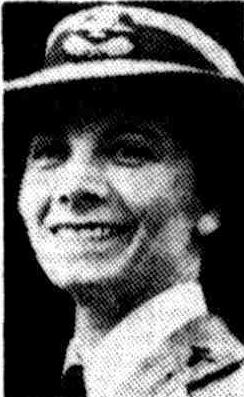 I had no idea that Australians were so popular in the United States,' said Sister Jolly. 'Our party of Australian Air Force nurses was showered with tickets for all the principal entertainments. Australian a i r men also were given a marvellous time. 'An Australian uniform is the Open Sesame to everything that is going in the United States. The people seemed to feel that the Australians were treating the Americans (Right Sister Jolly.) In Australia and they were more than anxious to reciprocate.
I had no idea that Australians were so popular in the United States,' said Sister Jolly. 'Our party of Australian Air Force nurses was showered with tickets for all the principal entertainments. Australian a i r men also were given a marvellous time. 'An Australian uniform is the Open Sesame to everything that is going in the United States. The people seemed to feel that the Australians were treating the Americans (Right Sister Jolly.) In Australia and they were more than anxious to reciprocate. 'A lot of the Americans had no idea of the size of Australia and their faces registered disappointment when I had to confess that I had not met the United States soldier, sailor, airman or nurse for whom they were inquiring.'
The R.A.A.F. Nursing Services is an Air Force organisation of trained nurses who have done effective work tending sick and wounded airmen, often under fire, in many major theatres of war. They are a separate unit from the W.A.A.A.F., which performs nursing work at air stations in Australia. Sister Jolly said that she was mildly | excited when the ship on which she was travelling passed over a zone in which several German submarines had been sunk a few days before. It was thought that some more U-boats might be lurking in the vicinity and a warm reception was prepared for them. But the voyage was without incident.
NEW YORK OPENS HEART TO AUSTRALIANS (1942, November 8). Truth (Sydney, NSW : 1894 - 1954), p. 16. Retrieved from http://nla.gov.au/nla.news-article168972710
MCCOSKER - JOLLY - March 5. 1343. at Wollstonecraft by Rev. A. J. Parker. Kathleen, second daughter of Mr. and Mrs. A. S. Jolly, of Wollstonecraft, to Flying-Officer Melvyn John Mccosker, eldest son of Mr. and Mrs. J. W. Mccosker, of Lindfield. Family Notices (1943, April 14). The Sydney Morning Herald (NSW : 1842 - 1954), p. 12. Retrieved from http://nla.gov.au/nla.news-article17844344
In 1946 he and Kathleen's son Douglas Alexander married Pamela Forsyth Thorpe - the marriage registered at Burwood.
A Stewart Jolly enlisted in the Militia on 18 December 1941 and was posted to the 7th Garrison Battalion(Service Number - N387021). He was discharged on 2 November 1943.
He did not practice architecture after World War Two and died in Wollstonecraft on April 17th 1957 of a heart attack, a grandfather.
His son, three daughters and his wife survived at the time of his passing, Douglas Alexander (born March 2nd, 1924 - at Chatswood WWII Service Number - 432198), Mavis Dill Stewart (born April 16, 1913), Kathleen Islay (born February 23rd, 1915), Elsie Betty and their mother, Kathleen.
Kathleen Wilhelmina Jolly passed away in 1954.
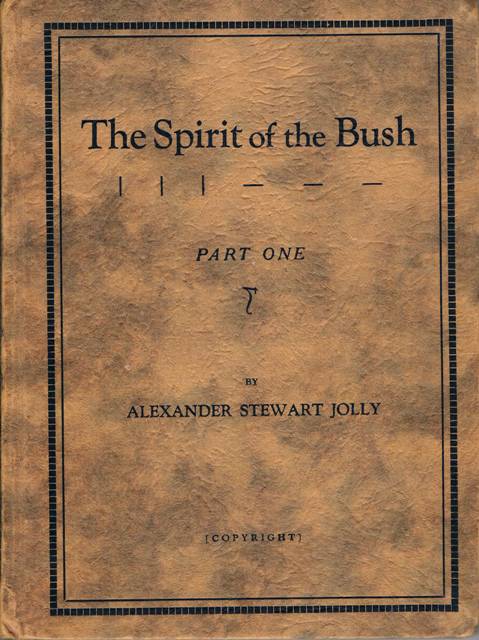
 | The Spirit of the Bush A S Jolly.pdf Size : 1284.402 Kb Type : pdf |
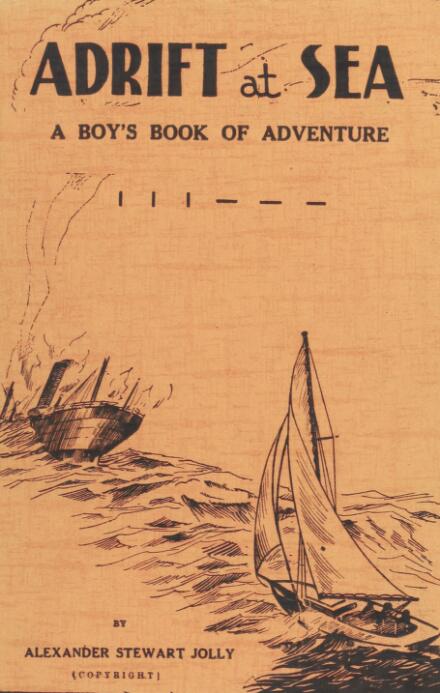 National Archives of Australia:
National Archives of Australia:A1336 22243 AUTHOR Alexander Stewart Jolly : ADDRESS Sydney : TITLE OF WORK The Spirit of the Bush : TYPE OF WORK Literary Work : APPLICANT Kathleen Wilhelmina Jolly : DATE OF APPLICATION 3 Mar 1932 : DATE COPYRIGHT REGISTERED 22 Apr 1932 : WORK ENCLOSED? [Yes]
1932 - 1932 3502324
A1336 23359 AUTHOR Alexander Stewart Jolly : ADDRESS Sydney : TITLE OF WORK Adrift at Sea : TYPE OF WORK Literary :
APPLICANT Alexander Stewart Jolly : DATE OF APPLICATION 15 Dec 1932 : DATE COPYRIGHT REGISTERED 21 Dec 1932 : WORK ENCLOSED? [Yes]
Adrift At Sea : A Boy's Book Of Adventure
By Alexander Stewart Jolly
Available to read online and download at National Library of Australia HERE
Jolly, Alexander Stewart
Title Adrift at sea : a boy's book of adventure / by Alexander Stewart Jolly
Call Number NL A 823 JOL
Created/Published Sydney : George B. Philip, 1932
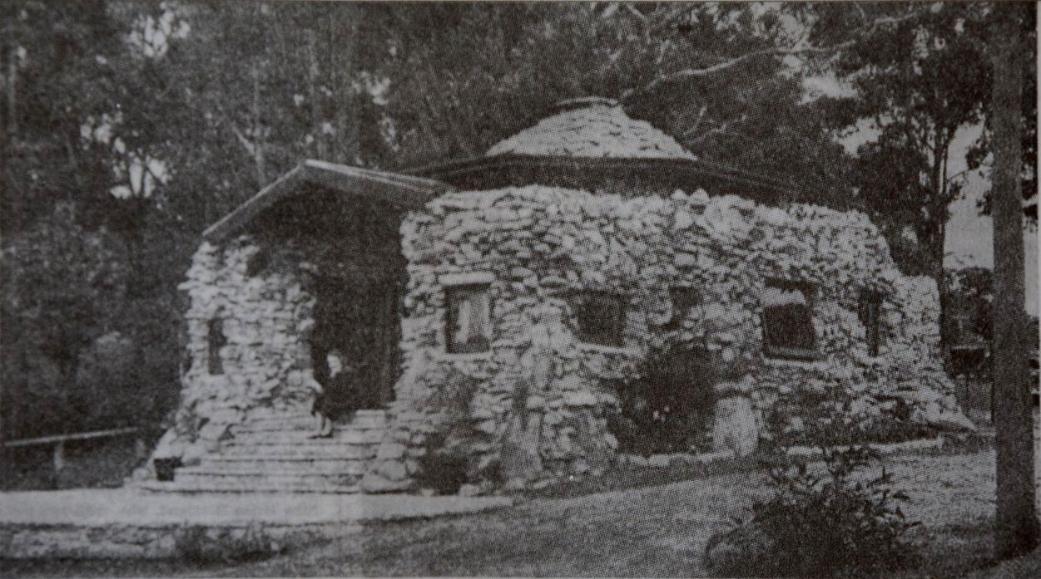
Stonehaven (also known as Elephant House), Taylors Point, Clareville, circa 1930 -1933, designed by Alexander Stewart Jolly, demolished 1980
DEATH OF DR. DILL MACKY.
THE PROTESTANT CHAMPION GONE.
HIS LIFE AND WORK.
Ever since the first issue of "The Watchman" appeared have those in charge of it had Occasion to give to the world such melancholy tidings as that contained in the later editions of the present issue. Dr. Dill Macky—"The Doctor" as he was familiarly called by thousands o£ warm-hearted friends —has been called away.
As years go he was not an old man—the allotted term of three-score and ten were net his—but not many lives of the same length have contained more of effort, of energy, and of success. Though the Doctor's health has been delicate for some months past, and the gravest fears were entertained of the ultimate result, the end came with distressing suddenness early on Wednesday morning. He died at the residence of his daughter, at Neutral Bay, at about 2 a.m.
STORY OF HIS LIFE.
The Rev. William Marcus Dill Macky was born at Lisfannan, County Donegal, Ireland, on the 8th of ' June, 1849. His father was a well-to-do farmer, and his mother a daughter of the manse, Susannah Dill, second Daughter of the Rev. Richard Dill minister of Knowhead Presbyterian Church, about three miles from Londonderry, whose pulpit he occupied for upwards of half a century. The Dills are a Levitical family In the Presbyterian Church of Ireland, generation after generation, for more than two centuries, having given their sons to the service of the ministry. Dr. Edward Dill, the celebrated South of Ireland missionary, was Dr. Dill Macky's uncle. In the early part of his ministry he was called to Scotland as a Protestant lecturer. This position he filled with ability and popularity for several years, but owing to failing health through the overstrain of the work, he resigned this position, and took up the work of evangelisation in the South and West of Ireland, where he had many an encounter with the priest, who gave him the sobriquet of The Cock of the North." Another of his uncles was the Rev. Richard Dill, of Osmond Quay Presbyterian Church, Dublin, the founder of the Magee College (now affiliated with Trinity College), in which Dr Dill Macky received his theological training work of the ministry. Dr. Samuel Marcus Dill the present Moderator of … Church of Scotland, is a second cousin of Dr. Macky's.
A VICTIM OF THE GOLD FEVER.
In the early, fifties, Dr. Dill Macky's father, caught with the gold fever, emigrated to Victoria, intending that after a time his family should follow him, but within a year his letters suddenly ceased. His last letter was written from Buninyong, and from that time he was never more heard of, although every effort was made at the time and afterwards to discover his fate. Life In the goldfields in those early days, as we know, was very precarious. Many were buried in the shafts which they themselves sunk, and not a few, it is believed, were murdered, as they suddenly disappeared and were never afterwards heard of. Left to her own resources with a family of five children—three sons and two daughters— with only a small annual allowance, which came to her after the death of her father from the Widows' Fund of the Irish Presbyterian Church, Dr. Dill.
THE DOCTOR AS PRESIDENT OF THE A.P.D.A.
Macky's mother, of whom he always spoke with reverence and affection that was unbounded, bravely faced the battle of life, and faced it so successfully that she lived to see her three sons occupying honourable positions, two as ministers of the Gospel and one as a medical man. Till recently all three were in New South Wales. Dr. Dill Maclcy, minister of Scots' Church, Sydney; Rev. Richard Dill Macky, minister of Byron Bay; and Dr. James Macky (medico), at Ulmarra, Clarence River. The latter died a year or so ago.
ASTRIDE "ROARING MEG."
When about sixteen years of age, Dr. Dill Macky, whose educational training had hitherto been confined to the National School curriculum, began the study of the Classics in a seminary situated on the walls of Derry, and overlooking one of the Bastions in which were mounted the old guns which did battle at the Siege, Dr. Dill Macky still speaks of how, as a boy, he used to sit astride "Roaring Meg" and picture to himself the bygone days when the brave fathers held the "maiden city" in the face of King James's army, and answered every challenge sent to them, whether of threat or promise, with their own battle cry, "No Surrender."
A DERRY PRENTICE BOY.
In these days Dr. Macky was a member of one of the "Prentice Boys" clubs, whose title, by the way, was again No Surrender. The great event of the year in connection with these clubs is the celebration of the anniversary of the "shutting of the gates" on the 18th of December, 1688. On the return of this day (which has been continuously observed through the two centuries which have since passed), Lundy, the Traitor (who would have given up the city to King James's army, and who saved his life when his treachery was discovered by sneaking out of the city disguised as a peasant with a bundle of scallops on his back) is publicly burned from the top of Walker's Monument, amidst the salvos of cannon and the huzzahing of multitudes (who assemble in thousands from the borders of the neighbouring counties). No doubt these early influences and environments helped to the deepening and strengthening of Dr. Dill Macky's Protestantism, which, as he has often declared from the platform, he imbibed with his mother's milk.
THE CROSS OF BALLINASCREEN.
In 1869 Dr. Macky matriculated for the study of Arts in Magee College, and four years afterwards, having finished his arts course, he entered the Theological Hall. During these years he gained many prizes and scholarships, and at the end of his course in 1876, was licensed by the Derry Presbytery to preach the Gospel. In the early part of the same year, 1876, he received a call from the members and adherents of the congregation of Draperstown, popularly known as the Cross of Ballina-screen, to become their minister. He accepted the call, and was ordained by the Presbytery of Magherafelt in the month of November. Here he laboured for ten years, beloved by all the Protestant sections of the community, who testified the love and esteem in which they held him, by subscribing a public testimonial in the shape of a purse of sovereigns and an illuminated address on resigning his charge of Draperstown preparatory to his coming to New South Wales.
DARING TO STAND ALONE.
On two other occasions during his ministry in Draperstown he was the recipient of 5 addresses and testimonials from his own people. In politics Dr. Dill Macky was at this time a strong Conservative, and took an active part in the Parliamentary elections. Most of the members of the Presbyterian Church were then strong Liberals ' and staunch supporters of Mr. Gladstone. Indeed, in his own Presbytery, the Presbytery of Magherafelt, he stood alone, as he has done many a time since, in advocating the principles he believed. Dr. Dill Macky distrusted Mr. Gladstone and his policy in connection with Ireland. He disbelieved in him even when he was declaring that Parnell and his company were "steeped to the lips in treason." The last election campaign he engaged in was when Colonel McCalmont, Conservative, was fighting County Derry against the Liberal (Mr. Findlater) and the Home Ruler (Mr. Tim. Healy). In this contest all the members of the Magherafelt Presbytery were fighting strenuously for Mr. Gladstone and Mr. Findlater. Dr. Dill Macky alone among them supported the Conservative candidate.
He warned the Presbyterians of County Derry of Mr. Gladstone's ulterior aim, the granting of Home Rule to the Irish, but such an idea at that time was ridiculed. It must have been some kind of satisfaction, therefore, to Dr. Dill Macky, some two or three years later to see his forecast fulfilled and the General Assembly of the Presbyterian Church of Ireland called together specially to denounce the Irish policy of the man whom at one time they almost idolised.
THREATENING LETTERS.
In Dr. Dill Macky's own parish the Roman Catholics were by far in the majority, and especially was this the case in the little town which is the centre of the parish. Most of the shopkeepers, and all the publicans, of course, belonged to the Roman Catholics. They were furious at the Doctor, and many a threatening letter did he receive of what would happen if he did not keep his tongue quiet. But such threats he treated then, as he has done ever since, with contempt, although he was always prepared for the worst.. On one occasion I accompanied Colonel- McCalmont to Garvagh and made a powerful speech there on his behalf.
...... (10 more pages)
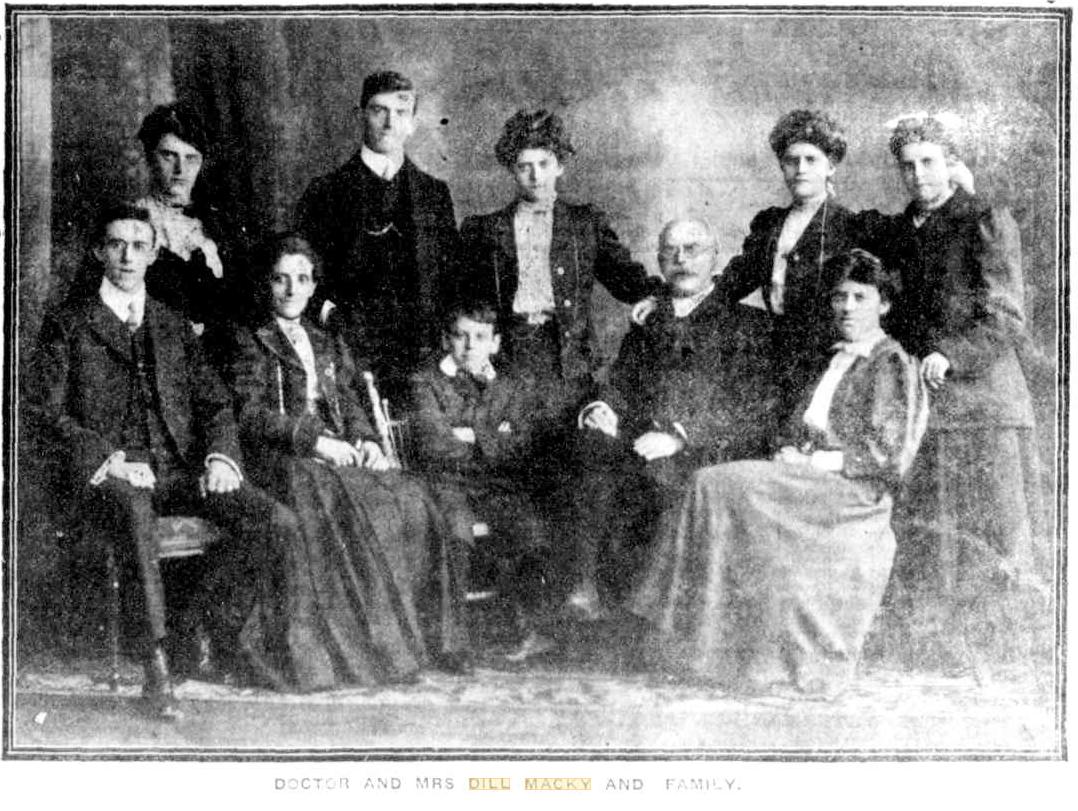
DOCTOR AND MRS DILL MACKY AND FAMILY.
Family Notices (1913, October 23).Watchman (Sydney, NSW : 1902 - 1926), p. 5. Retrieved from http://nla.gov.au/nla.news-article112380700
DILL MACKY.— October 15th,. 1913, at Bessels-Leigh, 29 Undercllffe-street, Neutral Bay, William Marcus Dill Macky, D.D., minister of Scots Church; Sydney, aged 64 years.
Family Notices (1913, October 15). The Sun (Sydney, NSW : 1910 - 1954), p. 7 (FINAL EXTRA). Retrieved from http://nla.gov.au/nla.news-article229354548
THE LATE DR. DILL MACKY.
In last Wednesday's issue the "Star" briefly recorded the death of Dr. Dill Macky, and from the obituary notice that appeared in the "Daily Telegraph" of same date the following interesting account of this able divines career had been taken :----
Dr. Dill Macky was born at Lisfannan, Co. Donogal, Ireland, in 1849. His father was a well to-do farmer, and his mother a daughter of Rev. Richard Dill, minister of Knowhead Presbyteriau Church, near Lon- donderry. The Dills, generation after gen-eration, for more than two centuries, had given their sons to the ministry. Dr. Ed- ward Dill, the celebrated South of Ireland missionary, was Dr. Dill Macky's uncle. Another uncle was Rev. Richard Dill, of Osmond Quay Presbyterian Church, Dublin, the founder of the Magee College, in which Dr. Dill Macky received his theological training for the work of the ministry.
In the early fifties the father caught the gold fever, and emigrated to Victoria, in-tending that his family should follow him. But within a year his letters suddenly ceased, and he was never again heard of, an incident not uncommon in those precarious days on the goldfields. His mother bravely faced the battle of life, and so successfully that she lived to see her three sons occupying honorable positions; two as ministers of the gospel and one a medical man.
Dr. Dill Macky's boyhood days were spent in and around Derry, the influences of environment of which must have cultivated that Protestantism which was subsequently teo dominant characteristic of his life. He was a member of one of the "Prentice Boys' '' Clubs, and often told of how he used to sit astride "Roaring Meg", one of the old guns that did battle during the famous siege, and picture to himself the brave days of old. In 1869 he matriculated for the study of Arts in Magee College, afterwards entering the Theological-hall, where he had a successful course, and in 1876 he was licenced by the Derry Presbytery as a preacher. His first charge was the church at Draperstown, where he ministered for 10 years. He resigned in November, 1886, to come out to New South Wales, landing in Sydney by the Austral on January 1 of the next year with his wife, he had married a daughter of Dr. Morwood, of Draperstown and three children. In the following May he was called to the pastorate of Scots Church, with which he continued to be associated until his death.
He was an eloquent teacher, fervently evangelical, and thoroughly orthodox ; popular in the pulpit and prominent on the lecture platform. In 1899 he was honored by his church, which elevated him to the high position of Moderator of the General Assembly of New South Wales. During the same year ho received the degree of D.D. from the Presbyterian Faculty of Ireland. He was also a lecturer for some years at St. Andrew's Theological-hall.
It was, however, as the spokesman of Protestantism that Dr. Dill Macky will be most vividly remembered. Before leaving Ireland, he was a vigorous opponent of Home Rule. In politics in those days he was a Conservative, standing almost alone in that connection amongst his fellow ministers. He distrusted Mr. Gladstone's Irish Policy, and just before leaving for New South Wales he supported Colonel McCalmont, the Conservative candidate for Derry, against the liberal (Mr. Findlater) and the Home Ruler (Mr. Tim Healy). He was the only member of the Magherafelt Presbytery opposing Mr. Gladstone. He warned them of the latter's aim to grant Home Rule, but the idea was ridiculed. Two or three years later his prophecy was fulfilled, and the General Assembly of the Presbyterian Church of Ireland was called together to denounce the Irish policy of the man whom at one time they almost idolised. Soon after coming to Sydney, he joined the Orange Institution, with which he was actively associated during the rest of his life, holding for many years the position of Grand Chaplain.
Although a staunch Orangeman, he felt there were very many Protestants who could not be got to join the institution, and in 1901 he formed the Australian Protestant Defence Association, the platform of which he believed to be broad enough to take in the whole Protestant community. In 1902 his congregation relieved him of his parish duties for six months, which he spent touring round the State and establishing branches of the A. P. D. A. Everywhere crowded houses greeted him. These were stirring times, not without personal danger. At Wyalong, the police magristrate had to read the Riot Act, and disperse the mob, otherwise the doctor might have been severely dealt with. The next night at Temora, he was protected from violence by the sheltering walls of the police barracks. In spite of these experiences he formed a branch at each place. About six years ago he visited Tasmania and organised a Protestant Defence Association there. It was established also in Victoria. In Melbourne he had a royal reception, when he visited there in the interest of the movement. A crowd locked the Spencer-street station to welcome him, and about 14,000 people at-tended the Exhibition Building to hear him speak. The Protestant Defence Association was also planted by him in New Zealand. Crowned his work in this connection by establishing "The Watchman" as the press organ of Protestantism.
His activities reached to other fields. Always an active member of the Christian Endevour movement, in 1898 he was elected New South Wales president. In 1897 he was President of the Evangelical Council. He was also a prominent Freemason.
In 1904 at a big meeting in the Sydney Town Hall he was presented with a purse of sovereigns and an illustrated address. In 1908, after 21 years' ministry at Scot's Church, he decided to revisit the Old Land. He was given an enthusiastic send-off and a substantial monetary testamonial. During a tour extending over about six months he visited old scenes in Ireland, Scotland and England, addressing many meetings, and on his return was warmly welcomed at a big demonstration at Clifton Gardens.
Since then he invested practically all his extra energy to the foundation of the King Edward VII Protestant Orphanage now successfully working at Auburn. THE LATE DR. DILL MACKY. (1913, October 18). Northern Star (Lismore, NSW : 1876 - 1954), p. 2. Retrieved from http://nla.gov.au/nla.news-article72340286
Albert Edwin Dalwood
Albert Edwin Dalwood was born in 1863 to Henry Dalwood and Matilda Dalwood (born Braine)in Somerset England. He came to Australia in 1883 seeking respite from a disease he was suffering from that afflicted many then - tuberculosis. He recovered, did very well in real estate and as an auctioneer, becoming involved in newspapers, including then then existing Sunday Times, the Chairman of Directors of NSW Associated Blue Metal Co Ltd, Automatic Bread Baking Co Ltd and Great Western Portland Lime and Cement Co Ltd; and a director of Road Lighthouses Ltd, and the Southern General Insurance Co of Australasia Ltd.
He married Julia Pettman, daughter of William Pettman, on 21 January 1886. They had three children, Stanley (born Glebe 1887, died 1887), Olive (born Bowral 1889, died 1906) and Harold (born Marrickville 1893-1931). The family then lived at Springfield, Springfield Avenue, Woollahra.
Dalwood, a great stone edifice originally called ‘Clavering’, was built on high land at Seaforth in the 1890s by Professor Theodore Thomas Gurney of Sydney University, a man of letters, professor of science and mathematics. He passed away in England in 1918 and his home was sold to Albert Edwin Dalwood in 1922. Albert bought it for his wife, Julia, who is reported to have said, "No. I won’t live there. It’s too spooky, too Gothic. It gives me the creeps."
He consequently leased the premises to the Food for Babies Fund for a peppercorn rent of one shilling (reported in his paper the Sunday Times - 1928) and the Dalwood Children’s Home was born. The mansion was extended. It gained added wings and a new façade.
Julia passed away, aged 71, in 1931 and Mr. Dalwood remarried in 1933.
4017/1933 DALWOOD ALBERT E HINDMARSH MARY I C LOCKHART
A REAL GIFT
For Weary Mothers THE DALWOOD HOME
"Work of this nature is preventive medicine in its best form. This work is superior to any hospital work, because it prevents people getting ill, and to prevent illness is better than to cure it."
This statement was made by Dr. Richard Arthur, M.L.A., Minister for Health, at the opening of the Dalwood Rest Home at Balgowlah yesterday. The home has been presented by Mr. A. E. Dalwood to the Food for Babies' Fund. At the present time it will house six mothers and ten children. Dr. Arthur made an eloquent plea that other business men would follow the example set by Mr. Dalwood. He said that Australians seemed to be lacking the characteristically generous spirit of the Americans, who gave so lavishly to public philanthropies. Mr. E. L. Sanders, M.L.A., member for the district, said that Mr. Dalwood's gift of a home was a striking tribute of his practical appreciation of the success which had attended his personal preferment.
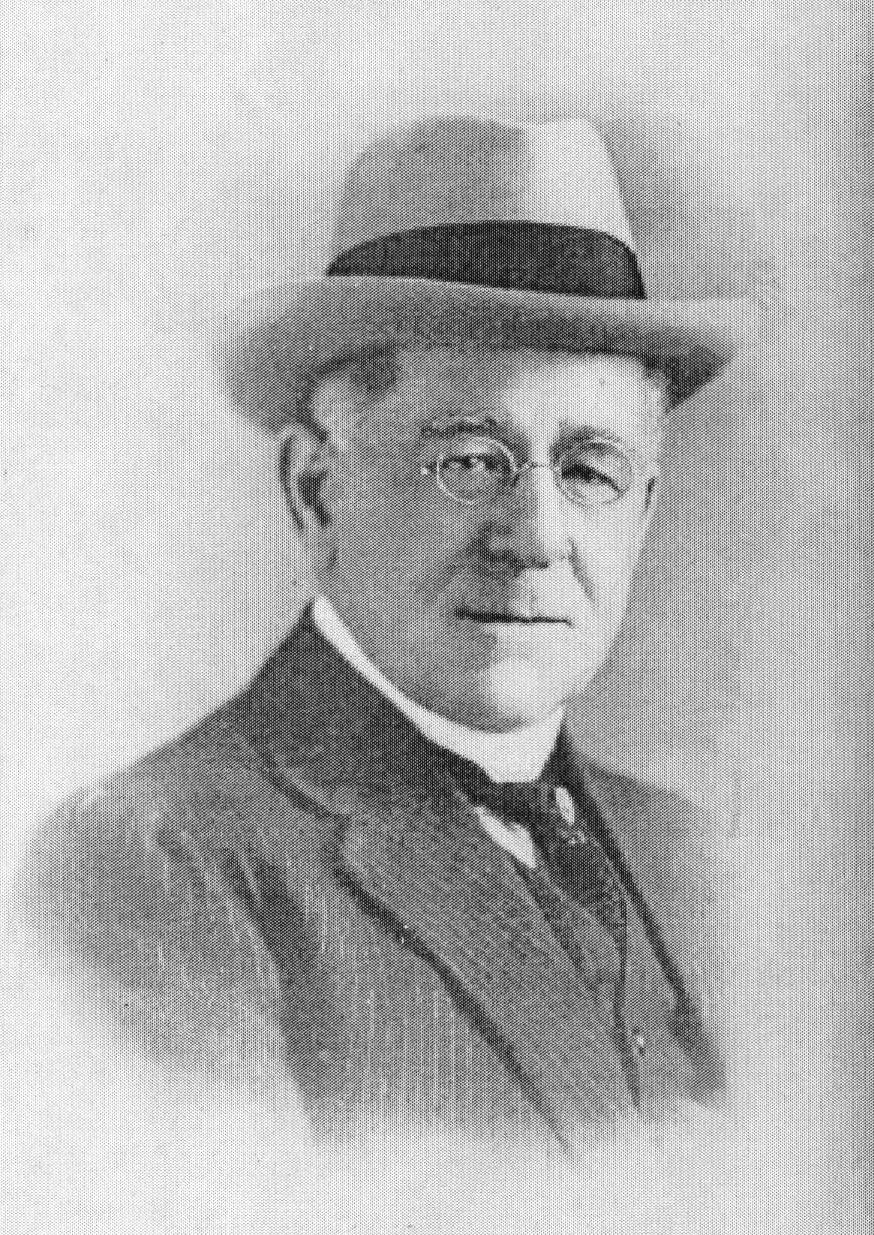
MR. DALWOOD.
Senator Cox, Mr. J. H. Mostyn, former Lord Mayor, and Sir Charles Rosenthal supported the remarks of Dr. Arthur. The chairman of the fund said that few people realised that it was due to Dr. Arthur personally that the Commonwealth Government had provided thousands of homes all over Australia for soldiers and their dependents. It was during the war that the Minister for Health started the Voluntary Workers' Association, which built the first home at French's Forest. Then, through the money raised by the Homes Day Appeal, commenced the Matraville Soldiers' Settlement. The Voluntary Workers' movement spread, not only to the principal towns in New South Wales, but to most of the other States. It was then that the late Senator Millen, the then Minister for Repatriation, announced that the Government would take over the financing and directing of war service homes in connection with which they have since spent hundreds of thousands of pounds. Had it not been for Dr. Arthur's initial effort, many Australian soldiers would be homeless to-day.
Mr. A. E, Dalwood said that he endorsed the remarks of Dr. Arthur regretting the necessity for preventing disease, and that was why he had given the home to the Food for Babies' Fund. When he first came to Australia he was suffering from T.B., but instead of death he found health and wealth. He felt that it was more blessed to give than to receive, and he was glad to make the home available. Mr. J. T. Easterbrook, C.B.E., presented Dr. Arthur with a fountain pen in place of the customary gold key. The pen is guaranteed for 25 years, and in handing it to the Minister for Health Mr. Easterbrook expressed the wish that Dr. Arthur would live to wear it out. Beds and cots were donated by the campaign staff of St. Margaret's Hospital, Mr. J. T. Easterbrook, C.B.E., Mr. A. E. Dalwood, Mr. H. P. Dalwood, Mrs. M. H. Berry, Mrs. D. Davis, Mrs. Stanley Patrick, Mrs. Emanuel Myerson, Mr. Emanuel Myerson, and Mrs. George FitzPatrick. A REAL GIFT (1928, February 19).Sunday Times (Sydney, NSW : 1895 - 1930), p. 47. Retrieved from http://nla.gov.au/nla.news-article122807991
DALWOOD REST HOME AT BALGOWLAH.
OPENED ON SATURDAY BY THE MINISTER FOR HEALTH.
The gift of Mr. A. E. Dalwood, who is on the left of the picture.
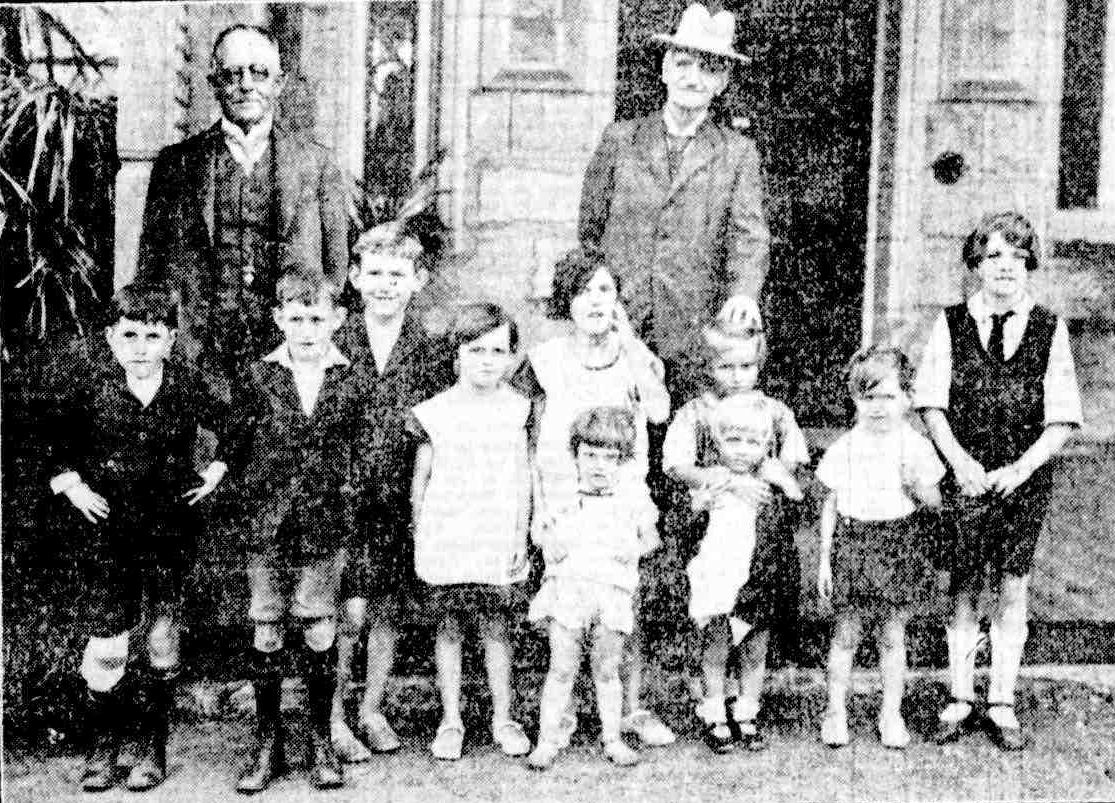
DALWOOD REST HOME AT BALGOWLAH. (1928, February 21 - Tuesday). The Sydney Morning Herald (NSW : 1842 - 1954), p. 14. Retrieved from http://nla.gov.au/nla.news-article16443503
DALWOOD_HOME.
OPENED BY DR. ARTHUR.
A GENEROUS GIFT.
The Minister for Health (Dr. Arthur) on Saturday afternoon opened the Dalwood Rest Home at Balgowlah, which has been made available, by Mr. A. E. Dalwood to the Food for Babies Fund. The house stands on an elevated position in French's Forest.*
Dr. Arthur Bald he considered that the work carried on at the Dalwood Rest Home was more Important than that done In the hospitals, bocnuso the women who rested at the home would not need hospital treatment. He hoped that other Australians would emulate the example of Mr. Dalwood.
The Minister added that it was a calamity that such organisations as the Red Cross Society, which had done valuable service during the war, should be compelled to curtail their activities In some degrees, as far as T.B. patients were concerned, simply because of the want of funds.
Mr. George Fitzpatrick (chairman of the fund), Senator Cox, Mr. J. H. Mostyn (ex-Lord Mayor), and Sir Charles Rosenthal (members of the committee), and Mr. E. L. Sanders, M.L A., also spoke.
Mr. A. E. Dalwood acknowledged the remarks of the various speakers.
Beds and cots have been presented by the campaign staff of St. Margaret's Hospital, the Misses Saunders, Mesdames M. H. Berry, D. Davis, Stanley Patrick, Emanuel Myerson, and George Fitzpatrick, and Messrs. J. T. Easter-brook, A. E. Dalwood, H. P. Dalwood, Emanuel Myerson.
DALWOOD HOME. (1928, February 20).The Sydney Morning Herald (NSW : 1842 - 1954), p. 12. Retrieved from http://nla.gov.au/nla.news-article16443390
* This clear mistake may be accorded to a mixup with the home address of the Dalwood Home for Children, in 'Frenchs' Forest Road, Seaforth.
FOR DALWOOD HOME
'Miss Gladys Moncrieff helped us when she was here before, and one of her first actions on returning was to call on us and place her talent and time once more at our disposal,' said the chairman at last Tuesday's, meeting of the Food for Babies Fund. 'When Miss Moncrieff left for Europe two years ago,' he added, she presented to us her famous recipe for keeping slim., anil I am delighted to tell her that through the extensive sale of this recipe we have made £1000 for the fund.' This money is now being contributed towards the upkeep of the Dalwood Home, which was opened at Balgowlah some months ago. In addition to this substantial assistance, Miss Moncricff has also consented to be hostess at the Gladys Moncricff Cabaret to be held in aid of the Home at the Ambassadors on June 14. The world-famed prima donna will also sing at the cabaret. 'I'll do anything that -you want me lo do for the' mothers and babies,' she generously volunteered at the meeting; Mrs. David Stewart Dawson was elected president at the meeting, and Mesdames ,I. Eales, J. .Jacobson, J. -Hicham, C. Schultz, E. L. Rees, and Stanley Patrick, vice-presidents; Miss Marjorie Jacobson, honorary secretary, and Miss May Sheehan, honorary treasurer. Those present included Mesdames Laurie Moncrieff, A. Edmeads, G. Oswald, Harry Burrell, J. H. Mostyn, George Greenlees, S. Myerson, K. L. Sanders, S. C. Fallick, J. Hill, L. Finn, A. Norman, K. Bantin, and Misses Nell Waters, Nance Armitage, Kathleen Lord, M. Harrison, E. Larkin, I. Norman, Ena Cantor, and N. Collins. FOR DALWOOD HOME (1928, May 20).Sunday Times (Sydney, NSW : 1895 - 1930), p. 16. Retrieved from http://nla.gov.au/nla.news-article122809541
Dalwood Best Home
The Dalwood Rest Home for tired mothers and their children at Balgowlah, a few miles from Manly is maintained by the Food for Babies' Fund. Miss Gladys Monerieff, the popular, star of ' Rio Rita,' is arranging a cabaret to be held at the Ambassadors' on June 14 in aid of this very deserving movement. Tables may be booked by ringing B7291.
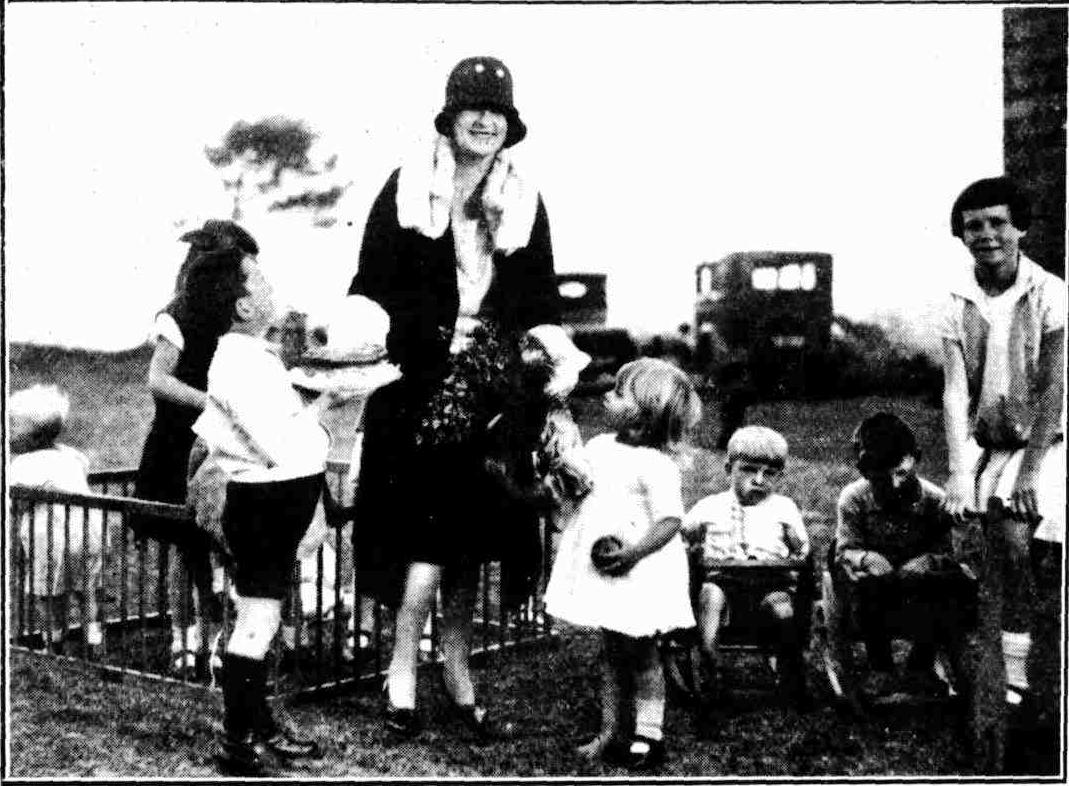
MISS GLADYS MONCRIEFF AMONG THE CHILDREN AT DALWOOD.
Dalwood Rest Home (1928, May 30).Sydney Mail (NSW : 1912 - 1938), p. 32. Retrieved from http://nla.gov.au/nla.news-article158401046
THE DALWOOD REST HOME.
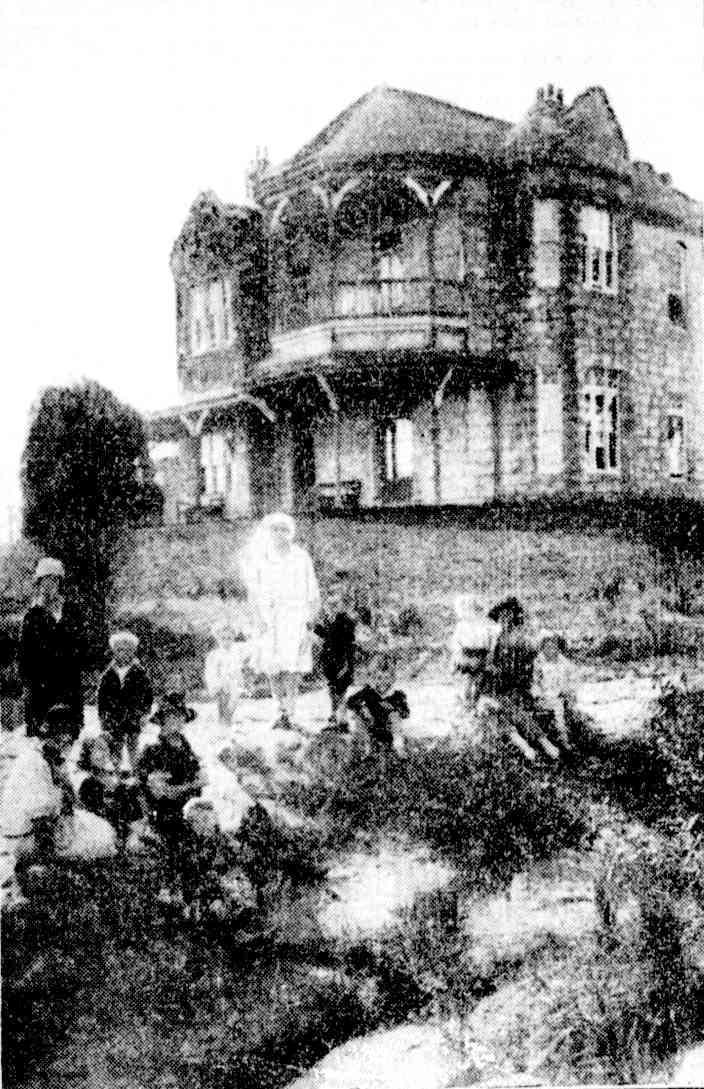
MOTHERS AND CHILDREN IN THE GROUNDS AT BALGOWLAH.
THE DALWOOD REST HOME. (1928, September 5). The Sydney Morning Herald (NSW : 1842 - 1954), p. 18. Retrieved from http://nla.gov.au/nla.news-article16491737
DALWOOD REST HOME, on Happiness Hill, at Balgowlah, which has again been leased to the Food for Babies' Fund as a home for work-weary mothers and convalescing children. The nominal rental charged by the owner is only one shilling per year.
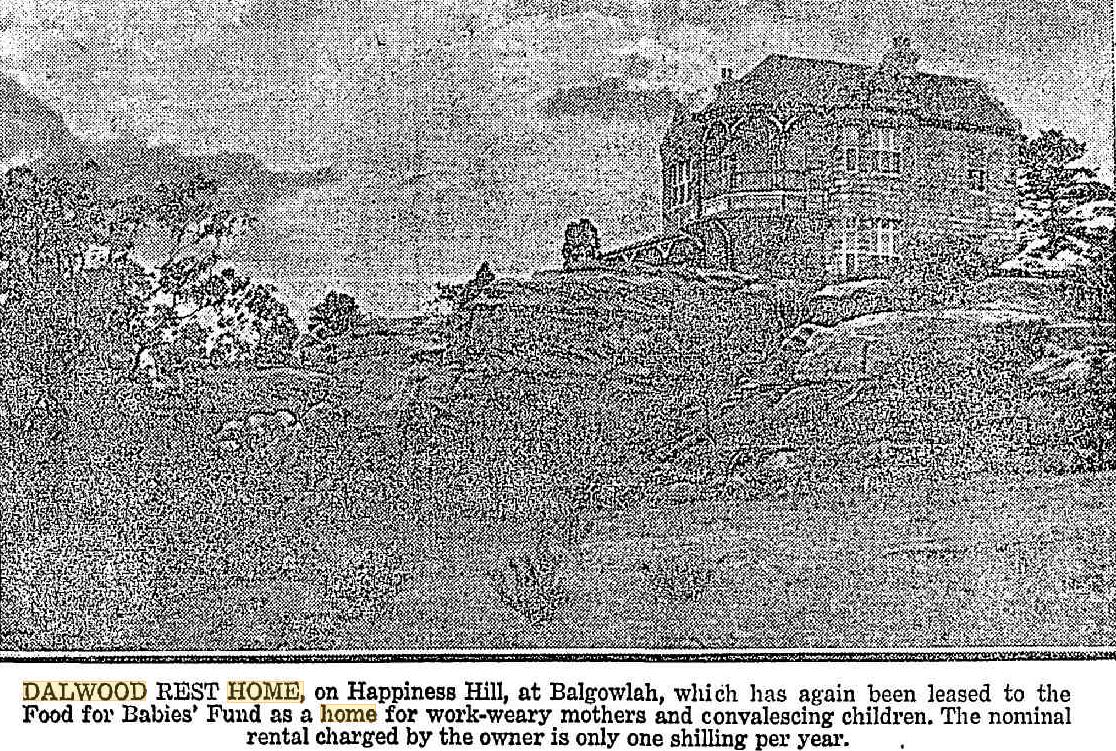
DALWOOD HOME ON HAPPINESS HILL (1928, November 25). Sunday Times (Sydney, NSW : 1895 - 1930), p. 23. Retrieved from http://nla.gov.au/nla.news-article122809852
PUBLIC HOSPITALS ACT, 1929.
Sir Philip Woolcott Game, Governor of the State of New South Wales in the Commonwealth of Australia, upon the recommendation of The Hospitals Commission of New South Wales, and with the advice of the Executive Council of the said State, do by this my Order, in pursuance of the provisions of section 4, subsection (2) of the Public Hospitals Act, 1929, hereby add the name of the undermentioned hospital -to the Second Schedule to the said Act, and I do hereby further order that in accordance with the provisions of section 23, subsection 1 (b) of the said Act, the first election of Directors of the said hospital shall be held on or before the 31st day of December, 1931.
Hospital Incorporated: Dalwood; Corporate Name: The Dalwood Health Home (The Food for Babies Fund).
Dated at Sydney, this twenty-eighth day of October,
PHILIP GAME, Governor.
WILLIAM T. ELY, Minister for Health.
PUBLIC HOSPITALS ACT, 1929. (1931, October 30). Government Gazette of the State of New South Wales (Sydney, NSW : 1901 - 2001), p. 3696. Retrieved from http://nla.gov.au/nla.news-article220365109
In March 1931 Julia passed away. Soon after, the same year, Mr. Dalwood lost his only surviving son due to disease and an accident stemming from 'fever':
DALWOOD.-February 28 1931,at Springfield, Darlinghurst. Julia, beloved wife of A. E. Dalwood, and mother of H. P. Dalwood. Family Notices (1931, March 2). The Sydney Morning Herald (NSW : 1842 - 1954), p. 8. Retrieved from http://nla.gov.au/nla.news-article16758472
HOSPITAL PATIENT'S DEATH
Due to Accidental Fall.
A verdict of accidental death was returned by the City Coroner (Mr. May) yesterday at the conclusion of an inquest concerning the death of Harold Pettman Dalwood, 37, of Macleay-street, Darlinghurst, who died on November 9 from Injuries received when he fell from the balcony of the Royal Prince Alfred Hospital on November 5.
Albert Edwin Dalwood said that his son had wished to leave the hospital on several occasions. He was evidently suffering from fever, and thought he was escaping from the hospital.
Dr. Norman Wyndham, resident medical officer at the hospital, said that Dalwood was suffering from a disease that would have caused his death within two years. The patient told him that he thought there was an enemy in the ward, and that he wanted to escape from the hospital.
HOSPITAL PATIENT'S DEATH (1931, November 14). The Sydney Morning Herald (NSW : 1842 - 1954), p. 10. Retrieved from http://nla.gov.au/nla.news-article28036532
DALWOOD-November 9 1931 result of accident, Harold Pettman beloved only son of A E Dalwood, aged 37 years. Family Notices (1931, November 10). The Sydney Morning Herald (NSW : 1842 - 1954), p. 8. Retrieved from http://nla.gov.au/nla.news-article16819365
As it is when anyone loses a child under these circumstances, the health cane be affected. Mr. Dalwood, who was going through the court cases, outlined in Mr. Jolly's second forced bankruptcy. Among the reports of him assigning his assets over to creditors it becomes apparent grief and the experience of those who wanted their money through land sales returned, has made him ill:
ONCE RICH MAN.
Estate Assigned.
A. E. Dalwood's Debts.
Albert Edwin Dalwood, the well - known Sydney investor, who in June last, assigned bis estate for the benefit of his creditors, was to have been examined in Sydney, under section 80 of the Bankruptcy Act, before the Registrar (Mr. Norman C. Lockhart), but the examination was adjourned for a fortnight after certain evidence bad been taken. Dalwood, who some years ago was reputed to be one ot the richest men In this State, disclosed contingent liabilities at £294,000; unsecured creditors. £89,000: secured assets, 150,000; and ordinary assets, £187,000. After dealing with contingent liabilities Dalwood's statement of affairs referred to his shares in public companies and slated that in the Sunday Times Newspaper Co., Ltd., there were 150,000 shares of £1 each (held by the Teasdale Smith estate as security); debentures in Beckett's Newspapers, Ltd., £14300; and in the Sunday Times Newspaper Co., Ltd., £13,600 (also held as security by the Teasdale Smith estate).
Reginald Haviland Varna, of the Lawson Theatre, Redfern, in which Dalwood had had an Interest, was questioned by Mr. Curlewis (for the trustees of the Dalwood estate). He said he had now no Interest in the theatre. His wife had been secretary to Dalwood for some years before he married her, and he understood that Dalwood owed her £1000. He had not discussed all the details with his wife. She had mentioned to him that Dalwood was Indebted to her. He was on the best of terms with his wife, who was not now secretary to Dalwood. He could give the Court no further Information of Dalwood's Indebtedness to her. Varna denied that he was liable to pay rent for a machine installed In the theatre by the Western Electric Company until Dalwood transferred to him the interest In the theatre for which Varna had paid £760. The examination was adjourned for two weeks.
ONCE RICH MAN. (1932, February 13).Townsville Daily Bulletin (Qld. : 1907 - 1954), p. 9. Retrieved from http://nla.gov.au/nla.news-article61357276
DALWOOD ESTATE
The examination of Albert Edwin Dalwood, city investor, who assigned his estate of £200,000 for the benefit of creditors last year, was to-day further adjourned generally, on the application of Mr. Curlewis, owing to Mr. Dalwood's continued ill-health.
DALWOOD ESTATE (1932, March 14).The Sun (Sydney, NSW : 1910 - 1954), p. 3 (FINAL EXTRA). Retrieved from http://nla.gov.au/nla.news-article229883991
HINDMARSH.-December 25, 1935, at a private hospital in Manly, Mary Jemima, widow of the late Alfred Joseph Hindmarsh, of Rose Bay, and beloved mother of Isabel (Mrs. A. E. Dalwood), Ada, Fred, and the late John Hindmarsh. Interred Waverley Cemetery on the 26th instant. Family Notices (1935, December 27). The Sydney Morning Herald (NSW : 1842 - 1954), p. 6. Retrieved from http://nla.gov.au/nla.news-article17221947
BUSHFIRE RAGES AT SEAFORTH
Dalwood Home Saved By Brigades
Sweeping towards the Dalwood Home, in French's Forest-road, Sea-forth, a bush fire was brought under control after an hour's hard fight, by firemen from Manly and Mosman, reinforced by a detachment from headquarters. The flames were fanned by the strong wind which swept over Sydney this afternoon. A large area of bush was burnt out, reaching down to the waterfront at Middle Harbor.
BUSHFIRE RAGES AT SEAFORTH (1937, September 18). The Sun (Sydney, NSW : 1910 - 1954), p. 8 (LATE FINAL EXTRA). Retrieved from http://nla.gov.au/nla.news-article229442657
Mr. Dalwood passed away in the Winter of 1948, aged 85:
DALWOOD Albert Edwin- June 24 1948 at his residence French's Forest Road Seaforth. Albert Edwin Dalwood beloved husband of Isobel and fond father of Edwina and brother in law of Miss Ada Hindmarsh
DALWOOD Albert Edwin - June 24 1948 at his residence French's Forest Road, Seaforth beloved brother of Mrs Louie Bodley, Mrs Lily Abramovitch and Miss Florence Minnie Dalwood. Family Notices (1948, June 25). The Sydney Morning Herald (NSW : 1842 - 1954), p. 14. Retrieved from http://nla.gov.au/nla.news-article18075794
Death of Mr. A. E. Dalwood
Mr. Albert E. Dalwood, well-known Sydney businessman and philanthropist, died at his home in Seaforth today, aged 85.
Mr. Dalwood had been ill since Sunday, when he collapsed. Born in England, he came to Australia 60 years ago. He managed the real-estate firm of A. E. Dalwood, Pitt-street. He founded the Dalwood Health Home. He leaves a widow and a daughter. Death of Mr. A. E. Dalwood (1948, June 24). The Sun (Sydney, NSW : 1910 - 1954), p. 5 (LATE FINAL EXTRA). Retrieved from http://nla.gov.au/nla.news-article228806610
A Generous Man Dies
SYDNEY, Thursday: Well known Sydney philanthropist Mr. A. E. Dalwood died at his home at Seaforth at 8 o'clock this morning. Mr. Dalwood was 85. He was best known as the founder of the Dalwood Health Home, Seaforth.
He came to Australia nearly 60 years ago. He started in business as in auctioneer, and quickly earned a fortune. Mr. Dalwood, who leaves a widow and daughter, had been governing director of the Sunday Times, The Referee, and The Arrow. After a service at 1.15 p.m.. tomorrow at St. Stephen's Church, Macquarie Street. Sydney. Mr. Dalwood's remains will be cremated. A Generous Man Dies (1948, June 25).National Advocate (Bathurst, NSW : 1889 - 1954), p. 3. Retrieved from http://nla.gov.au/nla.news-article161359515
RE will of ALBERT EDWIN DALWOOD, late of French's Forest road, Seaforth, near Sydney, in the State of New South Wales, company director, deceased.—Probate granted by Supreme Court of New South Wales on 1st April, 1950.— Pursuant to the Wills, Probate and Administration Act, 18931947 (Testator's Family Maintenance and Guardianship of Infants Act, 1916-1938, and Trustee Act, 1925-1942), Mary Isabel Constance Dalwood, the sole executrix of the will of the said Albert Edwin Dahvood, who died on 24th June, 1948, hereby gives notice that creditors and others having any claim against or to the estate of the said deceased are required to send particulars of their claims to the said executrix at the address given below oil or before the 31st July, 1950, at the expiration of which time the said executrix will distribute the assets of the said deceased to the persons entitled, having regard only to the claims of which she then has notice.—Dated 26th May, 1950. E. C. BENDER. Proctor for the Executrix, Intercolonial House, 4 Castlereagh-street, Sydney. 1496—£1
RE will of ALBERT EDWIN DALWOOD, late of French's (1950, May 26). Government Gazette of the State of New South Wales (Sydney, NSW : 1901 - 2001), p. 1697. Retrieved from http://nla.gov.au/nla.news-article220100748
Dalwood Homes
Sir, — In his letter referring to Dalwood Homes (29th March issue) your correspondent, C. R. Wilson, makes an unfortunate insinuation that the committee directing this institution sets out deliberately to catch the eyes and sympathy of Methodists by using a name which to a casual observer might be taken to refer to our own Dalmar Homes.
Dalwood Homes are situated at Seaforth in the Manly Circuit, and as the minister having oversight of Balgowlah and Seaforth I have some knowledge of this institution. Children from the Homes attend Balgowlah Public School, and some being Methodists are in my Scripture classes.
It is true that the Homes are not conducted by a Church or religious organization. They are directed by a committee of Sydney business men, and the chairman holds a responsible position in the city of Sydney.
Children are taken in, mostly for short terms, from homes where because of sickness or some other reason the parent or parents find it necessary to seek help in caring for their children. Cases have occurred where Methodist children were admitted until Dalmar had room for them.
Dalwood Homes may use different methods from Dalmar in the raising of funds, but there is no need to suggest or assume that their appeals or name are designed to 'catch the eyes of Methodists'.
The name Dalwood is used because the property was given in 1928 by the late Mr. A. E. Dalwood for a children's home in memory of his mother. It is a well-known name in the Seaforth district, and some of our 'Methodist folk show interest and practical help with Dalwood, but this does not minimise in any way their support or advocacy of our own Dalmar Homes. —
Yours, etc.,
ARTHUR E. BRAWN.
Dalwood Homes (1952, April 19). The Methodist (Sydney, NSW : 1892 - 1954), p. 9. Retrieved from http://nla.gov.au/nla.news-article155607013
Visit current:
Dalwood Auxiliary: The Auxiliary was originally formed to sew clothes for a daily average of fifty six resident children at Dalwood.
The organisation then progressed to raising funds for the various children’s services based on the Dalwood Seaforth site.
Our main fundraising is through the running of several Jumble Sales on the premises during the year.
Next Jumble Sale: March 10th, 2018 8.30 am until 12.30pm - 21 Dalwood Ave, Seaforth NSW
Dalwood Spilstead Service: 95% of brain development occurs in the first 5 years! Children from vulnerable and stressed families are at risk of attention, language, learning and behavioural problems due to poor attachment and stimulation in the early years. These children can later experience school failure, social difficulties and ant-social behaviour.
Research has clearly shown, however, that if families are supported and children receive intensive early intervention services these problems can be alleviated. The Dalwood Spilstead Service provides a unique program which is renowned for its work in assisting these children and their families.
In the tradition of the historic Dalwood Children's Home, the Dalwood Spilstead Service owes its ongoing success to the extended "familiy" of community benefactors and supporters who so generously contribute both their time and finances to help small children in need. We thank them.
The service was first established in 1978 as an extension of the Dalwood Children's Home which was created in the 1920s to support children from disadvantaged families.
Between 1931 and 1989 over 1,000 children attended the Dalwood Children's Home for either short term or long term respite. The initial Day Care was added to specifically meet the educational and developmental needs of children in care under school age.
The Dalwood Spilstead Early Intervention and Support Service now functions as a collaborative project between Northern Sydney Local Health District and the Spilstead Charitable Trusts. It is managed as a tertiary unit of the NSLHD Child and Family Health Service.
The new $10 million purpose-built Child and Family Health building at Dalwood opened in November 2015.
The new building, which sits alongside child and family health services already on site, including the Spilstead and Family Care Centres, provides children and families with a comprehensive range of child and family health services in one location.
The new facility provides services including:
• Community Paediatrics
• Paediatric Occupational Therapy Services
• Paediatric Speech Pathology Services
• Child and Family Health Nursing
• Enuresis Services
Child and Family Health Services that were provided at the Queenscliff site have relocated to the new building.
For details of how to access Dalwood Child and Family Health Services download a PDF of the map or call 9951 0300.
References And Extras
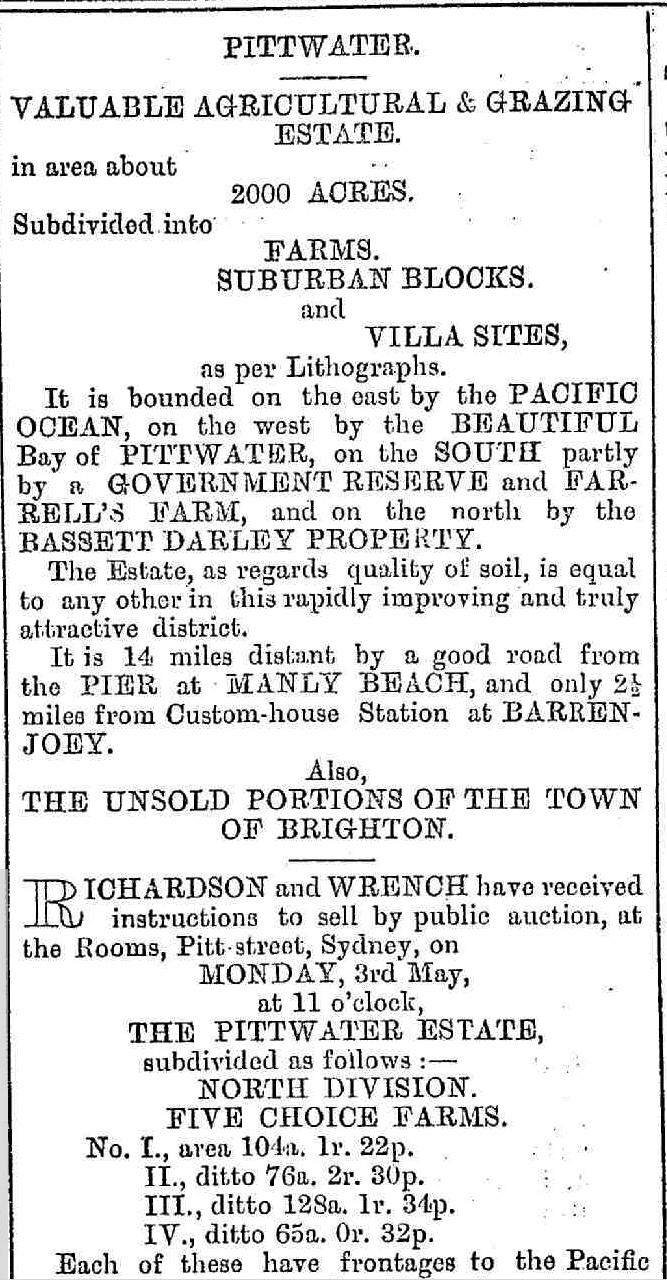
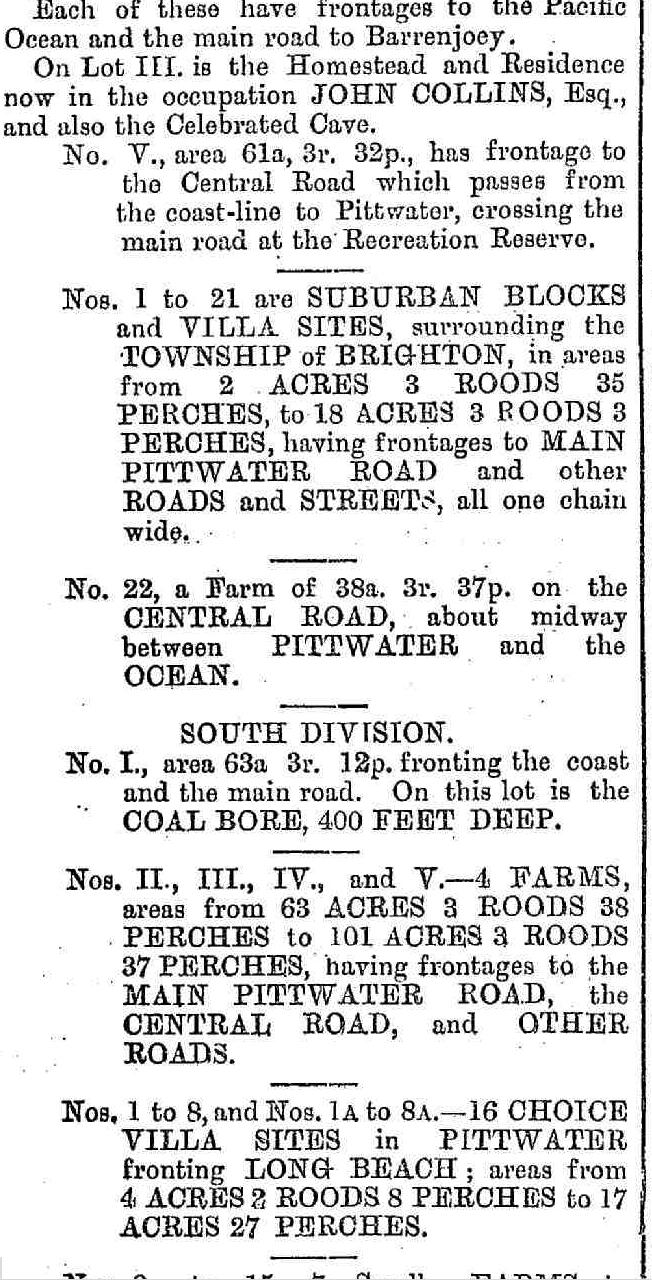
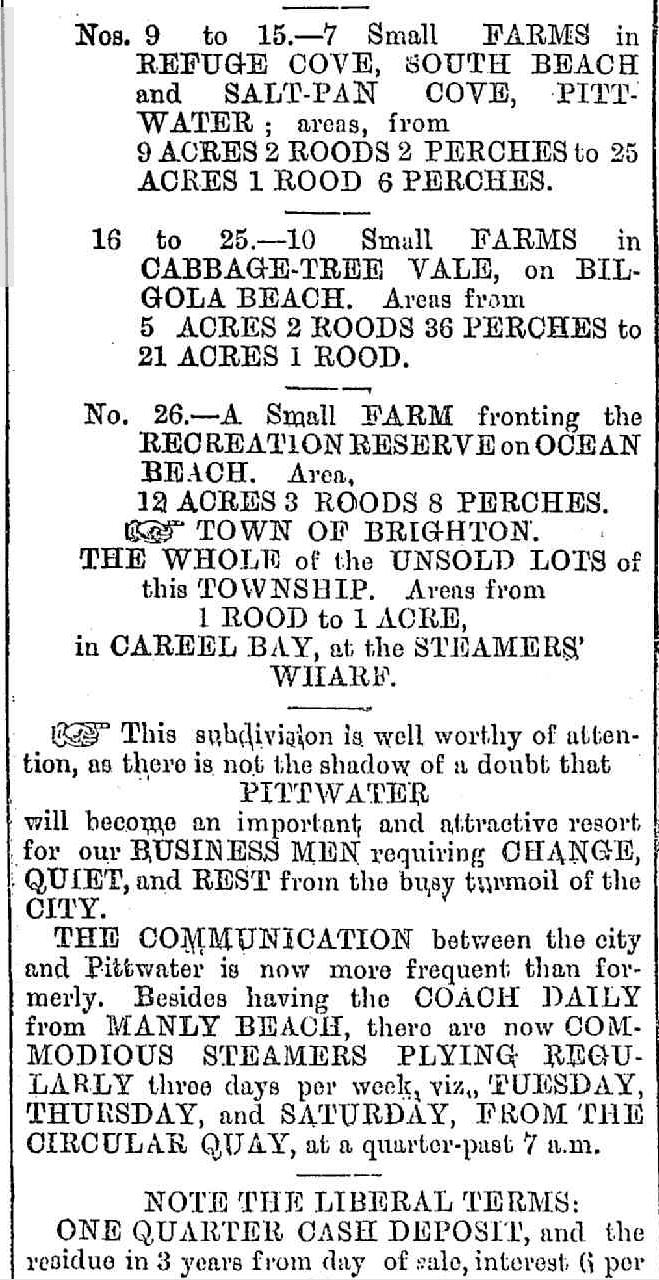
Advertising (1880, April 24). Freeman's Journal (Sydney, NSW : 1850 - 1932), p. 11. Retrieved from http://nla.gov.au/nla.news-article133487003
DISTRICT COURT.
(Before Judge Docker.)
MOTOR CAR AND CYCLE.
Donaldson vs Peters.
Rachel Jane Donaldson, of Murray and Devonshire streets, Croydon, proceeded against William Peters, of Mountjoy, Victoria-street, Ashfield, for alleged negligence; £60 damages was claimed. The petitioner's case was that he was the owner of a motor car, and while driving It the defendant, who was on a motor cycle, so negligently managed, the cycle that he collided with the motor car, damaging It severely. The defence waa a denial of negligence; that the cycle did not cause the damage; and that, it there were any negli-gence, the plaintiff contributed to It. Mr. Maxwell, instructed by Mr. Eric N. Rowley, appeared for the plaintiff; and Mr. Garland, K.C., and Mr. Fuller, Instructed by Messrs. Pigott and Stinson, for the defendant.
The case is part heard. DISTRICT COURT. (1917, May 4). The Sydney Morning Herald (NSW : 1842 - 1954), p. 5. Retrieved from http://nla.gov.au/nla.news-article15715405
Across the Front of the Car
In the District Court case in which Rachel Jane Donaldson claimed £60 compensation from William Peters for damage done to her motor car '.in a collision with Peters' motor cycle. Judge Docker, after inspecting the locality of the accident, yesterday gave a verdict for the plaintiff for £42 4s. The Judge said that the plaintiff at the time of the collision was travelling at more than 20 miles an hour, and that defendant oven passed her. Ho slackened speed to turn a corner, and out across tho front of the ear, which was swerved into the side fence in an endeavor to avoid a collision. Defendant ought to be thankful that ho was not killed as the result of his bravado. The plaintiff had endangered her own life and that of her two daughters in trying to avoid colliding with the motor cycle.
Across the Front of the Car (1917, May 8). The Sun (Sydney, NSW : 1910 - 1954), p. 5. Retrieved from http://nla.gov.au/nla.news-article221966154
SHIRE OF WARRING AH.
Special Loan, £21,000—"A'' Riding.
WARRING AH Shire Council hereby gives notice, in accordance with the provisions of Local Government Act, 1919, that:—
1. The Council proposes to raise a Special Loan of twenty-one thousand founds (£21,000) for the purpose of carrying but in Riding "A" of the Shire certain public works, the acquisition of certain lands for public recreation purposes, and the acquisition of certain lands for road purposes; and for the purpose of paying expenses incidental to the carrying out of such works and acquisitions.
2. The Council proposes to expend the loan money as follows, but reserves the right to utilise the surplus or saving on any one item in paying the excess cost of any
other:—
(a) In Palm Beach-Whale Beach District:
Public Reserve oil shore of Pittwater, Palm Beach — Filling, levelling, and construction of retaining wall £1,000
Ocean Beach Reserve, Palm Beach—Making parking area and constructing pipe-line in southern portion £250
Governor Phillip Park — Erection of public lavatories £500
New Wharf—Construction of, at Palm Beach, Pittwater side £500
Improvements to roads, viz.—Florida-road, £1,000; Pacific-road, £405; Palm Beach
road, £500; road from Barrenjoey-road to Whale Beach, £500; road from Whale
Beach to Palm Beach, £500 2,905
(b) In Avalon-Bilgola-Clareville District:
Public rock-bath at Avalon Beach—Enlargement of £250
Avalon Flat Drainage—Construction of concrete culverts £700
Avalon Beach Reserve, Extension, etc.—
Acquisition of lot 26, Pittwater Estate, with exception of small portion at south
western corner £2,750
Bilgola Beach Reserve—Construction of retaining wall £100
Improvements to roads, viz.—Central-road, £600; George-street, £300 900
(c) In Newport District:
Newport Ocean Beach Reserve — Levelling sand, and top-dressing, on northern
portion £700
Newport Reereation and Sports Ground—
Fencing and other improvements £800
Queen's-parade drainage £ 300 Improvements to roads, viz.—Ocean-avenue,
£400; Foam Crest avenue, £220; Myola road, £270; Bungan Head road, £400; Beaconsfield-street, £200; Karloo-parade, £200; Robertson-road, £150; Bardo-road, £300; King-street* £150; Queen's-parade and Stuart-street, £250 2,540
(d) In Mona Vale-Warriewood District:
Mona Vale Park—Culvert across park from Park-street to Newport-road £200
Drainage works, Bassett-street, at eastern end £600
Footpath formation—Gravelling footpath on Pittwater-road, Mona Vale £100 Improvements to roads, viz. — Darley-street, £400; Bassett-street, £220; Noble-street, £100; Bungan-street, £320; Allen-street, £160; Rickard-avenue, £100; Mona-street and Waterview-street, £250; Vineyard street, £150; Seaview-street, £126 , Seacrest-avenue, £200 : 1,826
(e) At Bay View—Church Point:
Bay View Park Construction of pavilion and boat-shed £750
Church Point-—Reclamation and parking area near public wharf £200
(f) In North Narrabeen District:
Lake Park Extension, and new road—Acquisition of land for enlargement of Lake Park and for new road connecting Narrabeen Park parade and Collins-street ... £1,075 Improvements to roads, viz. — Kobado and Elanora Estate roads, £750; Powderworks-road, £200; Deep Creek road, £200;- Warraba-road, £120; Garden street, £200; Taiyul-road, £200; Collins avenue and Walsh-street, £250 1,920
(g) Incidental and contingent expenses £634
Total £21,000
3. The Council proposes to carry out most of the abovementioned works under the Government's Emergency Relief Scheme. The proposed allocations to those works as set out above, are consequently allocations of loan money only and do not include the wages of the relief workers payable from grants receivable from the Government.
4. Plans and full details of the works to be carried out and of the lands to be acquired by means of the loan money may be inspected at tlie Council's office during the ordinary office hours.
5. The rate of interest on the loan will not exceed four per centum (4%) per annum, and the loan will be issued at par.
6. It is proposed to repay the loan over a period of twelve (12) years by 24 equal half-yearly instalments of principal and interest combined. The amount of each such instalment will be £1,110 os. 10d., or thereabouts.
7. For the purpose of repaying the loan and paying the interest on the loan the Council proposes to levy a rate of two-fifths of a penny (2/5d.) in the £ on the unimproved capital value of all ratable lands in the "A'' Riding of the Shire. (Total u.c.v., £1,326,723.) Should the proposed rate not provide sufficient for the purpose the deficiency will be paid from the General Fund of the Shire and charged to "A" Hiding's portion of that fund. (Nom—The loans of £28,200 and £3,500 raised ten years ago or thereabouts for the carrying out of public works in "A" Biding will be entirely repaid this year, and the present loan rate of 4/5d. in the £ levied in respect of them will not be levied after this year, but will be replaced by the proposed rate of 2/5d.).
8. Within one month of the date of the publication of this notice any number not less than twenty-five per centum (25%) of the ratepayers enrolled for "A" Riding may petition the Council to take a poll of the ratepayers, either as to whether the ratepayers approve of the loan or as to whether the loan rate shall be on the unimproved capital value or improved capital value, or on both questions. The number of ratepayers on the Roll of Electors for "A"' Riding is 5,421.
A. H. HUGHES,
President.
R. G. Jamieson, Shire Clerk.
Shire Hall, Brookvale, 20th July, 1936.
SHIRE OF WARRINGAH. (1936, July 24).Government Gazette of the State of New South Wales (Sydney, NSW : 1901 - 2001), p. 3236. Retrieved from http://nla.gov.au/nla.news-article223038435
Cronulla was, Palm Beach is, and Avalon Beach will be. This is the catch slogan which has been adopted by the vendor of the Palmgrove Estate at Avalon, which is to be sold by Messrs. H. W. Horning and Co., on Boxing Day. Judging by the beautiful panoramic views which appear in an attractive booklet, and which also occupy a conspicuous position in Messrs. Horning and Co.'s windows, Martin-place, the scenery surrounding the estate must be exceptionally beautiful. Avalon is the new seaside resort between Newport and Palm Beach. The Palmgrove Estate is on the main Barrenjoey-road, and is right at the beach. The owner has evidently had the public good in mind, as the estate has been well planted with Ornamental shade trees, while a section of it known as the Palm Grove, has been presented ao a park. This is a remarkable beauty spot, with a wealth of graceful palms, maidenhair, burrawang, and other ferns. The estate is in every respect a most attractive proposition to those looking for week-end and holiday sites. REAL ESTATE NEWS (1921, December 11). Sunday Times (Sydney, NSW : 1895 - 1930), p. 10. Retrieved from http://nla.gov.au/nla.news-article123241058
Week-Enders That Grow
The week-ender idea is developing rapidly in N.S.W., and the reason is the intrusion of flats into suburban and city life.
IT is quite conceivable that within the not-too-distant future all city, people will, be flat dwellers. And what then of home-life and a garden to potter about in?
The week-ender is the answer, and the solution to the problem of happy living in a crowded city. An amazing change has'taken place 1 in the building of week-enders. Fast disappearing are the one-room, crudely-constructed shacks, with no conveniences. People are building houses to live in at the week-ends. Houses with electric light and refrigeration, with modern bathrooms and kitchens, and hot and cold water laid on. The general idea in week-enders seems to be to start with a small construction and extend.
Intriguing Examples
Round about Avalon are ' some intriguing examples that have evolved inlo homes. Generally known as "the daddy of them all is "Trees," once a weekender and now the permanent home of Mr. and Mrs. J. D. Handley. "Trees" was named after the beautiful gum trees that grow abundantly on the hill at the back of Avalon. It was built around one strangely-grown angophora gum that inspired the quaint design of the house as it grew bit by bit. At first it was one main room, the walls and roof of split Douglas fir with the bark left on. Wings were added at either side, each with a walk-out on to a flat roof. Passeia-by have often called "Trees" the "House of the Seven Dwarfs" because of the random stonework that Mr. Handley has himself covered the chimney and the foundations with. Every stone is water-washed and carried up in his car from the from the beach.
Another of. Avalon's most delightful places Is the log cabin, Kooka Cabin, on the Paradise Beach estate, overlooking Pittwater, where Lieutenant and Mrs. J. T. Stapleton and their two little daughters, Patricia and Margaret, spend most of their week-ends. The cabin was originally one room divided down the centre, and had a gauze enclosed verandah. The cost of the original cabin was approximately £275.
A week-ender near "Trees" and in the Tree Colony is "Timbers," and belongs to Mr, and Mrs. A. G. Cable. It is a big house that has been built around one main room. It occupies three blocks of land . . . total cost £450 . . . and the initial cost of the house was £1000, most of that amount going into foundations for the steeply sloped land. The big main room, which makes a baby grand piano look quite a small article of furniture, has galleries at either end. Mrs. Cable has since added two wings with walk-outs from the gallery rooms to each roof.
Just along the road is the weekend house with a wonderful view of Avalon beach through the timber.
This belongs to Miss Stella James and Miss Camilla Wedgwood. They bought four blocks in front of them to preserve the trees.
A house recently constructed at Palm Beach of lined and papered fibro with tiled roof, all electric, with modern bathroom and kitchen, three bedrooms, a living-room 15ft. by 16ft., with flagged pathways and stone retaining walls cost £1200 to build, including £325 for the land; £100 was spent on furnishing it simply but adequately. To bring in some return it is let at £4 10s per week for a three months' tenancy. For short bookings in the peak period it, brings in, £12 a week. For the rest of the year it belongs to the family who owns, it to enjoy their weekends away from the rush of the city.
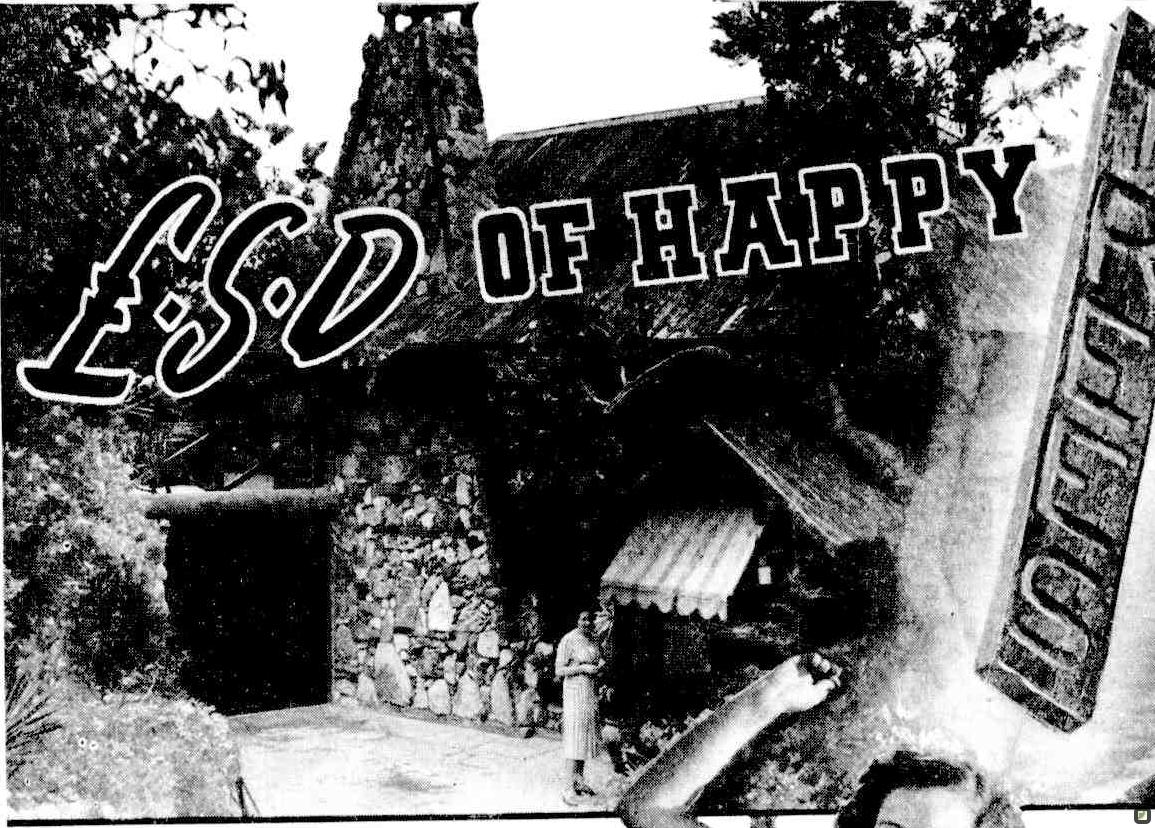
TREES, the house overlooking a timber-framed panorama Avalon Beach, considered the most original house of the northern beaches . . . it just grew and grew from a week-ender to be the permanent home of Mr. and Mrs. J. D. Handley. Mrs. HANDLEY is in the picture. Inset is the actual name-plate of the house, carved in bark.
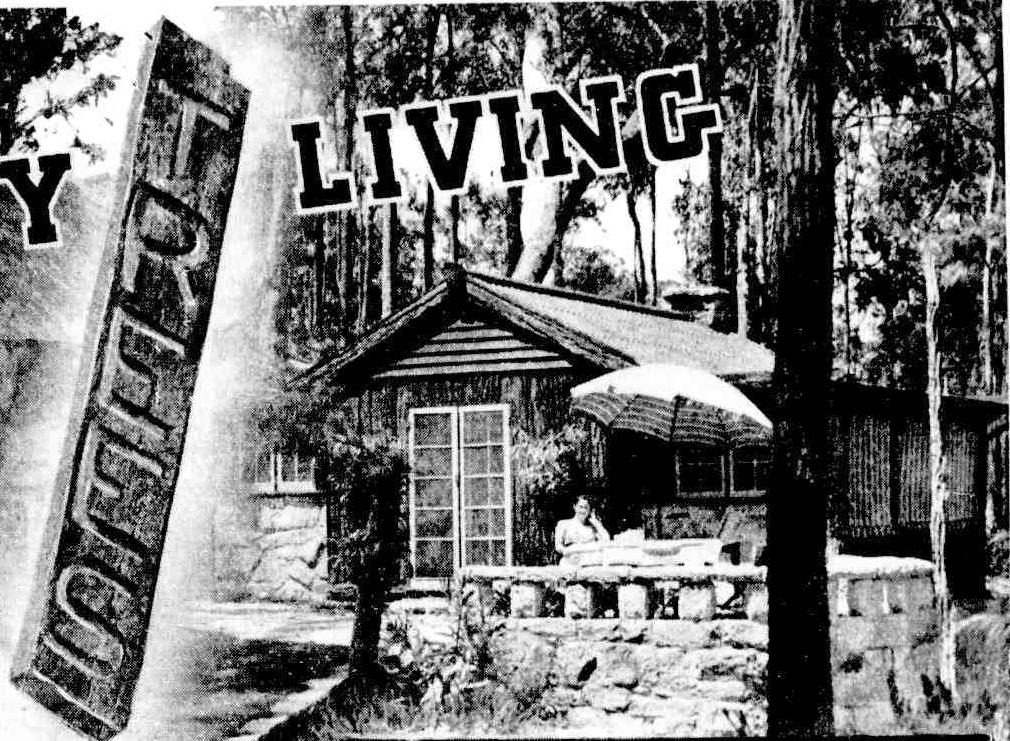
KOOKA CABIN, Lieut. and Mrs. J. T. Stapleton's log cabin among the trees at Paradise. Beach, with Mrs. STAPLETON having tea on the sun terrace. Motorists on the road above, seeing the cabin for the first time, can never resist stopping their cars to exclaim on its charm as it nestles into the hillside.
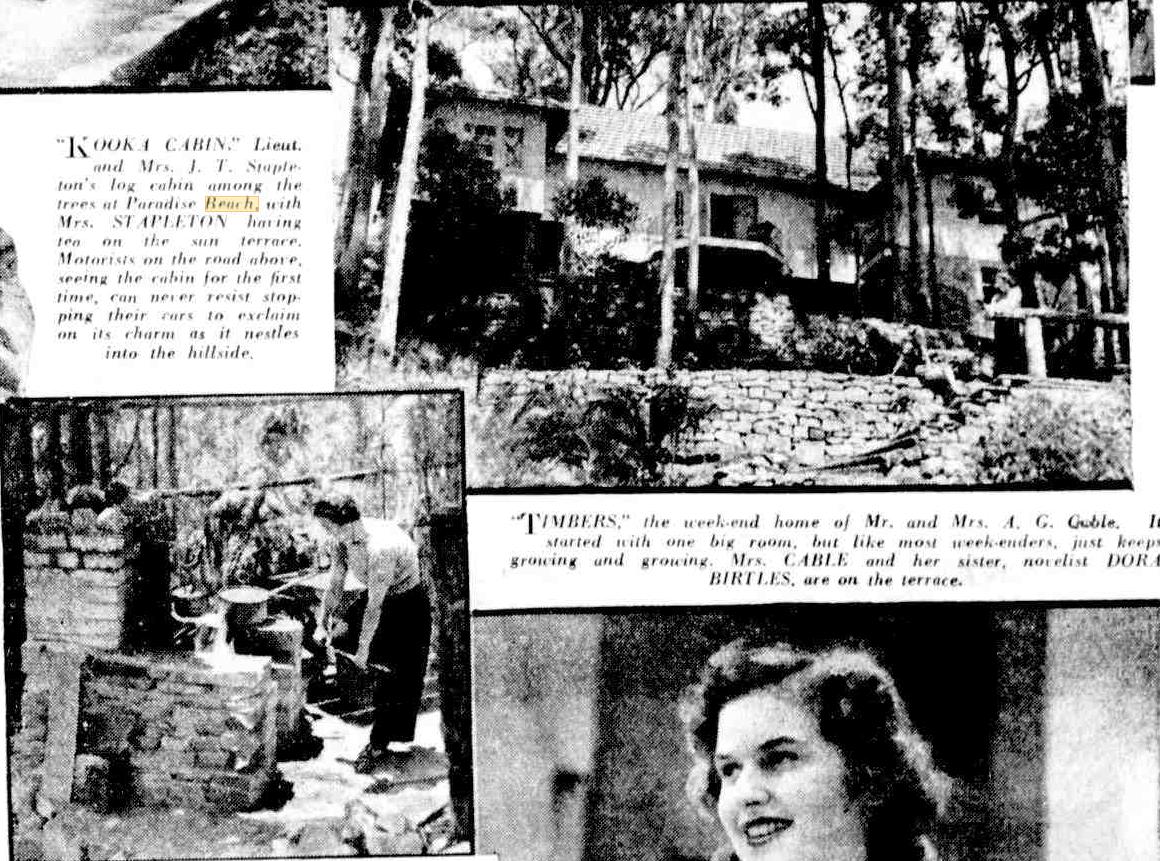
TIMBERS," the week-end home of Mr. and Mrs. A. G. Qable. It started with one big room, but like, most week-enders, just keeps growing and growing. Mrs. CABLE and her sister, novelist DORA BIRTLES, are on the terrace.
F.S.D. OF HAPPY LIVING (1939, November 26). The Sun (Sydney, NSW : 1910 - 1954), p. 1 (WOMEN SECTION SOCIAL). Retrieved from http://nla.gov.au/nla.news-article231502146
PINNED UNDER SULKY
WHILE Mrs. Emma Rogers (74), Hilltop Road, Avalon, was driving a sulky in Avalon Parade, yesterday, the horse shied at a motor bus and bolted, overturning the sulky. Pinned underneath the vehicle, Mrs. Rogers suffered a fractured rib, head Injuries and shock. She was admitted to Manly Hospital. PINNED UNDER SULKY (1943, October 3). Truth (Sydney, NSW : 1894 - 1954), p. 17. Retrieved from http://nla.gov.au/nla.news-article168981832
WILD FLOWERS AND NATIVE PLANTS PROTECTION ACT, 1927-1945.
Appointments of Honorary Rangers.
THE undermentioned persons have been appointed as Honorary Rangers for the purposes of this Act:—
Maxwell James Nugent, 41 Colane-street, Concord West; Edward Wilson Railton, 5 Garden-street, Dundas; Ronald Arthur Searl, 42 Avalon-parade, Avalon Beach; Charles Herbert Milnes, Chisholm-avenue, Avalon Beach; Mary Brigid Milnes, Chisholm-avenue, Avalon Beach.
J. B. RENSHAW, Minister for Local Government.
WILD FLOWERS AND NATIVE PLANTS PROTECTION ACT, 1927-1945. (1955, August 19). Government Gazette of the State of New South Wales (Sydney, NSW : 1901 - 2001), p. 2387. Retrieved from http://nla.gov.au/nla.news-article220386559
Post WWI Building Material Shortages:
Building Materials Circus in Martin Place
Where The Hon. C. Matthews Frolics
Chief product of the .N.S.W. Department of Building Materials, created last June by the McGirr Government, is farce. Dickens's Circumlocution Office was an efficient Government Department compared with the Hon. C. Matthews' outfit. He is in charge.
HE is so very much in charge that he allows no permits for the purchase or distribution of building materials to be issued without his signature. That looks as if the Minister is in deadly earnest about his job. But the extraordinary fact is established that the Minister's signature is attached to some permits almost as soon as they reach his desk while others lie there for months — and are still lying there.
Another curious practice at 34 Martin Place is the method of dealing with applications made daily by desperate home-builders wanting materials to start or complete their houses. They are dealt with alphabetically at the weekly committee meeting. All right? No. You see, they always start at A and seldom get beyond L. So if you are a patient person and your name starts with any letter from 11 to Z, you may wait for years before your application starts on its tortoise journey from official to official. Here is a typical case investigated by Smith's: —
Back in 1946. L. L. Woolacott, journalist and publisher, retired to a stone house purchased at Avalon Beach. When he bought it from its original owner, the place was incomplete. No toilet had been installed and no bath. He applied to the Department of Labor, Industry, and Social Welfare, housed at 132 George Street North. After climbing from floor to floor and questioning six clerks, he at last was interviewed on the top floor by a cheery young fellow who first of all insisted that nothing could be supplied as Wooiacott was not building a new house, but was only improving an old one.
When.... that he and his wife must have a bath and a toilet-suite, he was handed a form to fill in. That was in September, 1946. He waited a couple of months. No reply. He dug out the cheery young chap again, who told him this time that his application would probably not be reached until 1947. Up to May, 1947. Woolacott could get no satisfaction from 132 George Street North. In June, he phoned the cheery young chap. "Oh, your application," he said. "Sorry. We no longer handle that sort of thing. A new department has been started. Down at 34 Martin Place. We've sent, all the applications there. But you'll have to apply again." "Why?" demanded Woolacott. "Because they've lost 'em all !" was the reply Later, Woolacott managed to extract corroboration of that astonishing fact from a girl employee at 34 Martin Place.
He ....asked his wife to take over the job. Here is her experience to-date : —
July 2 5, 1947. — Letter from W J. Harrison, Director, saying that an Inspector would call to inspect the ..and report whether Woolacott was entitled to have a bath and a toilet-suite.
August 5.— A representative of the Department of Building Materials arrives in a car and solemnly, inspects the bath-room
October 3. — Letter, signed by the Secretary, to say that Metiers Limited had been directed to supply the materials. Mrs. W phoned Metiers, who told her they didn't make low-down toilet-suites. She then phoned the Dept. She was told that they would get in touch with the retailer (Swans Ltd.). She then saw somebody at Swans, who told her that the Department had "wiped" Metters and were directing Fowlers to fill the orders.
October 15. — Mrs. W. rang Fowlers, who told her they knew nothing about the matter!
October 16. — She rang the Department again. She was told that before Fowlers could be directed to supply Swans Ltd. the routine would have to be gone through all over again— that the Minister's consent would again have to be secured! When and if that happened, Fowlers and the Woolacotts would be notified.
October 20. — Letter from the Secretary, to say that if a white suite instead of a green suite is acceptable. Fowler Vianini may be able to supply within four weeks. Woolacott has how Replied that he doesn't care a hoot if it's a bilious yellow spotted with pink' — all he wants is a bath and a toilet-suite. The Woolacotts are only one family among hundreds who are being put through the hoops by those jolly ring-masters, the officials of Building Materials Circus, now continuously performing-in Ocean House. Martin Place, Sydney; "
Building Materials Circus In Martin Place (1947, November 1). Smith's Weekly (Sydney, NSW : 1919 - 1950), p. 2. Retrieved from http://nla.gov.au/nla.news-article234634869
Albert Travers Black
NOTICE is hereby given that the partnership lately subsisting between us, the undersigned Walter Edgeley Bird, Albert Travers Black, and Ernest Samuel Barter, manufacturers, agents, and indent merchants at Sydney, in the State of New South Wales, under the style or firm of Barter, Bird, and\ Company, has this day been dissolved by mutual consent, AH debts due to, or owing by the said late firm will be received and paid by the said Ernest Samuel Barter, who will continue the said ,business under the style or firm of E. S. Barter.
As witness our hands this 23rd day of December, 1904-.
ERNEST S. BARTER.
Witness.to signature of E. S. Barter,— Cecil A. Cogulan, Solicitor, Sydney,
WALTER E. BIRD, A. T. BLACK, By his Agent— Walter E. Bird.
Witness to signatures of W. E. Bird and A. T. Black,— Frank Biggs, Conveyancer, Sydney. NOTICE is hereby given that the partnership lately subsisting (1905, March 14). Government Gazette of the State of New South Wales (Sydney, NSW : 1901 - 2001), p. 1823. Retrieved from http://nla.gov.au/nla.news-article220927622
NOTICE is hereby given that the partnership lately subsisting between us, the undersigned, Peter Bastion and Edward Rivers, carrying on business as business brokers and estate and general agents, at 472 George-street, Sydney, under the style or firm of \W. King & Co., has this day been dissolved by mutual consent. The said Edward Rivers retires from the said late firm, which will in future be carried on by the said Peter Bastion and Albert Travers Black, under the style or firm of W. King Co., and all debts due to or owing by the said late firm will be received and paid by the said Peter Bastion. —As witness our hands, this 12th day of March, 1913.
Witness,—Alex. Mahtin, J.P. EDWARD RIVERS.
PETER BASTION.
Alfred Mitchell, Solicitor, Sydney. NOTICE is hereby given that the partnership lately subsisting between us, the undersigned, Peter Bastion and Edward (1913, March 19). Government Gazette of the State of New South Wales (Sydney, NSW : 1901 - 2001), p. 1784. Retrieved from http://nla.gov.au/nla.news-article226760046
To receive the Distinguished Service Cross.
Lieut. Albert Travers Black, R.N.V.R.. For distinguished services in connection with minesweeping operations. (R.N.V.R.; Royal Navy Volunteer Reserves.)
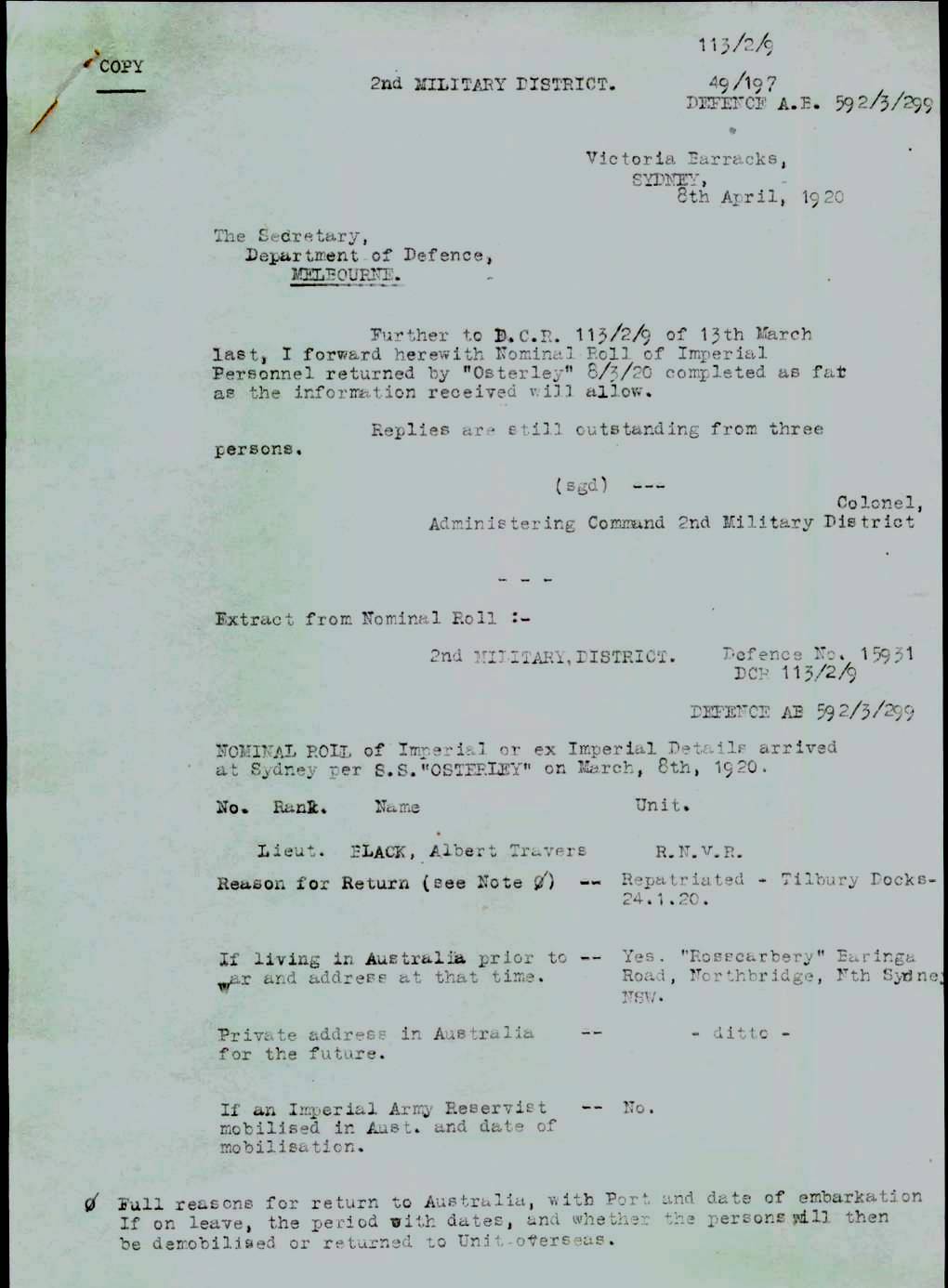
Application for Letters Patent for an invention by Frank Edmonds, Albert Travers Black and George Nicholas Sadleir titled, Improvements in chemical closets. 1927- National Archives of Australia
LAW NOTICES FOR TODAY
HIGH. COURT.
Mr Justice Williams-No 1 Court-10: Re Letters Patent No 6 790 granted to Frank Edmonds Albert Travers Black and George Nicholas Sadlier ex parte Hygeis Sanitary Co Pty Ltd. LAW NOTICES FOR TO-DAY (1944, July 25). The Sydney Morning Herald (NSW : 1842 - 1954), p. 5. Retrieved from http://nla.gov.au/nla.news-article17914796
For Mineral Leases. (1931-10,229 L.B.)
Uralla No. 137, Albert Travers Black, portion gl 46,county Bandon, parish Etimore, 20 acres, dated 17th April, 1931.
Uralla No. 138, Albert Travers Black, portion gl 57, county Sandon, parish Enmore, 24 a. 3 r. 6 p., dated 17th April, 1931. 1931
Mines Department Notices, NOTICES TO APPLICANTS FOR LEASES FOE MINING AND FOR PURPOSES IN CONNECTION WITH MINING; TO THE LESSEES UNDER SUCH LEASES; AND TO WHOM IT MAY CONCERN. (1931, July 17). Government Gazette of the State of New South Wales (Sydney, NSW : 1901 - 2001), p. 2551. Retrieved from http://nla.gov.au/nla.news-article220365834
NOTICE UNDER MINING ACT, 1906—APPLICATION FOR A DREDGING LEASE.
AN inquiry in terms of section 91, Mining Act, 1906, will be held as follows:—Application No. 587, by Albert Travers Black, to mine for sea shells by means of dredging plant, on portion ml 1, parish Kincumber, county Northumberland, embracing an area of 50 acres, comprising part of Cockle Bay and Cockle Creek or The Broadwater below high-water mark fronting portions 123, 42 and 43, at Warden's Court, Newcastle, on Friday, 24th March, 1939, at 11.30 a.m.
Objections to the application must be lodged in the Warden's Office where application made on or before the, date of the inquiry.
F. A. HYNES, Warden.
20th February, 1939. NOTICE UNDER MINING ACT, 1906—APPLICATION FOR A DREDGING LEASE. (1939, March 10). Government Gazette of the State of New South Wales (Sydney, NSW : 1901 - 2001), p. 1216. Retrieved from http://nla.gov.au/nla.news-article222062250
THE Companies Act, 1936 (No Liability Company).—Part 1.— Memorandum for Registration of GROVENOR (LEAD) NO LIABILITY.—(1) The name of the Company is to be "Grovenor (Lead) No Liability." (2) The objects of the Company are—(a) To acquire from the vendors the right to carry out mining operations until 12th September, 1952, to a depth of 120 feet from the original ground level at No. 4 shaft in that part of the areas known as "the Grosvenor workings'' and forming part of the area known as "ml 44 Dunedoo" more particularly defined in the Schedule and plan in the agreement hereinafter mentioned and made between the vendors and James Hilton; (b) to acquire the whole of the mining plant and machinery at present situated on the before mentioned area; (c) to acquire and treat the dumps on the before mentioned area; (d) to adopt and carry into effect with or without modification agreement dated the 21st day of June, 1948, made between Albert Travers Black, George Nicholas Sadleir and Robert Allan Spence as vendors, and James Hilton as trustee for this Company as purchaser; (e) to pay all expenses of and incidental to the formation of the Company; to do all other acts, deeds, matters and things alone or jointly with any other person or persons, corporation or corporations which the directors may think incidental or conducive to the objects or interests of the Company or any of them, and to enter into and execute all deeds, documents and/or other writings which may be necessary or expedient for the purposes of the Company. (3) The first place of intended operations is at Leadville, in the State of New South Wales. (4) The first registered office of the Company will be situated at 92 Pitt-street, Sydney, in the State of New South Wales. (5) The members incur no liability. (6) The value of the Company's intended property, including plant and machinery, is five thousand five hundred pounds (£5,500). (7) The amount of money at the credit of the Company or any person on its behalf is £2,000, and the total liability of the Company or which the Company is intended to assume or undertake is £700 in cash and the allotment to the vendors and/or their nominees of 20,000 fully paid-up shares in the capital of the Company. (8) The nominal capital of the Company is £10,000 divided into 40,000 shares of 5s. each. (9) The number of contributing shares subscribed for is 20,000. (10) The name of the provisional manager is James Hilton. (11) Ten per centum of the contributing capital has been duly paid up in cash. (12) The only contract entered into on behalf of this Company is an agreement dated the 21st day of June, 1948, made between Albert Travers Black, George Nicholas Sadleir and Robert Allan Spence as vendors, and James Hilton as trustee for this Company as purchaser.
We, the persons whose names and addresses are subscribed, hereby apply to register Grovenor (Lead) No Liability as a No Liability Company, and we respectively agree to take the number of shares in the capital of the Company set opposite our respective names:—ALBERT TRAVERS BLACK, Mining Engineer, 26 Bridge-street, Sydney, 200 (two hundred); ROBERT ALLAN SPENCE, Metallurgist, 30 Grasmere-road, Cremorne, 200 (two hundred); GEORGE NICHOLAS SADLEIR, Company Manager, 26 Bridge-street, Sydney, 200 (two hundred) ; BERTIE NORMAN BLACK, Shipbroker, 26 Bridge-street, Sydney, 100 (one hundred); OLIVE PERLE SPENCE, Teacher, 30 Grasmere-road, Cremorne, Sydney, 1 (one); MELINA ELLEN SPENCE, Tutor, 30 Grasmere-road, Cremorne, Sydney, 200 (two hundred) ; MALCOLM DOUGLAS HERBERT, Master Builder, 21 Jubilee-street, Wahroonga. N.S.W., 200 (two hundred). Witness to all the above signatures,—Frederick Clive Emanuel, 28 O'Connell-street, Sydney,
Solicitor.
Dated this twenty-first day of June, 1948.
I, James Hilton, of 92 Pitt-street, Sydney, in the State of New South Wales, Company Manager, do hereby solemnly and sincerely declare and affirm that:—(1) I am the provisional manager for the said intended Company. (2) The above statements are to the best of my belief and knowledge true in every particular. And I make this solemn declaration as to the matters aforesaid according to the law in this behalf made and subject to the punishment by law provided for any wilfully false statement in any such declaration. JAMES HILTON. —Declared at Sydney, this 21st day of July, 1948, before me, T. A. Bowbing, J.P. 2456—£3 THE Companies Act, 1936 (No Liability Company).—Part 1.—Memorandum for Registration of GROVENOR (LEAD) NO (1948, September 3). Government Gazette of the State of New South Wales (Sydney, NSW : 1901 - 2001), p. 2314. Retrieved from http://nla.gov.au/nla.news-article224782172
DEATH OF SIR JOHN LONGSTAFF
Sir John Longstaff, doyen of Australian artists, died yesterday in a private hospital in Melbourne. He had been in ill-health for some time, and his condition became serious last week when he injured himself in a fall at his home in East Melbourne.
For many years an outstanding figure in Australian art, Sir John Longstaff was a portraitist with a world-wide reputation. His portraits were 5 times awarded the Archibald Prize. He was a member of the Royal Portrait Society, an exhibitor at the Paris Salon since 1891, and at the Royal Academy since 1893. He is represented in most Australian galleries. Sir Keith Murdoch, National Gallery Trustees president, yesterday paid great tribute to Sir John Long staff. His work, he said, had been of great value to Australia. Many of his portraits would live a long time as good and representative art, and they would have historic interest for many generations.
"His influence as a painter of great culture, fine taste, uprightness, and knowledge has been felt throughout the community," Sir Keith Murdoch continued. "He had generous sympathies, helped many young artists, and was beloved by his fellow painters. He took great interest in the work of the trustees of the Gallery, where he sat for more than 20 years. His colleagues had a deep respect for his judgment."
Born at Clunes (Vic) on March 10, 1862, Sir John Longstaff was educated at the Clunes State school, and showed exceptional ability in his youth. First step in his career was to win the first travelling scholarship given by the Victorian Government in 1887 with a picture now famous, "Breaking the News."
With his wife, a daughter of the late Mr Henry Crocker, the young artist went to Paris in 1888 where he studied at the atelier of Fernand Cormon. He at once began to attract attention there with his forceful and charming style. In 1891 he received an honourable mention at the Paris Salon for a portrait of his wife and their infant son. After this he was an annual exhibitor in Burlington House until 1896 when he returned to Australia and remained for 5 years.
During this period he painted many fine portraits including those of Sir Arthur Snowden, Mrs. Butler, Robt. Landale, Rupert Ryan, Jas. S. MacDonald, Henry Lawson, J. F. Archibald, Sir Edward Knox, Sir Frederick Darley, Marjorie Williamson, Leslie Mather, Mrs. George Lansell and Mrs. Alex Hay. Back in London in 1901 he established himself in St. Johns Wood where he painted numerous portraits including those of King Edward VII and Queen Alexandra. Other well known works included "Burke and Wills at Coopers Creek" "The Sirens" and "The Lady in Black." During the last war he was official artist with the AIF in France and on his return to Australia in 1919 he completed a series of war pictures which are now in the Australian War Museum.
Despite his prolific production of portraits and other works, Sir John Longstaff found time to assist many Australian art societies. From time to time he was president of the Australian Art Association and the Victorian Artists Society, vice-president of the Society of Artists and foundation member and president of the Australian Academy of Art.
In 1927 he became a trustee of the National Gallery and was knighted in 1928, the first Australian artist to receive that distinction. He was awarded the medal of the Advance Australia Association in 1933. The funeral will leave the Camberwell branch of Le Pine and Son at 11am today for Springvale Crematorium, where Rev. O. J. Flock Hart will conduct the service.
DEATH OF SIR JOHN LONGSTAFF (1941, October 2). The Argus (Melbourne, Vic. : 1848 - 1957), p. 3. Retrieved from http://nla.gov.au/nla.news-article8208231
Every day until July 31, the important display of Australian landscapes at the Dubbo Mechanics' Institute will be on view, admission free, to the Dubbo public. To make the exhibition of interest to those who are net used to gallery-scanning, 'The Liberal' has prepared a full list of the exhibits, with vital facts about each of the artists.
The pictures are hung on the walls of the reading room, and each one is plainly numbered.
No. 1 is a landscape on stretched canvas, by Conrad Martens, a Londoner, born in 1801 who became a student of the celebrated Copley Fielding, a member of the English Water Color Society from 1810 onwards. Martens came to Sydney in 1835 via Tahiti and N.Z. in 1863 he was appointed Assistant parliamentary Librarian and held it until his death in 1878. Martens painted in various sports around early Sydney and in Queensland. Most of his work was in watercolor.
No. 2 is a view of gum trees, a pool and cattle, painted on cardboard by Nicholas Chevalier, who was born in 1828 at St. Petersburg of Swiss parents. He studied in Rome and London and learned lithography from Louis Gruner, the great German engraver of the 19th century. Chevalier, arriving in Melbourne in 1855, became the first cartoonist to Melbourne 'Punch.' He painted in N.Z. for a couple of years, then returned to London, where he died in 1902.
No. 3 is a view of Mt. Olympus, painted on stretched canvas by William Charles Piguenit in 1875. Piguenit was born in Hobart in 1826 and, after 23 years with the Tasmanian Survey Department, he resigned to give all his time to painting. He settled in Sydney in 1880 and was foundation member of the Art Society of N.S.W. He visited London in 1898 and exhibited at the Old Salon in Paris. He was awarded the Wynne Prize in 1901. In 1914, he died at Hunters Hill, Sydney.
No. 4 is an impression of a storm, painted by Walter Withers on stretched canvas. Withers did not arrive in Melbourne until 1822, at the age of 28. He was a Staffordshire man and returned to Paris from Melbourne to study at the famous Julien's Academy for two years (1887-88). He was the first winner of the Wynne Prize (1887) and he won it again in 1907. He was president of the Victorian Artists' Society in 1904-5, and a foundation member of the Australian Art Association in 1912. . From 1912 to 1914, the year he died, he was a Trustee of the Melbourne Gallery.
No 5 is by Tom Roberts, born at Dorchester, England in 1856. He is represented in Dubbo by a picture of Sherbrooke Forest, painted on canvas on board. Roberts arrived in Melbourne when he was 13. His early training was, at the National Gallery School, Melbourne, and late' at the Royal Academy Schools. He painted throughout France and Spain and then returned to Australia in 1885. He came back infected— to use the word applied by his enemies — with Impressionism, but he managed to found a strong school of Impressionism in Australia. In 1901 he went to England to complete his painting, The Opening of the First Commonwealth Parliament. In 1923 he returned to Australia and became the first President of the Society of Artists, which was founded in 1895.
No. 6 is a sombre landscape, on stretched canvas, painted by the man who became Sir John Longstaff in 1928. Longstaff was born at Clunes, Victoria, in 1862 and studied at the Melbourne National Gallery School, and was awarded the Travelling Scholarship in 1887. He continued his studies in Paris. He exhibited, at the Royal Academy and the Old Salon. In the 1914-18 War he was official War Artist with the A.I.F. in France. On his return to Australia he painted many portraits of well-known men and women. In 1924-5 he was President of the Victorian Artists' Society and broke away to become the President of the Australian Art Society from 1926 until his death in 1941.
No. 7 is a landscape, Passing Showers, painted by Streeton on stretched canvas. Arthur Streeton (knighted in 1937) was born not far from Geelong, Victoria. He, too, came under the Impressionistic school introduced by Tom Roberts, in revolt against' the earner Romantic school. In 1890 he settled in Sydney and for five years exhibited with the Royal Art Society. In 1898 he went to London and exhibited with the Royal Academy and. several other exhibitions, including the Old Salon. After his return from the 1914-18 war as an official artist in France, he returned to a successful career in Australia. He Won the Wynne Prize in 1928 and died in Melbourne in 1942.
No. 8 is by a son of the most beloved of all Australian art teachers in Australia, Julian Ashton. He had a son Julian Howard Ashton, who studied under him for nearly seven years, is represented in the Dubbo Exhibition by a painstaking painting of a craggy mountain, painted on canvas on board. Ashton was born in London in 1877. He is still alive and was for some years the Art Critic of the Sydney Sun.
No. 9 is a lovely piece of work on stretched canvas by Hans Heysen. The Track to the Farm, painted in 1926. Heysen was born in Hamburg in 1877 and arrived in Adelaide at the age of six. He studied at the Norwood Art School and the Adelaide School of Design. From 1899 to 1903 he studied in Europe at Julien's and the Beaux Arts. Back in Australia by 1903, it was five years before he held a successful exhibition in Melbourne in 1908. He won the Wynne Prize in 1904, 1909, 1911, 1920, 1922, 1924 and 1926. In 1931, he won the Crouch Prize. In 1934, he again visited Europe. He is now 74 and is still painting.
No. 10 is an impression of a landscape lit by an early morning moon. It is on stretched canvas, and was painted by Sid Long in 1937. Long was born in Goulburn in 1878 and like many other Australian artists of reputation, studied under Julian Ashton before going overseas. In England he exhibited at the Royal Academy and was elected A.R.E. He was the storm centre in Australia of several conflicting art interests and societies. He was awarded the Wynne Prize in 1938 and 1940. He is still painting.
No. 11 is a painting of Kosciusko in stretched canvas of Julian William Ashton, more familiarly known as Will Ashton. He was born at York, England, in 1881 and arrived in Adelaide at the ripe age of three. He studied under his father and later under Julius Olsson, R.A. and A. M. Talmage, R.A., at St. Ives, Cornwall, and at the Acamedie Julius, Paris. He exhibited at the Old and New Salons, and various other exhibitions. He is still painting, but with very little development despite various trips to Europe. He won the Wynne Prize three times— in 1903, 1930 and 1939, the Godfrey Rivers Prize in 1933.
No. 12 is Elioth Gruner's celebrated Frosty Sunrise, which is painted on canvas mounted oil panel, and which should especially appeal to Dubbo people. It oozes, frostiness. Gruner painted it in1937, and at a meal with the present chronicler, told him that he painted it while he shivered. Gruner was a New Zealander and was brought to Australia when he was one year old. He, also, was a product of the Julian Ashton studio in Sydney. He won the Wynne Prize in 1916, 1919, 1921, 1929, 1936 and 1937. He died in 1939.
No. 13, painted by Margaret Rose Preston on masonite, is a study of a grey day in the ranies. She painted it in 1942, in her 67th year. Born in South Australia in 1883, she studied at the National Gallery School and at Munich and Paris. She is better known for her studies in various mediums of Australian flora than for her landscapes.
No. 14 is a study, on stretched canvas, of Kiama township. It is by Desiderius Orban, who was born at Gyor, Hungary, in 1884 and who first took a degree in mathematics at Budapest University. He travelled much in Europe and it is important for Australians to remember that he is self-taught. He did not reach Sydney until 1939, after he had founded an advanced art group in 1908, been awarded a Gold Medal in Barcelona in 1929, and in Budapest in 1931, founded and became principal of the Atelier Art and Crafts Academie. He has been a storm centre in Australian art circles, but is a member of the Society of Artists and the Contemporary Art Society.
No. 15, by James Ranalph Jackson, is a view of the viaduct sodwalls, on stretched canvas. Jackson is another New Zealander, born at Palmerston North in 1886. He was eight when he came to Sydney. He was sent to Frank Brangwyn's class at the Royal Art Society's School in London, and later went to study under Colarossi in his Parisian studio. Jackson was an instructor at the Royal Art Society's School from 1917 to 1926.
No. 16 is a pastoral effort by Roland Wakelin, on cardboard, who did it in 1947. Still another New Zealander, Wakelin was born at Greytown in 1887, and attended the life class of the Technical School, Wellington. After exhibiting in N.Z. he settled in Sydney in 1913. He studied under Dattilo-Rubbo, a long established migrant who was a teacher at the Royal Art Society's School. Wakelin, after a period of study of the postimpressionists In London and Paris, came back to Australia as a champion of the ultra-modern movement in art. He is a member of the Society of Artists.
No. 17 is a study of haymakers, painted on stretched canvas. The artist is William Beckwith McInnes, who was born in 1839 at Ringwood, Victoria, and died in 1936. He is a product of the National 'Gallery School, Melbourne, of which he was Drawing Master until 1933. He won six Archibald Prizes and the Wynne Prize in 1918.
No. 18 is a landscape of typical Dubbo country, on stretched canvas, by Robert Johnson, still another New Zealander who, after studying at the Elam School of Art, Auckland, settled. in Sydney. He was born in 1890 and is a member of the Royal Art Society.
No. 19 is an evening landscape on stretched canvas, by Lloyd Frederick Rees. Rees was born in Brisbane in 1895 and studied at the Brisbane Technical College. He came to Sydney in 1917 and worked and exhibited in Sydney until 1923. He studied in Europe from 1923 to 1924.
No. 20 is a queer but fascinating product of a bit of N.S.W. bush, by an Australian, born in Melbourne in 1897. Arnold Joseph Victor Shore is an extraordinary example of what may be called early revolt, the product of the rorniulist, Max Meldrum, of whom he is a student, and who until 1930 was a spare-time painter, while still working as a stained glass craftsman and artist. During the last 20 years he has been a painter, art critic, lecturer and broadcaster. He won the Crouch Prize, at Ballarat, in 1938 and shared the 'Herald' Prize with Sir John Longstaff in the same year.
No. 21 is by Grace Crossington Smith, an arresting piece of work on masonite, Bush at Evening. She is a Sydneyite, born in 1892, and is a modern of the moderns (in Australia), with a conventional background of study under the conventionalists, Albert Collins, Alfred Coffey and Dattilo-Rubbo. She went to Europe in 1912 and continued her studies in England and Germany. With Roi de Mestre and Roland Wakelin she was one of the founders of the Australian modern movement influenced by post-impressionism.
The man from Zurich, Sali Herman, has settled in Sydney since 1938, after years, following his studies at the Zurich Technical School for two years spent as a dealer in art. His work, No. 22, a Taree scene, painted in 1950 on stretched canvas.
No. 23 is a picture by George Feather Lawrence. It is painted on cardboard and has the title, River Suburb. Lawrence was born in Sydney in 1901 and is still another Julian Ashton student. In 1949 he won the Wynne Prize.
No. 24. That amazing person, Arthur James Murch, still a stripling of 49, and now settled (more or less) at Avalon Beach, N.S.W. was trained first of all as a mechanical engineer. After years of study at the Royal Art Society School and in modelling (he is still a sculptor as well as a painter), at the East Sydney Technical College, he won the Society of Artists' Travelling Scholarship in 1925. He continued his training at the Chelsea Polytechnic and at the old British School in Rome. Back in Sydney by 1927, he was one of George Lambert's proteges. Went on a scientific expedition to Central Australia. Went to Europe again in 1936. Superintended the Australian Section of Australian sculpture and painting at the Glasgow Exhibition. Back ' his own country, 1940. War artist, 1942. Won Archibald Prize, 1949. Member of the Society of Artists. Now lecturer in sculpture at East Sydney Technical College. Still, furiously producing pictures and sculptures.
No. 25 is a picture of deserted barns at the Oaks, by George Bernard Buncon, who was born in Auckland, N.Z. in 1904. He is a product of Dattilo-Rubbo, in Sydney. He visited Europe in 1933. Returned to Sydney in 1940.
No. 26 is a picture of a road and some racks, by George Russell Brysdale, who was born at Eognor Regis (England) in 1912. Came to Australia very young George Bell was his master in Melbourne in 1935. Later worked in London and Paris. Came back to Melbourne but settled in Sydney and was awarded the Wynne Prize in 1947.
No. 27 is a delicate study of a country lane, done on masonite, by Lance Vaiben Solomon, who was born at Liverpool, N.S.W., in 1913. He studied at the Technical College, Sydney, and won the Landscape Travelling Scholarship in 1939, and the Wynne Prize in 1946. He is a member of the Royal Art Society.
No. 28, by Donald Stuart Leslie Friend, is a Queensland study of a store at Cairns. It is painted on three-ply. Donald is a queer mixture of influences. He is now in his 36th year and is at present a combined product of the East Sydney Technical College, Dattilo-Rubbo, Syd Long and, in England, Meninski and Gercler.
No. 29 is an ultra-modernistic impression of what is entitled Capricornia by Roderick Malcolm Shaw. It is painted on canvas on top of three-ply. Shaw is a Sydney man, born in 1915. He was a member of the Contemporary Art Society from 1940 to 1948. He is now a member of the Studio of Realist Art.
No. 30 is entitled 'Carion Plains.' It was painted on ripolin mounted on Swedish board by Sidney Robert Nolan, a young man in his 34th year, born in Melbourne, who has studied at various Technical Schools and the Melbourne National Art Gallery.
THE MEN BEHIND THE PICTURES (1951, July 19). The Dubbo Liberal and Macquarie Advocate (NSW : 1894 - 1954), p. 2. Retrieved from http://nla.gov.au/nla.news-article131345469
Colonel F. J Board and the Jolly family continued to work together:
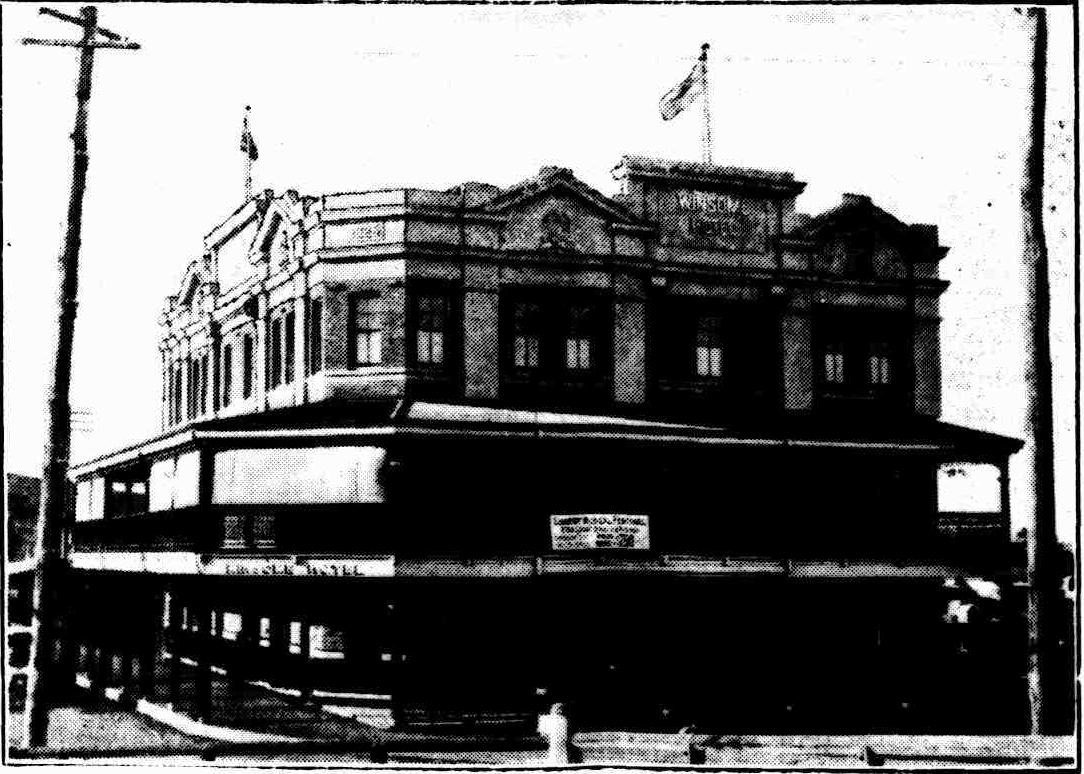
THE WINSOME HOTEL-HANDSOME NEW BUILDING

This magnificent brick building at Lismore, situated between the two bridges within easy distance of railway and boat, has just been erected by Brown and Jolly, Ltd., the well-known contractors, for Messrs. Tooth and Co. Messsrs. Copeman and Lemont, in conjunction with Col. F. J. Board, were the architects. The building is beautifully fitted up inside, the complete furnishings being also supplied by Brown and Jolly, Ltd., who have now completed the furnishings of most of the principal hotels on the coast. The bedrooms, which are large and airy and only contain one bed of silver grey and nickel, are also fitted with a bedroom suite of polished maple each. There is a lounge room on each floor most comfortably furnished. The dining-room upstairs and lounge room are combined, and form a cosy idea of comfort. The public dining-room is on the ground floor, and is directly connected with the serveries, which are most convenient and up to date. There is hot and cold water throughout the building, and the beautifully tiled bathrooms and fitments should be sufficient recommendation themselves. There are very few hotels in the metropolitan area at the present equal to the present hotels now being erected on the North Coast. It shows that the people with capital still have confidence in the district, and seeing that all the work in connection with these buildings has been obtained by Messrs. Brown and Jolly, Ltd., it speaks volumes for the quality of their work. The same firm are just completing the furnishing of the Fero's Hotel, in the famous Dorrigo district. The new Lismore hotel, Winsome, is now open to the travelling public, and the genial host, Mr. F. Rudder, is there to welcome them and make their stay most comfortable. There is ample accommodation for cars and other vehicles.
THE WINSOME HOTEL-HANDSOME NEW BUILDING (1925, August 13). Northern Star (Lismore, NSW : 1876 - 1954), p. 7. Retrieved from http://nla.gov.au/nla.news-article93531217
Murwillumbah—Erection of block of eight residential flats.—F. J. Board and Son, Lismore, architects; Brown and Jolly, Lismore, builders.
Lismore—Erection of large talkie theatre.—F. J. Board and Son, Lismore, architects; P. A. Nott, Hamilton, N.S.W., builder.
Dee Why—Erection of Residence.—O. A. Beattie, architect; W. A. Dawson, 33 Wattle Avenue, Manly, builder. Tenders Accepted or Received (1935, July 3). Construction and Real Estate Journal (Sydney, NSW : 1930 - 1938), p. 13. Retrieved from http://nla.gov.au/nla.news-article222916379
Mr. Jolly's father and brother - full steam ahead mid Depression:
A BUSINESS ROMANCE
Lismore Firm's Growth
BIGGER PREMISES
Allied with the commercial history of Lismore for the last 52 years have been the names of Messrs. Brown and Jolly, the additions to whose premises in Woodlark-street will be opened at 3.30 p.m. on Tuesday. The firm was founded in 1881 by Mr. James Jolly, who it as present in Lismore and is still a member of the Board of Director's. Coming to Australia in that year, Mr. Jolly was among the pioneers who visualised the possibilities of the Richmond district, and he started business in a small factory built on a site now known as Glasgow-lane.
In 1883 he was joined by the late Mr. J. Brown, who on his arrival in Australia, was also attracted to this part of the State. With the growth of the district the original building soon became inadequate and in 1890 a new factory was erected in Little Keen-street. In 1895 new premises were secured in Woodlark-street and the present site of Carlton's was utilised for -.a factory site. To keep pace with the rapid expansion of business it became necessary to erect a new factory in Larkin's-lane at. the. rear of the present premises in Woodlark-street.
COMPANY FLOATED
In 1912 the concern was floated into a private company, and in 1921 a public limited company was launch- . ed. Business continued to expand, and in 1921, the present- large factory at South Lismore, adjoining the railway, extensive alterations and additions to their premises in Woodlark-street will be opened on Tuesday afternoon. The elaborate new showrooms, which, will provide the firm with . a total floor space of 20,000 square feet, will be the largest and best equipped -in any country town. A feature of the new additions is the provision of a well appointed ladies' lounge and writing room, for was erected to accommodate the contracting - and retail" furnishing businesses of the firm. The first contract completed by the founders was a two-storey building in Molesworth-street. Erected in 1886, the building is to-day occupied by Messrs. Donald Ross and Co. Maintaining their faith in the Richmond River district, Brown and. Jolly have continued "to expand and the use of the public free of charge.
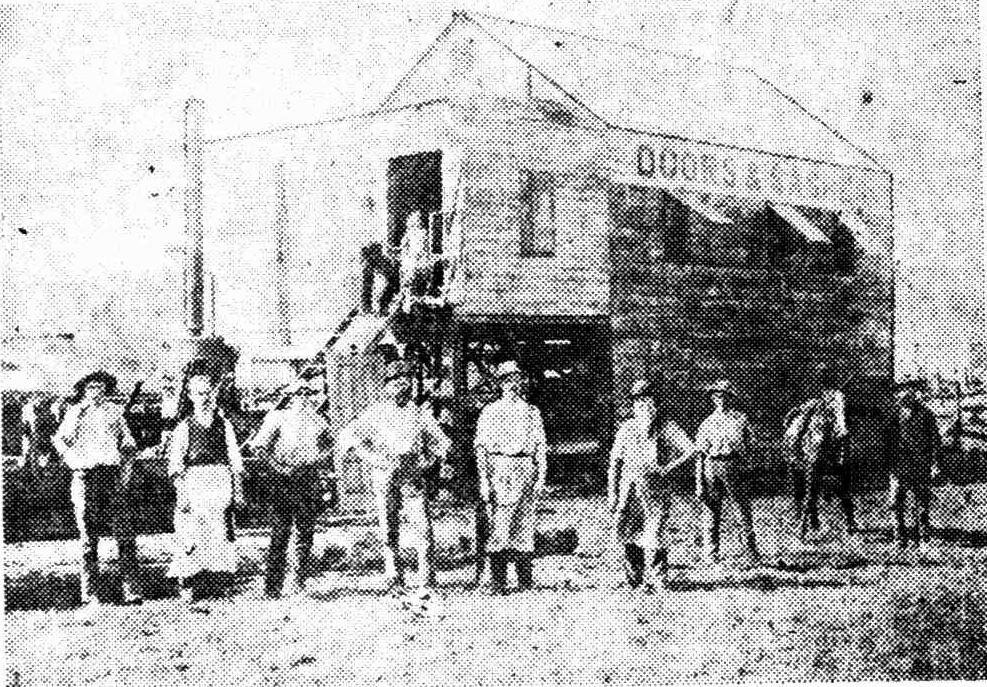
Forty-two years ago, in 1893, the manufacturing section of Brown and Jolly's business was conducted in a much smaller building than is used at present. The picture shows the building and some of the employees of the firm in the 90's.
GROWTH OF BUSINESS
Indicative of the growth of the business is the fact that there were two employees in 1881, when the weekly wages bill was £12. To-day there are 80 -employees, who receive in wages £20,000 a year. Money circulated in the district by the company amounts to £35,000 annually.
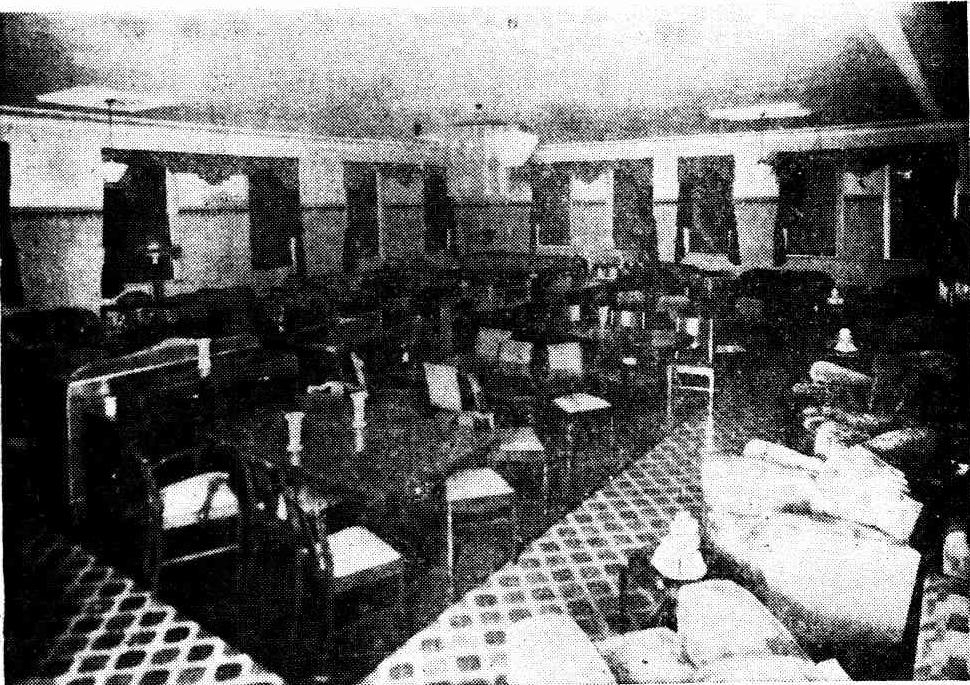
Section of the New Showroom at Brown and Jolly Ltd.
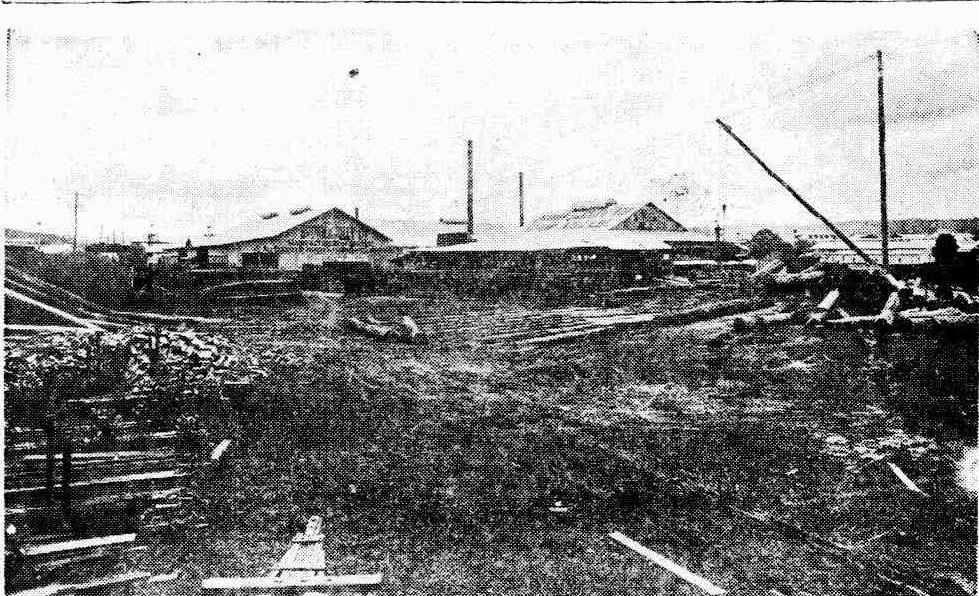
Brown and Jolly, Ltd., now control one of the largest sawmill and furnishing businesses on the North Coast. A recent photograph of the sawmill and factory at South Lismore.
A BUSINESS ROMANCE (1935, July 8).Northern Star (Lismore, NSW : 1876 - 1954), p. 5. Retrieved from http://nla.gov.au/nla.news-article225387522
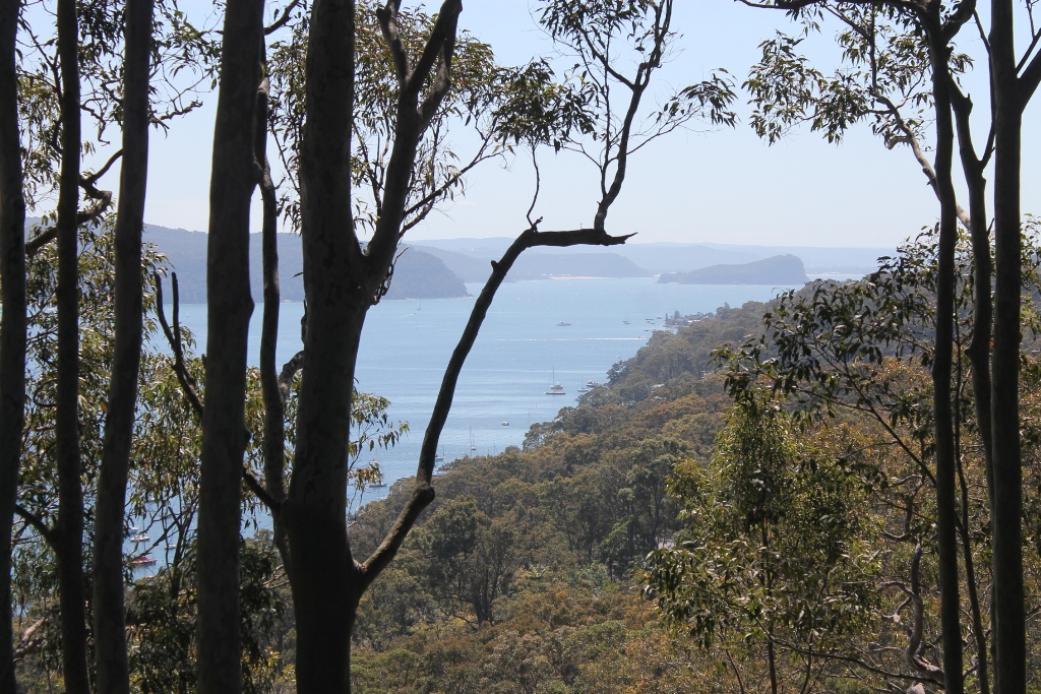
Hy-Brasil By Henry Kendall
"Daughter," said the ancient father, pausing by the evening sea,
"Turn thy face towards the sunset -- turn thy face and kneel with me!
"Prayer and praise and holy fasting, lips of love and life of light,
"These and these have made thee perfect-shining saint with seraph's sight
"Look towards that flowing crescent -- look beyond that glowing space,
Tell me, sister of the angels, what is beaming in thy face?"
And the daughter who had fasted-who had spent her days in prayer
Till the glory of the Saviour touched her head and rested there,
Turned her eyes towards the sea-line -- saw beyond the fiery crest,
Floating over waves of jasper, far Hy-Brasil in the West.
All the calmness and the colour -- all the splendour and repose
Flowing where the sunset flowered like a silverhearted rose!
There indeed was singing Eden, where the great gold river runs
Past the porch and gates of crystal ringed by strong and shining ones!
There indeed was God's own garden sailing down the sapphire sea --
Lawny dells and slopes of summer, dazzling stream and radiant tree!
Out against the hushed horizon -- out beneath the reverent day, --
Flamed the Wonder on the waters -- flamed, and flashed, and passed away.
And the maiden who had soon it felt a hand within her own,
And an angel that we know not led her to the Lands unknown.
Never since hath eye behold it -- never since hath mortal, dazed
By its strange unearthly splendour, on the floating Eden gazed!
Only once since Eve went weeping through a throng of glittering wings
Hath the holy seen Hy-Brasil, where the great gold river sings!
Only once by quiet waters -- under still, resplendent skies
Did the sister of the seraphs kneel in sight of Paradise!
She the pure, the perfect woman, sanctified by patient prayer
Had the eyes of saints of Heaven -- all their glory in her hair;
Therefore God the Father whispered to a radiant spirit near --
"Show Our daughter fair Hy-Brasil -- show her this and lead her here."
But, beyond the halls of sunset -- but within the wondrous West,
On the rose-red seas of evening, sails the Garden of the Blest.
Still, the gates of glassy beauty -- still the walls of glowing light
Shine on waves that no man knows of: out of sound and out of sight.
Yet the slopes and lawns of lustre -- yet the dells of sparkling streams
Dip to tranquil shores of jasper where the watching angel beams.
But, behold, our eyes are human, and our way is paved with pain,
We can never find Hy-Brasil -- never see its hills again!
Never look on bays of crystal -- never bend the reverent knee
In the sight of Eden floating -- floating on the sapphire sea!
Hy-Brasil: Avalon Beach - Pittwater's Summer Houses - Historic houses - threads collected and collated by A J Guesdon, 2018 - Revised with new materials 2023